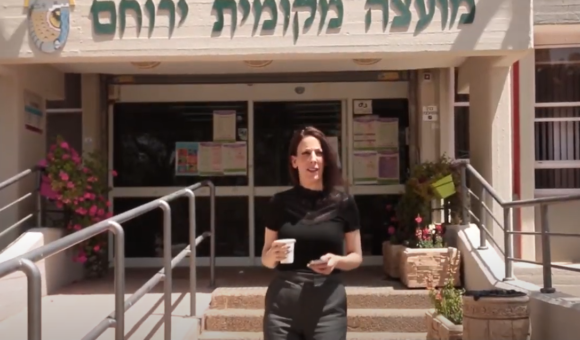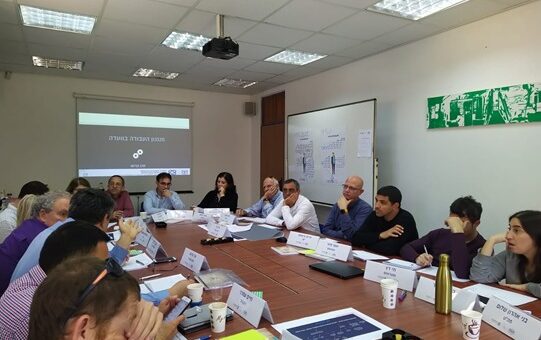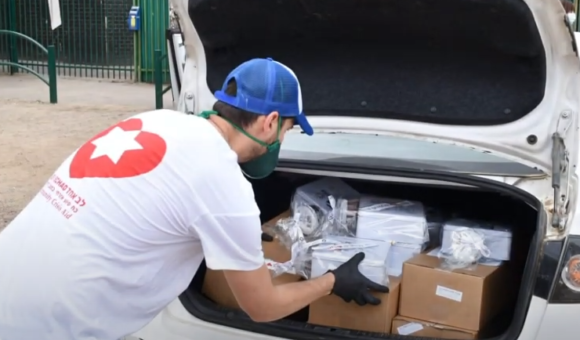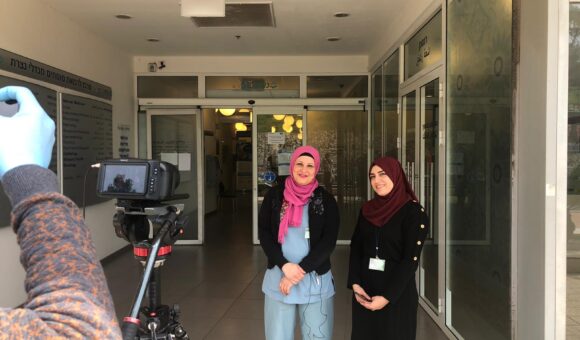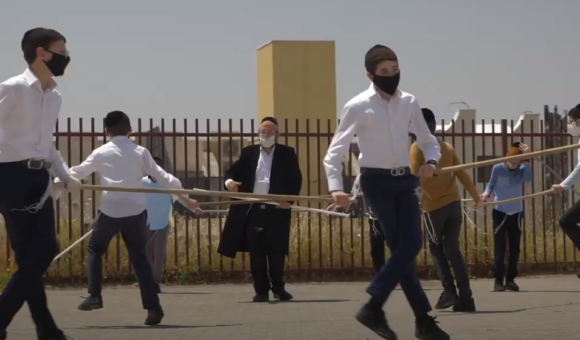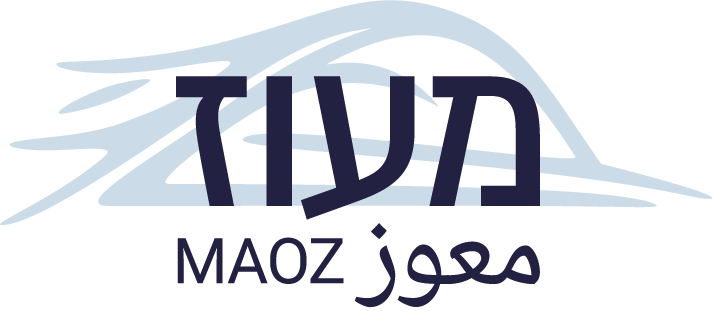
Spreading the light
the MAOZ Network members during the pandemic
Spreading the light
click on a photo to read the full story
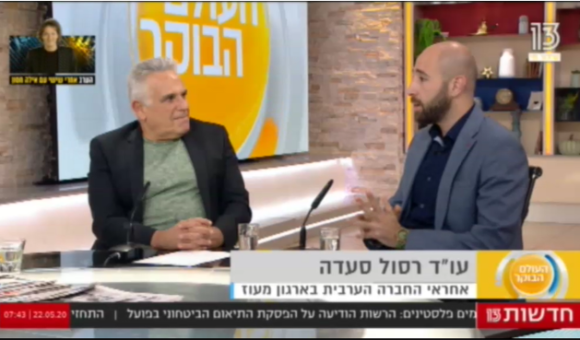


Increasing Trust Through the Media
Two groups in Israeli society have been particularly affected by COVID-19 and the media coverage they have received throughout crisis: the ultra-Orthodox and the Arab societies. MAOZ launched an initiative in collaboration with Network member Eitan Zeliger to improve media coverage
During the COVID-19 crisis, Israel’s mass media, which had previously ceded much of its influence in favor of social media platforms, once again assumed a central place in the public arena. The public approached mass media outlets in search of reliable information; decision-makers appealed to the public through the news, and ratings shot back up.
But when the public sits at home and receives its information from the media, everything that is presented becomes fact. And when the public and societal leaders are fed an unreliable snapshot of reality, decisions are made that do not match needs in the field, going so far as to even harm citizens.
Therefore, at the peak of the COVID-19 crisis, following the negative reports that the ultra-Orthodox were not adhering to the guidelines, the mayor of Ramat Gan announced the construction of fences between his city and the nearby ultra-Orthodox city of Bnei Brak in order to prevent residents from passing back and forth.
These two cities are so close to each other that one building may be situated in Bnei Brak while the one next door is already in Ramat Gan. The mayor’s extreme step did not have any health ramifications – the virus clearly does not stop spreading when it reaches a fence. However, the decision illustrated the public’s negative opinion of Bnei Brak in particular, and the ultra-Orthodox society in general.
The result was a huge crisis of trust between all the citizens of the State and the ultra-Orthodox society, and between the ultra-Orthodox society and the rest of the public and the media, whose work had instilled the public’s sentiments.
MAOZ Network members also felt that the reduced trust harmed them even more than the COVID-19 consequences themselves. As an ultra-Orthodox Network member said then: “I admit that in recent days I’ve already thought about the value that trust, which is engraved on MAOZ’s flag, has if not for a situation such as this. And I thought it would be better not to write in Whatsapp groups, as doing so would be a waste of time. I admit that I felt this way”.
And with that, the Cornerstone media initiative was launched with the aim of changing the coverage and public opinion towards the Arab and ultra-Orthodox societies. This was carried out through media exposure, in which we promoted COVID-19 heroes and shared stories about the ultra-Orthodox and Arab societies.
The initiative was led by MAOZ, in collaboration with Network member Eitan Zeliger, who owns and runs a public relations firm. The main and active partners in the initiative were the Arab and ultra-Orthodox Network members; they provided potential ideas and interviewees, with some even being interviewed themselves.
During its three months of activity, the initiative produced 25 published and/or broadcasted news segments about the Arab society. One of the initiative’s focuses was on Arab interviewees, and it included a series of interviews about Ramadan, which had previously been almost completely absent from the Israeli media.
31 positive news segments with ultra-Orthodox interviewees were also published and/or broadcasted. They delved into the effects COVID-19 had on the ultra-Orthodox society’s daily life, including the impact on businesses and students’ return to school.



20 Years Later – Pulling the Industrial Park Out of the Mud
1.5 billion shekels. That’s the price the residents of Gezer, Modi’in and Ramla paid for the lack of cooperation between the municipalities. Now, Gezer Mayor Rotem Yadlin is trying to change that
“I’ll begin by saying this is a moving occasion for me. As far as I’m concerned, today we are changing direction, making a fresh start, building our future. After 20 years of paralysis, we are embarking on a new path – a path of growth. All of the forces on the ground are joining hands to work for the mutual benefit of our communities of Gezer, Ramle, and Hevel Modi’in.
When I first began as my term as Mayor of the Council, I surveyed the territory zoned for the Ramla-Gezer-Hevel Modi’in Industrial Zone. All I saw were ploughed fields and a lone tractor. As far as I was concerned, that tractor was ploughing the future of Gezer, its potential and that of Ramla.
Over the past decade, the local authorities lost a combined total of 1.5 billion shekels in property taxes. That’s one-and-a-half billion shekels that belong to the residents of Gezer and Ramla. That’s money that should be going to our schools and our infrastructure. Those taxes represent services that ought to be going to our residents, and they’ve been lost. This is a tremendous loss.
Today we confirm the end of this age of conflicts between the different local authorities and the beginning of a decade of joint investment to collectively boost this region.
So what does that mean? How did we do it? We simply stopped fighting.
We ceased quarrelling over who owns this or that piece of the pie. We threw all of the problems into the pot, and instead of talking about each issue separately, we discussed all of the issues together. We brought all of the problems to the negotiating table in order to create a comprehensive outline for a solution. This is what we are presenting to you today.
All this allows us to create a whole that is greater than the sum of its parts. A win-win situation. Today Gezer and Ramla are taking a leap forward together.
We are marching towards a decade of joint endeavors. Today, we will approve the collaborative development of the industrial park, which is the flagship project of the Central District – 30,000 jobs stretching across 2,161,566 square meters of construction permits. All of this immediately translates into property taxes totaling NIS 60 million for Gezer and NIS 90 million for Ramla. Whichever way you look at it, we’re talking about a serious growth engine. We’re promoting Gezer and Ramla and getting ready for take-off – in employment, transportation, and infrastructure. I see this as a joint decision to work together for the general good of the entire region.
This council meeting is just one step of the process; a lot of work and stages remain in this collaborative effort between Ramla, Modi’in and Gezer. We’re sowing seeds for years to come. This is our duty in local government, to plan and do whatever it takes to fulfill the vision.
When Everything Else is Uncertain, My Job is to be My Residents’ Rock
For Tal Ohana, Mayor of Yeruham, the pandemic was a crash course in leadership. She came up with creative solutions, took brave decisions and found new opportunities
“I’m Tal Ohana and I’m 36 years old. I was born and raised in Yeruham and I’ve been involved in local politics for about a decade.
While serving as Yeruham’s foreign leader for over a year, I handled strategic actions that dictated social, economic and educational resilience. The COVID-19 crisis was what ultimately transformed me into a leader who is very connected to her residents.
I informed each confirmed COVID-19 patient that he or she had been infected before the relevant authorities did. I didn’t want to wait. I did it in-person in order to ensure that they would be at home, where they wouldn’t be able to infect other city residents. I wanted to make sure that they had everything they needed for the isolation period. It wasn’t easy.
I had one conversation with someone who had potentially been infected and therefore had to undergo a test. It was five minutes before Shabbat. I keep Shabbat, although that hasn’t been too true lately. And she told me, ‘I’m not letting these testers into my house until you arrive.’ This sentence made me feel that at the end of the day, I am responsible for to each resident’s personal sense of security.
My role and responsibility towards the residents has accompanied me throughout this period, especially when it comes to trust. It was clear to me that during this crisis, when my residents were in a constant state of anxiety and uncertainty, I had to instill in them a sense of trust. My job is for them to know and feel that their city is being managed; that things are under control. That we’re operating, on top of things, and here for them. This is what increases their resilience and ultimately bolsters our resilience as a municipality.
I think this is something I’ve learned and I’ll hang on to it during both the emergency routine and the general routine.”
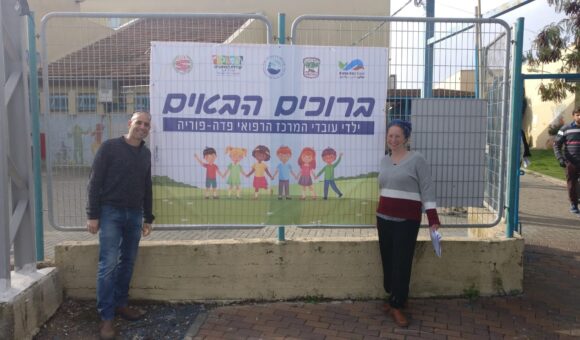


The Solution that Brought the Medical Staff Peace of Mind
Immediately after the coronavirus outbreak, as healthcare teams faced increasing stress and concerns, educational frameworks were set up for the children of medical workers in Northern Israel thanks to a special collaboration in the Network
With the onset of the coronavirus pandemic, medical workers found themselves on the front lines. They were able to cope with working round-the-clock in conditions of uncertainty and with insufficient protection. But they faced an additional challenge that made it hard for them to focus on their professional duties, which were already intensive, difficult and tense enough: the closure of the school system and the ban on seeing family members that left no solution for their children, who were home alone during the shifts of these most essential of workers.
In response, the healthcare system, education system, and local government tried to bridge the gap. At the same time, there began a focused and rapid collaboration between two members of the MAOZ Network: Hagar Mizrahi, the former Acting Director of Poriya Hospital, and Eli Meiri, the CEO of the Kineret Amakim Cluster.
They had not met each other before, but belonging to the MAOZ Network opened the door and paved the way for them to produce a quick, focused, and meaningful solution for medical staff’s children.
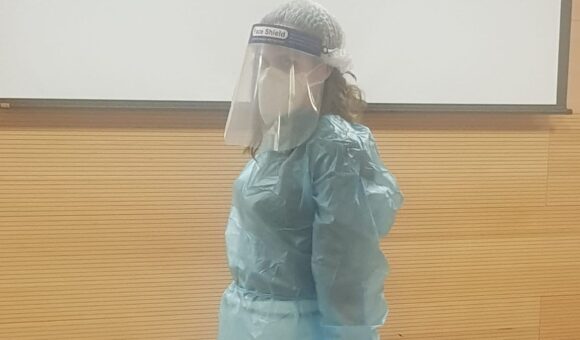


There’s a Bright Side to Testing Positive
When Riki Siton tested positive for COVID-19, she mainly felt alone. Before the Bnei Brak resident even understood what was happening, she was in a taxi on the way to a hotel, where she would isolate. Now that she has recovered, Riki’s mission is to help other infected patients feel less alone
I tested positive.
It happened on the first of the month of Elul. It’s a day filled with excitement in the ultra-Orthodox society, as children begin a new year in their educational frameworks and we, the parents, get to have some time for ourselves. The first free moment I had, I asked myself how I was feeling. And the trust was that I didn’t feel too well.
I picked up the phone to the doctor, received a referral for a test and tested positive for COVID-19. Thoughts began swirling around my head: how did this happen? Who did I meet? Who did I infect? How many people will have to quarantine because of me? How will the 11 of us quarantine within four walls? Do we even have enough food? (The answer by the way is no. Quarantined children at home are insatiable).
The whole family began quarantining together and everyone was tested. Some had even managed to be infected. Then the phone rang. “Go to a hotel; it’ll reduce the infection,” they said.
I had a lot of questions: What is this hotel? What does it look like? Can I take my daughters with me, even if they’re not infected? How will I do laundry? Is there enough food there? There were almost no answers. They just told me that they’d be by to pick me up in half-an-hour.
I remember feeling uncertain on the minibus ride to the hotel. Once I got there, I met many other families feeling the same distress and uncertainty – in the entrance, registration, hallways and in between the rooms.
When we got home, my phone was filled with phone numbers of the people I met. We started a WhatsApp group “COVID-19 Hotels” and people started adding more and more people themselves. Groups of hotel “graduates”, patients on their way there, and also those who are currently at the hotels also opened.
Tips, recommendations and questions – it all flowed in the group. We even wrote the “COVID-19 Guide for the Beginner”.
But then I realized that something else had happened here: we had created a special group of COVID-19 patients who had recovered, and maybe something else could be done. So I opened a new WhatsApp group called: “Recovered COVID-19 Patients Volunteer.” I asked them if they’d like to volunteer and whether they’d like to use their advantage for good.
When a lot of people showed interest, I went to hospitals. I asked them if we could help them at all – we, the recovered COVID-19 patients. When someone is hospitalized in the COVID-19 ward, family and friends can’t visit him or her, and the loneliness only adds to the fear of the disease. Support is a must.
It isn’t easy to create a group of volunteers in the hospital, and it usually requires a lot of bureaucracy. But because of the period and the opportunity, we were able to move things along quicker. And just like that, 263 volunteers arrived (in full protection) or are waiting to be sent to hospitals.
In one of my conversations with the hospitals, I spoke with Network member Sefi Mendlovic, VP of Sha’are Zedek. “Do you need volunteers who have recovered from COVID-19?” I asked. “Yes, and we already have a lot of ultra-Orthodox volunteers. If, for example, we had more volunteers from the Arab society who could speak to those who are hospitalized in Arabic, it’d be a great help. “
I picked up the phone and called MAOZ. Within a few hours, we created a questionnaire looking for Arab patients who had recovered from COVID-19. The Arab society then also began moving things along on their own and we have quite a few Arab volunteers.
In this difficult time, this is what I think makes all the difference. Right now, when everyone is busy with earning a living and maintaining one’s strength and health, we can mobilize forces from within.
We’ll get through COVID-19, and I really think it’s going to be thanks to working together.
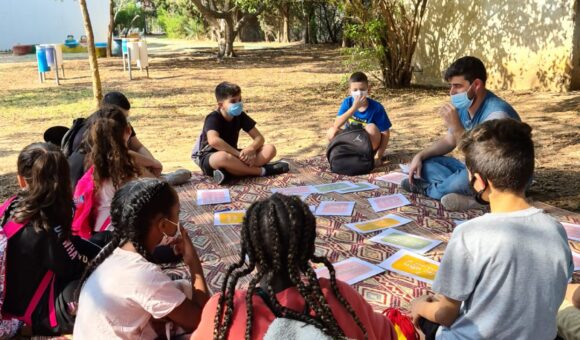


We Turned the Entire City into One Big School
Students learn at the park, the river, the museum and the beach. Osnat Saporta, VP of the Hadera Municipality, and Shlomi Dahan, Director of the city’s Education Division, tell how they realized, before everyone else, that the current school year must be conducted outdoors
“When we started planning for this school year, we realized that it was going to look different. Last year, just before the school year ended, we invited the educational staff, principals, parents and students for a consultation. We looked at the months that had passed and we thought about the coming months.
We heard one clear-cut conclusion from the distance learning experience and a request from them: Don’t let screens replace personal, social and educational encounters.
So together we broke out a new educational model, adapted to the spirit and the demands of this period of social distancing. The model enables learning to take place not only on screens at home and addresses the fact that schools do not have enough space to meet the requirements of social distancing.
We turned the whole city into a school, a complete learning space – the urban park, Hadera river, the beach, the museums and the city streets – they all provide space for city students to continue their education and learning routines. We believe this effort will be copied by other localities; it’s a joint effort by all of us to find the way to be here for our students – face to face.”
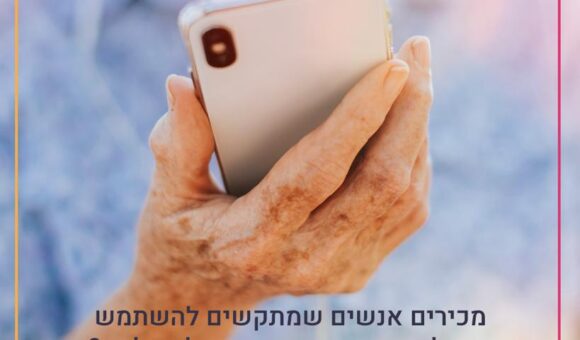


Amdocs’ High-Tech Workers COVID-19 Hotline
Overnight, banks, municipalities and others shifted their call service centers to the internet. But what are older people, many of whom lack the necessary technological orientation, supposed to do? Gali Shachar Efrat had them in mind when she established Amdocs’ employee-run hotline
“When the COVID-19 outbreak began, the call center we had opened at Amdocs collapsed.
It had only opened a few days prior, following a post I had read in a Raanana residents Facebook group. One of the elderly residents wrote: ‘My bank branch has been closed and I have no idea how to work their digital app. Can anyone help?’
As a member of the Raanana City Council, there was nothing I could. But I realized that my job at Amdocs provided us with an opportunity to intervene.
Within a few hours, Harel Givon, our Division President and I sent an email to all Amdocs employees, saying: ‘Amdocs is setting up a virtual hotline to support residents who have difficulty dealing with technology. Your knowledge is an asset to them. We would be happy if you would like to take part.’
We then contacted the residents through the Raanana Municipality, other local authorities, NGOs, aid organizations and the Ministry of Social Equality.
We sent 8,000 messages to all residents over the age of 65: ‘Do you have a problem connecting to Zoom or having a video call with your grandchildren? Amdocs has opened a call center to help you out.’
We weren’t expecting to receive so many reach-outs, and our hotline initially couldn’t handle the load.
But this was also a key moment for us, as Amdocs employees enlisted en masse and our Digital Friends initiative was born.
I’m old and new at Amdocs at the same time. I recently returned to high-tech after working in the social sector for years. When I first returned to the office, one of the managers approached me and asked, ‘Will you teach us about the social world? What should we do differently?’
I’m not sure he understood how seriously I took his questions.
Amdocs has always seen itself as a leader in corporate responsibility. We feel we’re frequently giving a lot back to the community: painting schools, packing food baskets, etc. There’s no doubt that all this work is truly significant.
But I’ve always asked myself: why don’t we contribute the thing we know to do best to the community? We’re a leader in the production of digital solutions – this is what we need to give back to the community.
I didn’t know where to start, but then the biggest opportunity I could have imagined arrived: COVID-19.
The first event we took part in as part of the Digital Friends initiative was Memorial Day.
Thanks to MAOZ Network member and then-General Manager of the Israel Association of Community Centers, Raz Frohlich, we realized that entire families were planning to hold this year’s commemoration ceremonies on Zoom. Their great desire to share the most precious thing of all – stories about their fallen loved ones – hit a bump in the road when it became apparent that most people lacked the necessary technological knowledge and familiarity with the required platforms. This is where we entered the picture.
Everyone who contacted our hotline received close accompaniment: 200 volunteers accompanied families throughout the process – from the scheduling stage until the end of the evening. We wanted to help families socialize with their loved ones rather than mess around with technological issues.
We received hundreds of responses from families and participants.
But the most surprising responses of all came from our own employees, who didn’t leave the calls until they had all ended.
That night, at the end of a long day, I sat on the couch and began reading the reactions of all the employees who had volunteered at the hotline.
‘Personally, this a very difficult day for me because of my experiences. But this time around, I experienced it in a moving and different way,’ one of the employees wrote me.
I couldn’t help but cry.
I realized that at a time like this, when our employees themselves faced such uncertainty, we were able to create a sense of meaning for them. They were part of the solution for thousands of people, and they drew a lot of power from the experience.
The COVID-19 crisis has shaken us all, even in the high-tech world. But for us at Amdocs, this has also been a year with a big bright spot, at the end of which we have emerged with a new understanding of the role the business sector plays in Israeli society.
We can be much more than a place of employment, and we can also contribute more than packing food baskets. We can help the community deal with technology, and we will instill this perception in our business thinking moving forward.
And the hotline? It’s still running, and you’re welcome to refer us to people who need some help. 200 Amdocs employees are waiting for them, ready to make a social change.
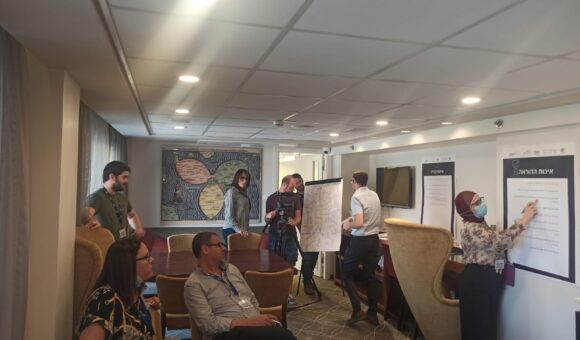


Learning Hebrew in East Jerusalem Requires Partnership
Learning Hebrew can open doors for children in East Jerusalem. But for some of them, Hebrew comes with negative political and historical connotations And others simply do not have the opportunity to practice the language in their environment. That was why members of the MAOZ Network from the Ministry of Education and the Jerusalem Municipality led a joint trip to solve the puzzle of how to work together and bring about a revolution that could improve the children’s lives
What is the difference between a child living in East Jerusalem who learns Hebrew and one who doesn’t? Opportunities. The language opens doors and paves paths forward. A child who learns Hebrew increases his or her chance of finding employment in the Western half of the city as a teenager or an adult, and he or she will be able to go on to universities and colleges upon finishing school. And even before then, in activities and trips to the shopping mall, a child who has learned Hebrew will have access to the language that surrounds them. That is what guides us when we talk about learning Hebrew in East Jerusalem.
For this reason, the Ministry of Education and the Jerusalem Municipality are working to implement a comprehensive program to teach Hebrew in East Jerusalem. It’s a complex and sensitive mission.
Do the children want it? The parents? Is there a price to learning Hebrew for the children of East Jerusalem? And how do you bridge the gaps and overcome the obstacles? Is there any way to know if it’s being done right?
Behind the scenes are two separate organizations charged with this mission, which include a number of Network members among their ranks: Yaffa Yashar, Regional Coordinator for the Jerusalem District at the Ministry of Education; Lara Mbariki, Head of the Arab Education System in the Jerusalem Municipality’s Education Department;
Yoav (Zimi) Zimran, Deputy Director Jerusalem Education Authority, and Zion Regev, Head of the East Jerusalem Five-Year Education Plan.
In August, the Ministry of Education and the Jerusalem Municipality set out on a joint trip to begin work on two missions: the first was to identify solutions for teaching Hebrew in East Jerusalem, and the second was to create a successful working infrastructure for the two different yet complementary organizations so that they could work together.
One of the participants on the trip spoke about the complexity of learning the language and using it as an adult: “When I came to Tel Aviv, I worked in a restaurant on the ground floor of the shared apartment I lived in. Someone asked me for a keisam (a toothpick). I remember standing in the kitchen of the restaurant, looking up, down and to the sides. I felt lost. What is a keisam? I learned Hebrew standardly, and yet still when it came to the moment of truth – I was helpless. What is a keisam?”
At a consultation meeting with education officials from the community, one educator made a request that doubled as a statement: “You have a responsibility to find ways to improve on the way things have been done so far.”
“We see how other languages are taught, and what the motivations, challenges and opportunities are. We need to take it back upon ourselves so that we can see what we’re doing wrong, as well as right,” another participant added.
“If we learn to harness the power of working together on the challenge of teaching Hebrew, it might serve as a pilot for other programs that we’re working on together,” one of the trip’s participants concluded.
Following the trip, the participants set out to plan a series of experiments and trials in language teaching, with each taking charge of a different aspect in order to better understand the needs of the education system and the students and how best to teach the language.
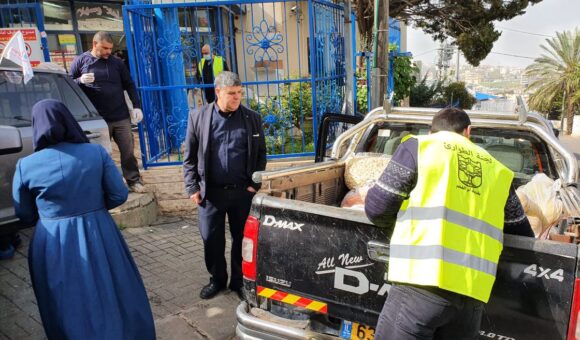


We Hit Rock Bottom. Only Then, We Understood What’s at Stake
The second COVID-19 wave came in the middle of the wedding season, and Dr. Samir Mahamid, the Mayor of Umm al-Fahm, found himself calling dozens of newly-infected people every day
“When I first became the Mayor of Umm al-Fahm, I received an offer to participate in a special training course in the U.S. to prepare for emergencies on the municipality level. The vast majority of Arab municipalities didn’t understand the need. In Arab society, emergency situations seem irrelevant since during wartime, we’re not a part of the story.
But I decided to go. And I already realized then that our main problem in routine times would become much greater in times of emergency; that is, our inability to work in synergy in and amongst ourselves. Every department and every organization in our city works alone. No one sees the next door neighbor who may be doing the same as you or building on your work. I didn’t know how to approach such a complex issue, how to make clear how much we’re missing when everyone sees only their small part. Then COVID-19 happened.
It’s now been exactly two years since I became Mayor of Umm al-Fahm. I’m not originally from this world – I’m not a politician. I’ve worked in education my entire life. I went through the whole track from teacher to principal to mentoring principals. I decided to run for mayor because I felt that our city deserved different leadership. When I won, I sat down and started learning everything from scratch. What a municipality is, how to make decisions. We had an 80-million-shekel deficit. I started with damage limitation, understanding which things we could deal with and what could wait.
When the first wave of COVID-19 hit, we Arabs proudly proclaimed that it hadn’t reached us, that the Jews were the only ones getting infected. Even the outbreaks in Umm al-Fahm were as a result of meetings with Jews, and we managed to keep them under control very easily. We acted fast, closed mosques and collaborated with religious leaders. We asked residents to go into lockdowns and they listened.
After the first wave, the entire country relaxed a bit. We felt that we’d beaten COVID-19. The problem was that this lax behavior came precisely during the Arab wedding season, and the combination of the two resulted in an explosion.
It’s important to understand: weddings for us are events on a different scale than in Jewish society. We plan them one or two years in advance. So when I tried to convince people that they couldn’t have weddings now, that it’s a matter of life or death, I couldn’t get it across. We handed out 5,000 shekel fines, but organizers just calculated it into the budget as another wedding expense.
I felt I was losing control of the city. I was receiving reports every day and calling all the new patients in the city. By the end of August, we had 1,000 active cases, meaning dozens of phone calls each day.
I wrote a letter to Professor Ronni Gamzu and the Minister of Health. I asked them to open wedding halls, now of all times. We can control wedding halls and we know exactly who to penalize. But when weddings are held in people’s private courtyards, we don’t even have legal grounds to enter.
My request went unanswered. But one day they called and told me that Professor Gamzu and police chiefs are coming to visit the city. They expected me to scrub my office clean and take them to a community center that was handing out food packages. But I decided to use the visit to show them what was really happening on the ground. I took them to a wedding. They went in and were shocked. They couldn’t believe how disconnected the situation on the ground was from their instructions. At the end of the visit, Professor Gamzu came to me and thanked me. He said: “It was like being punched in the stomach”.
Now while we didn’t have many cases during the first COVID-19 wave, we were hit hard financially. We brought MAOZ in to accompany us as we worked with the small businesses in our city. We sat with them for the first time around the same table. We realized how many people the owners were keeping afloat, and we thought of ways to help them. All of the Municipality’s departments worked together guided by the data. My dream of working on our internal interfacing started picking up steam.
During the second COVID-19 wave, things looked different. We were a red city, so we started receiving help from all kinds of places. I went into a meeting with the Minister of Defense and came out with a promise to receive massive subsidies. We received money for epidemiological trackers, for food packages, for neighborhood coordinators and for public service announcements. We made many videos, one of which made a particularly big difference: we made a video of one of the residents who had lost his wife to COVID-19. He spoke from the heart and it had a significant influence in Umm al-Fahm and in the Arab society in general. The most dramatic moment, the one that made us all wake up, happened on September 1st. We watched the entire country go back to school while we were the only ones staying at home. It made people understand the situation. And us? We explained that it doesn’t have to be this way; that it depends on us.
I think that was the turning point. People started being more careful and they attended weddings less often. They began realizing that their actions have consequences. When we went back to school after the second lockdown, the first thing I told residents was that it’s thanks to them. We worked hard, we fought the virus and it paid off.
At that time, MAOZ started working with us again, and the main value we received from the process was the ability to disconnect from our desks and work together. What made the difference was not the information we received but the opportunity to work on our internal interfaces.
When I look at the brainstorming, the dialog and the way we listen to each other now—things that were missing before COVID-19—I think that with the right work, the virus can be a great opportunity for us all.”
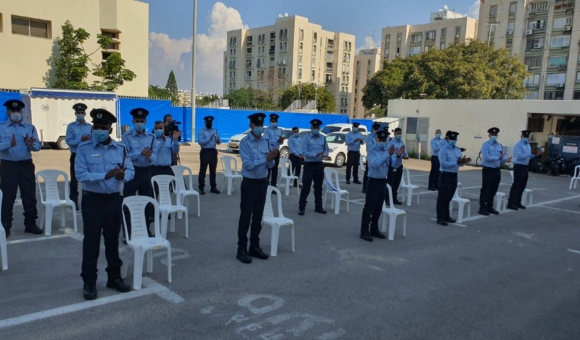


The Young Bedouins Who aren’t Afraid of the Police – They Serve in it
Tent by tent, village by village, Yaron Matas went to convince young Bedouin to enlist in the police force.He’s convinced that
this is the way to create trust between the police and the Bedouin community in the Negev
“How many Muslim police officers are there in the Israel Police? And how many officers? And how many of them are Bedouin? This was my first question on my first day when I entered my new position as Deputy Director of the Administrative Division for Arab Society in the Israel Police, a division that was established to increase the Arab public’s trust in the police.
And here is the answer: approximately 3% of police officers and a minority of them are Bedouin from the south.
20% of the society but only 3% of the police force. It’s a little strange that we are talking about trust isn’t it? How? In what areas? On what basis?
We sought to find out the reason and we sought to focus on the Bedouin community. Why aren’t there Bedouin police officers in the force? Obviously, it’s complicated. There’s a story of identity here, a story of trust but also a big story of language. For people who don’t speak Hebrew, it is difficult to get any kind of job, let alone serve in the police force.
So, we decided to try to do something different – if its impossible to apply for a police officer job, we will build another step in the path: a preparatory program. We thought that if we created an intensive framework to teach language, we could create an effective springboard for police candidates. But how would we recruit candidates? A Facebook post was not going to solve the problem here.
So, we went tent by tent, family by family. We told them about the idea, we made the offer – come to the preparatory program and you will be able to have a position with us in the police force. And if not, maybe in the prison service? The fire department? Sometimes these are more accepted in the community.
When meeting one of the families, the father told us that language is the biggest barrier – and we realized we were on the right track. We saw how he was thinking ahead when he said that he dreams about his children’s future.
*We received 700 resumes. * In a selection process we chose 65 of them who began the preparatory program. We promised them it would be difficult – and we kept our promise. Intensive around the clock training that received a “bonus”: the coronavirus pandemic. We turned the learning routine over to them, and we helped them with solutions like computers that made it possible.
The preparatory program ended. Nearly 50% of the participants completed it successfully – and are enlisting in the police force. And what about those who didn’t? We have responsibility toward them. We called, we offered, we recruited them. We believe that with the knowledge and skills that they received in the preparatory program; they are suitable for the labor market. In cooperation with the Israeli Employment Service we are helping them find suitable workplaces.
When I stand at the ceremony, in front of 26 new Bedouin recruits, I am greatly moved. I look at each one of them and know that not only has he gone through a process to be here, we have too. At one of the entrance exams, he was almost rejected. The selection staff gave him a task: there’s a burning building and citizens are not allowed to enter. So, he grabbed the “citizen” and did not let him pass. He pushed him against the wall. On the task report it was written: displayed violence. That was the moment that I realized the change we need to make in the police, it’s not only diversity. It’s also what the diversity brings with it. It’s learning the story behind the people. Behind the way of thinking. Behind the statistics. We went back to the officer staff and explained to them that from his point of view he executed the task – and did it completely. It’s true, it’s not acceptable but is it possible to explain what is and isn’t permissible? To explain how? I believe it is.
And I am not the only one. That same young man, who is today a police officer, stood before me at the ceremony. With 25 other new officers in uniform. The calls from district commanders in the police force have not stopped coming, everyone wants these recruits in their district. This is clearly an opportunity for change. It’s clear that there’s an important force here, and that there’s willingness to adapt the system to accept these officers.
In a few months the second cohort of “Youth for a Secure Future” is starting. It’s not surprising that we encountered budgetary problems in funding the program. Thanks to connections to the Network, I was able to turn to the Ministry of Finance, the Ministry of Public Security, the Ministry of the Economy and the Welfare Ministry – to present the program and to request that they direct resources to it. And this succeeded. I received full cooperation from the Network members who connected to the idea and helped realize it.
I am waiting for the next ceremony. To see another new row of police officers excited, belonging, who return to their families with a sense of responsibility, who feel the role accompanying them and what it means to be a personal example. I know that they are our partners in the task.
And I believe – that if we are here to increase trust, the first step is in getting to know each other and connecting. From there it will be possible to create “another reality.”
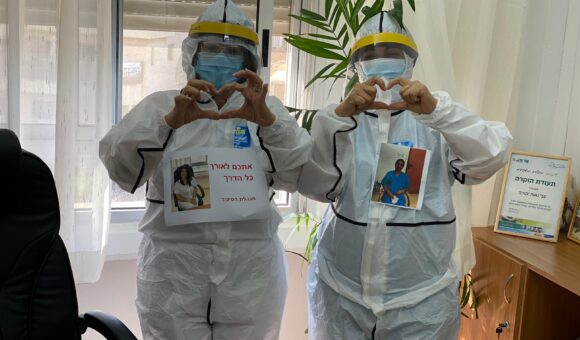


How Hazmat Suits Created Solidarity in the Hospital
Not the quarantining nor the health concern. Dr. Ina Shugayev, Director of Haifa-based Fliman Geriatric Center, realized that the real danger posed to her staff was the feeling that they were alone even inside the hospital
“It was at the beginning of an evening shift. One of the nurses in the new COVID-19 ward we had opened came to work after a few hours of time at home. ‘Afraid of me? Do you think I’m contagious?’ she asked.
The staff members in our COVID-19 ward, like the other COVID-19 wards in the country, had been instructed that they were forbidden to walk around the rest of the hospital. They had to adhere to the hospital’s pods.
I didn’t know what to say. How can I face that nurse and try to explain to her that going home to see her family and the children is fine, but that at the hospital, she can’t hop over into another ward? If we trust the preventative system that ensures us a routine outside the hospital, why can’t we act the same way inside it?
At that moment, I made a decision. If the COVID-19 ward staff is allowed to go home, they’re also allowed to wander between hospital wards and congregate in common areas. It was not an easy decision, but as a manager, I knew I was responsible for the resilience of the teams who were working so hard.
The month the pandemic began was also my first month directing the hospital (I initially served as deputy for a short period). We opened the COVID-19 ward at the beginning of the crisis. It wasn’t required for a rehabilitative hospital to open a COVID-19 ward. Many of the operations in the ward are conducted remotely, but can anyone imagine treating a rehabilitative and geriatric person remotely? Feeding them remotely, or supporting the patient as he or she walks down the hall?
So our team felt refreshed handling emergency care; we put on hazmat suits, worked in shifts and kept doing what we know to do best: provide dedicated, personalized care. The Ministry of Health’s guidelines restricting family members’ visits created anxiety among my staff: how would they maintain their patients’ moods?
So I decided to allow visits, refining the guidelines. I trust that the families who come will do their best to not infect their relatives.
We cared for patients. But who will take care of the medical professionals? When MAOZ called to ask if we needed help strengthening the team’s resilience, I realized this was our mission. In examining our resilience index as a hospital, we were in a pretty good place. But my heart skipped a beat when I thought of one disturbing factor: a relatively low score in the dimension of support and solidarity.
The staff in the COVID-19 ward signaled that they felt separated and alone; that the hospital didn’t see them. They felt disconnected from the rest of the hospital, and the rest of the hospital felt disconnected from them. That was enough for me to understand that action had to be taken.
We decided that for two hours, all the hospital staff, no matter what ward they belonged to, would have to work with full hazmat suit protection. Just like the COVID-19 ward staff does every day.
The very next day, all hospital wards started the work day in full hazmat suits: the medical staff, the nursing staff, the support staff – and me. We asked everyone to take a photograph of themselves in their suits and share how they felt. They felt hot, clumsy and stressed; even the air conditioner didn’t help. But the message was clear: we’re all in this boat – not just one department. And we can’t allow ourselves to forget that.
The other benefit of this experience was that suddenly, the hospital workers realized that the simple cloth mask they had been required to wear at all times is nothing compared to a full hazmat suit; in fact, it was barely noticeable.
With this small step, we all disconnected for a moment from our personal difficulties, and we were able to think of someone else and identify with his or her difficulties
I can already imagine the day after COVID-19: we’ll return the hazmat suits to the closets; maybe we’ll even take off our masks. Only one thing will remain: a team that managed to produce solidarity in a difficult time. And this sentiment will stay with us, even for the challenges ahead.”
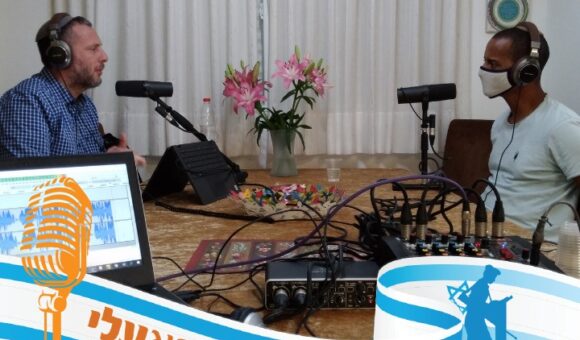


The Reflection That Began Atop Mount Sigd
Only in Ethiopia, during a trip with the MAOZ Network, did Lior Shtul, CEO of the Bnei David Institutes, realize that the Israeli story he knew was incomplete. Since returning to Israel, he has seen it as his duty to tell the missing story of Ethiopian Jews
“I remember that every year, during the white storks’ migration period, my father would raise his hands to the sky and ask the birds: ‘Is Jerusalem doing well?’ Shalev Wobo, one of the graduates of the Bnei David yeshiva I run, told us recently. He immigrated from Ethiopia with his family at the age of seven, explaining that ‘We longed for Jerusalem. It was a dream that we thought of every day.’
This is the first time we are telling the story of Ethiopian Jews to our students. This year, I realized that the Israeli story they currently have is an incomplete part of the greater Israeli mosaic, and we are starting to try to complete it.
I’m the CEO of the Bnei David Institutes. I have hundreds of students and thousands of alumni who currently hold key positions in Israeli society.
As a MAOZ Network member, I have participated in all the trips MAOZ has offered. My first trip was to Poland. It was a special experience, but one of the things I remember most is that even Network members whose ancestors were not from Europe experienced the journey as part of their own personal stories.
That’s why I decided to join the trip to Ethiopia – to get to know a story which I had felt was not my own.
I admit that before the trip, I thought I knew the story of Ethiopian immigrants. I thought that the State of Israel played the part of the hero by bringing the Jews of Ethiopia to Israel.
From the moment I arrived in Ethiopia, I realized that everything I thought I knew was simply untrue. For example, while I imagined the country as a dry desert, I found it to be amazing in its beauty. I thought I’d hear stories of heroism about the “rescue” of Ethiopian Jews – but I learned how for years, they had prayed to get to Jerusalem, and all about the long journey they took to get there. I thought that Mount Sigd was one mountain, but I discovered that each community simply climbed the highest mountain closest to it.
When I reached the summit of Mount Sigd myself, I felt something new. I felt a special experience, and at that moment I realized that there’s an untold story here. And so since returning to Israel, I have decided to start telling this story.
For years, there was hardly any mention in Israel of the holiday of Sigd. At most, we wished Ethiopian-Israeli students a happy holiday. But this year, we’re turning a new leaf. I want the students in our institutions to know the story of Ethiopian Jewry not as the story of another community, but as their Israeli story. And it was important to me not only that we celebrate the holiday of Sigd, but that we understand the meaning behind it.
A few months ago, we decided to set up a Bnei David podcast program, hosted by Netanel Elyashiv, an educator at the yeshiva (and a MAOZ Network member). This year, leading up to the Sigd holiday, I told my team that ‘there’s a story we have to tell.’
Shalev Wobo, our graduate, who immigrated from Ethiopia at the age of seven, agreed to share his fascinating story with us. He told us that Sigd is an opportunity for reflection. So this year, we’re also reflecting a bit on how we’ve told the story to date, and how we will tell it moving forward.
Unfortunately, our students will not climb Mount Sigd this year. They won’t experience it on foot like I did. But hundreds of students and alumni who have heard the podcast have heard a new story. They’ll continue learning about the Ethiopian-Israeli identity, as well as learning that these people are our heroes.”
It All Began with a Trip to Finland. Now it’s Changing the Job Market
A training program that will reduce the mentoring time needed for new employees, high-quality recruitment for Arab students These are only a few of the experiments with the potential to enhance economic productivity – made possible thanks to technical training reforms led by Tair Ifergan
The reforms taking place in the vocational colleges are among the most vital for the future of the job market. They are being led by Tair Ifergan, who serves as Head of the National Institute for Technology and Science.
The initiative, which is being accompanied by MAOZ, began over a year-and-a-half ago. One of the biggest challenges is building trust and creating partnerships between the government entity and college heads in the wake of years of tension and lack of cooperation. To assist with this, a joint fact-finding trip to Finland was set up. Tair hoped that the trip would help everyone drive through a reform that would connect vocational training to the industry’s needs.
The trip had a significant impact and helped the participants reimagine how such a partnership might work in practice, as well as how to create industry partnerships, and determining how to tailor training and education to its needs. To ensure that the findings would be implemented in practice, the participants were asked to outline experiments, beginning during the trip itself: which of their findings regarding the relationship between training and industry would they be implementing tomorrow morning at their desks?
MAOZ began accompanying six experiments, each different in scope: one was related to high-quality recruitment of Arab students and minimizing drop-out rates. Another focused on establishing a regional connection between employers and colleges in a given area. A third experiment examined updating the syllabus of subjects with high demand in the job market.
Even now, projects that began as experiments are changing the reality on the ground. That is the case, for example, with one of the experiments that examined updating the training program to make it more relevant for the job market. Following the update, one engineer at Strauss Group predicted: “In my opinion, the training will reduce the time it takes to mentor new employees in the factory by half: from 20 months to 10 months.”
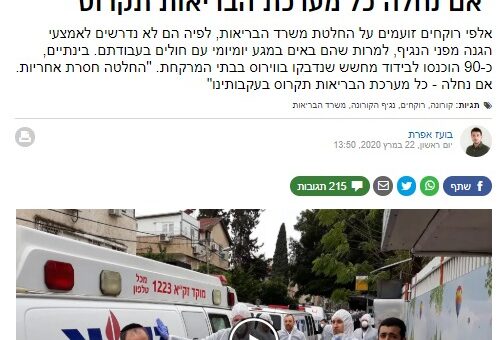


Pharmacists Are on the Front Lines – So Why Aren’t They Being Protected?
MAOZ Network members warned of the infection danger pharmacists face, and within a day, an official decision was reached to provide protection for all of them
At the outbreak of the pandemic, hundreds of pharmacies across the country were categorized as essential services, and pharmacists continued working on a daily basis in order to provide service to the residents who needed them.
But unlike medical personnel, who received equipment to prevent coronavirus infections, the pharmacists were left unprotected.
With 70% of Israeli pharmacists being from the Arab society, Arab MAOZ Network members from the healthcare and activist worlds sent an urgent appeal to the Ministry of Health. They also took other supporting actions, such as raising media awareness, appealing to political parties, and putting direct pressure on policymakers.
And it worked: the Ministry of Health guidelines were amended within less than 24 hours, and the new document contains a clear ordinance regarding the protection of pharmacy staff.
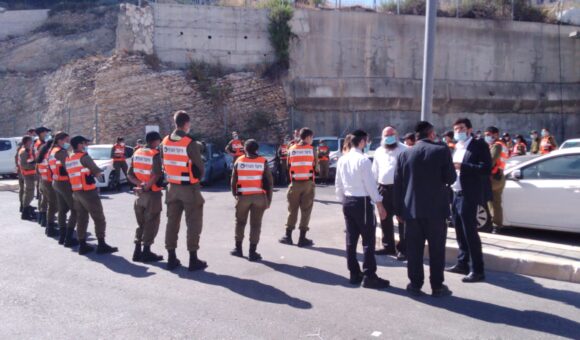


When the IDF Came into an Ultra-Orthodox Neighborhood
What do you do when your neighborhood turns red? Yehuda Spitzer from the Community Administration in Jerusalem’s Ramot neighborhood talks about the day hundreds of uniformed IDF soldiers deployed among the ultra-Orthodox residents
“It was right at the start of COVID-19 when I got a call from a city council member. He sounded worried and told me in a very stern tone of voice: ‘The situation isn’t good. We need to act fast.’
There are two community administrations in Ramot: one ultra-Orthodox and one secular. So in the ultra-Orthodox administration, we set up a neighborhood Situation Room. We created a call center and advertised it all over the neighborhood. But we didn’t just pass on instructions, we also asked questions: ‘Are you missing food? Do you need to go out to get medicine? Does any family member need to leave for isolation but you’re concerned about it? Are you worried that one of your children has contracted the virus? Talk to us.’
And they did. We entered all the reach-outs we received into an improvised Excel sheet and worked accordingly – this family needed a food delivery, that family needed help getting to the quarantine hotel, they needed medicine and we needed to check the situation in that building.
We saw that when a sudden crisis hits, two things happen: on the one hand everyone wants to help, but on the other hand, there’s so much chaos that it’s not always clear how. For example, how do we know where to send all the food boxes we had gathered? Who needs them? Who doesn’t? And is food really the thing that’s missing?
It demonstrated the Community Administration’s abilities and its important role in creating fast links to community representatives in the neighborhood. AT a time when everyone was trying to find a way to help, we found it.
We went through all the traffic light model’s colors here in Ramot: Green, orange and red. As we moved between emergency, routine and emergency routine, one thing remained constant: in order to deal with COVID-19, we had to keep our community involved.
And then the IDF Home Front Command called. ‘The neighborhood is turning red again,’ they told me. ‘There’s no alternative. We’re coming in.’ It’s not normal for military personnel to fill up ultra-Orthodox streets in our neighborhood. So we consulted the neighborhood rabbi, asking him what the right way to do this would be. ‘How do we explain this to the community?’
The rabbi recommended updating the residents so that they would be informed about what was about to happen. So we gathered the neighborhood rabbis (including some who don’t even recognize the State of Israel) and explained to them that because the situation was bad, the IDF Home Front Command would be coming in.
They passed the message on to residents. We gave people a bit of time to process it, and 24 hours later, almost 200 IDF soldiers entered into the neighborhood. It went smoothly, thanks to our coordination and cooperation.
That was just the beginning of our collaboration. To be able to help, the Home Front Command needed to partner with the community. For example, they asked us what the vulnerable areas in the neighborhood are, and so we immediately knew to send them to the bus stations to meet families and individuals travelling outside the neighborhood or the city, or those coming back from a family visit. We went down to the bus stations together. We told residents what was going on, explained and asked that they go back home.
After a few days, the Home Front Command continued on to Har Nof and then to other neighborhoods in Jerusalem. But I think that both our neighborhood and the military gained something from this challenging period – a lesson in collaboration.”
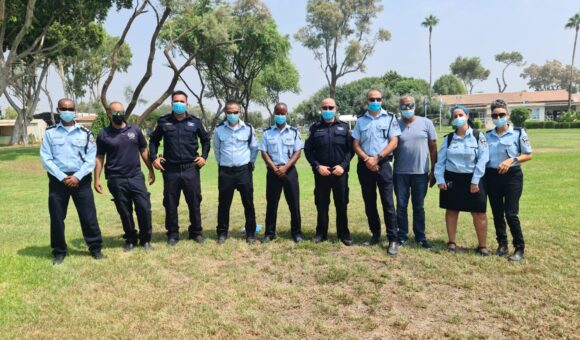


A Boy’s Dream, an Officer’s Vision
When Mevorach Avraham was appointed Commander of the police department in Kiryat Malakhi, he decided: the first meeting would take place at a youth village populated by young men who had been acquainted with the police for the wrong reasons
“Earlier this year, I returned to Kiryat Malakhi , the southern city I immigrated to from Ethiopia as a child almost 40 years ago. Only this time, I arrived as a senior policeman – the Commander of the city’s Police Department.
I believe that my connection to the city and its people is the story of this department and of our role. At the Kiryat Malakhi Police Department, we’re building a community.
The station typically kicks every week off with a situation assessment – a standard routine during which we update each other and conduct short-term planning. At my first meeting on in charge, I took all the police officers to a new space. We didn’t hold our situation assessment between the four walls of the police station that day. Instead, we met in a space that we had to get to know better.
Less than six miles away from the police station (a drive of only a few minutes) lies the Kedma Youth Village for at-risk youth. I thought this was the perfect place for us to learn about the impact we have on the people we serve and reflect on the significance of our roles; this was the space where we could personally hone what our roles are to ourselves.
We met with Shahar Rubenstein, the CEO of the youth village and a fellow MAOZ Network member, and teens from the village, as well. We heard about their experiences and charged encounters with the police, and we brainstormed about collaborations. This time, we, the powerful police officers, sought their assistance. For example, the next time we arrest a young man for his involvement in a low-level crime, maybe we can refer him to the village instead of opening a criminal case against him.
During this conversation, I turned to Yehudah, one of the young Ethiopian-Israeli men, and asked him: ‘What’s your dream?’
‘To start a family,’ he replied quickly.
‘And what are your expectations of us?’ I asked.
‘Let me be an equal citizen,’ he said to me just as quickly. ‘Speak to me in a down to earth manner.’
I remember that moment because I saw the looks in the eyes of the other police officers. That sentence stuck with us. Suddenly, they saw Yehudah, a young man with dreams and aspirations sitting in from of them. He wasn’t just ‘Y.’, a kid who had gotten mixed up in criminal activities. They realized that Yehudah has expectations of us, and that it’s our responsibility to meet them.
I hope that the meeting affected the young men as much as it impacted us. I hope they didn’t see a police officer or the Commander of the Police Department sitting in front of them in uniform. Instead, I hope they saw Mevorach, who had immigrated from Ethiopia to Kiryat Malakhi and looked exactly like some of them. I hope they saw that I’m a police officer who listens and cares and wants to learn from them.
When we returned to the station, it was clear to everyone that what we had seen in the youth village needed to be incorporated into our work plan. We had to figure out how to become police officers who don’t simply exercise our authority by virtue of our positions, but through seeing residents, teens and kids as people.
The reality won’t change so quickly. We will still see tension and racism in the world and among police officers. I don’t expect one meeting to change everything. But I’m sure that this meeting has blazed a trail forward for us.
I think of Yehudah, the police officers and myself, and it’s precisely during these difficult days in the already incredibly complex Israeli reality when I allow myself to dream. To dream of a reality in which young people of all backgrounds can see a police officer and not be afraid or apprehensive, but instead know that he or she is here to help them and our society.
That’s what fills me with hope.
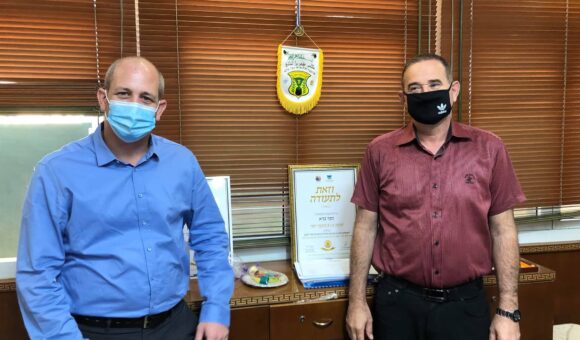


Us and Them: During the Pandemic, We’re all in the Same Ship
Nir Bartal, mayor of Oranit, was concerned when his residents started asking: why are we allowing in residents from “red municipalities”? So he wrote a Facebook post, saying: in the Pandemic, we’re all the same
The original title for this post, which was written one week before the decision about the first lockdown, was meant to be: 40 Shades of Red. But the events of recent days led me to believe that it needs to be – “Us and Them.”
I planned to tell you about how two days before the closure began in “red” towns, I visited with two friends of mine, mayors of towns that are currently red: Rabbi Eliyahu Gafni, mayor of Emmanuel, and Mahmoud Assi, mayor of Kfar Bara, to support them and to think together how to cope with the coronavirus.
I planned to share with you the challenges they are facing: how do the residents of Emmanuel, most of whom do not have cars and use public transportation, travel to the corona testing point? How do they get a referral from their health fund when they do not have the app or internet? How do residents who do not have Facebook, WhatsApp or text messages get updates on guidelines? How has Kfar Bara managed to go nearly a month with only two confirmed cases and now, after 60% of Kfar Bara residents have been tested for corona, there are now 55 cases?
People have turned to me quite a few times with questions that begin with “us” and “them”. Why do we, in green and yellow towns, need to permit entrance to our town by “them” from red towns? Why can’t we, the secular, go to celebrate or to the country club…because of them, the religious? Why “us” the Jews…and “them” the Arabs? Why us the adults…because of the young people…?
True, there were not many such inquiries but there were some. I think that they show how we need to be careful. Careful with judgementalism, with criticism, with our angry statements about other people, other groups. It’s very “easy” to speak about us and them. It removes responsibility from us and distances us from unpleasant things. It enables us to define a group on whom we can place blame.
Behind every “us” and “them” are people. They are other but they too carry with them fears and concerns, exactly like ours. I have had the opportunity to speak personally with not a few of the ill people in Oranit (or at least with one of their family members). Among all of them was the fear – “we only hope that we did not infect anyone.” If you ask me, I have no doubt that no one (not of “us” and not of “them”) wants to become infected and no less so, no one wants to infect another. And the responsibility to ensure we do not become infected and do not infect others belongs to all of us.
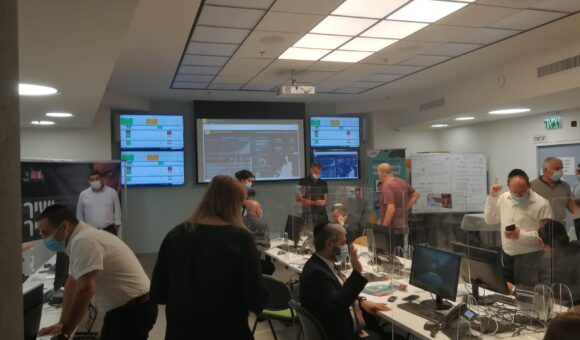


I Realized We Can’t Wait for the Government. We Must Take Responsibility
The education system in Jerusalem is a microcosm of the country. Zion Regev, Director of the Five-Year Plan for the Jerusalem Municipality, tells about the moment when he realized that during the pandemic, their education system needs it’s own situation room.
“Jerusalem is sometimes a little like its own country – due to its size, and due to its diversity and uniqueness. We have 290,000 students in the city educational system. Ultra-orthodox, Arab, secular and religious. Children and youth from all corners of Israeli society are here with us in the city.
Our educational system, like the entire country, is going through a period of turbulence and uncertainty – and it comes in waves. Systems are opened and closed, there are infections, an increase in morbidity, a decrease in morbidity, quarantines. It’s all dynamic and it all needs rapid response.
In preparation for the beginning of the school year, we realized that opening educational frameworks brings questions, concerns, clarifications. The students, the parents and the educational staff had many questions that were bothering them: in what format will the year open – at school or with distance learning? What happens if there is a confirmed case in my child’s class? If my child is in quarantine, what do we do? If I am an at-risk teacher, what do I do? The answers to the questions are obviously dependent on policies, which in turn are influenced by morbidity rates. But what do we do in the meantime? What do we do with the vacuum created?
The vacuum created between decision making and the field, that is part of our role. We at the municipality realized that we had to enter this vacuum. We must be active.
So, we established a situation room for the educational system during the pandemic situation. We consulted with MAOZ about the situation room; they connected us with other authorities that already had active situation rooms. From there, at top speed, our new situation room was established.
An educational system situation room means an available, updated and connecting system. It means that the connection between health, education and the local authority is critical right now and here is a way to convey information, to raise challenges, to create solutions quickly, together.
The situation room has a role in cases of infection in schools. The moment we know about a confirmed case, we make sure that the person and those who were in contact with them go into quarantine as quickly as possible. Every day we create a local authority map of confirmed cases and people in quarantine in the educational system and share the information with the Health Ministry. The data and analysis that we share serve the decision makers at the national level. We realized that we are the only ones who know how to provide an in-depth analysis of morbidity in the educational system in Jerusalem.
We created a new system that synchronizes forces and is accessible to parents and to educational staff. Now we are a phone call away and they can turn to us with any question. This creates a sense of certainty and security within the great chaos. I think that this is our role.
Since then, I have spoken with members of the Network who are establishing situation rooms in their local authorities. We all understand that this is our role.
.
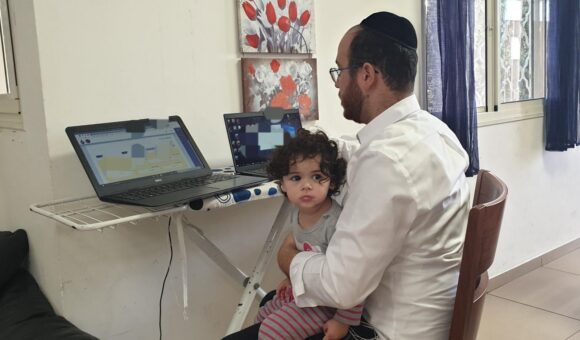


“Wearing a Mask is Fulfilling the Commandment to Preserve your Lives”
Moshe Adler, Director of the Haredi Sector at the Clalit Health Fund, talks about coronavirus patients who said goodbye to him on the phone for the last time, about the situation room he established in his home – and about the realization that observing the guidelines is, quite simply, a commandment
“These days, in my opinion, are very meaningful. There isn’t a building without coronavirus patients, there isn’t a family who doesn’t know someone who is hospitalized or, heaven forbid, no longer here.
In recent days I personally experienced several goodbyes over the phone with people who left this world. A member of the health fund who spoke about getting the coronavirus test at his home and two days later I went to comfort mourners. A young woman fighting for every word but begging: she is afraid to go to the hospital, afraid she won’t return, and requests treatment at home – which we cannot provide.
People who really deserve to go to a quarantine hotel cry to us to speed up the process with the Home Front Command. And these days I am the Front Command Room. Up until Yom Kippur began, I was working with the computer next to me to track tests that got stuck in some laboratory and you can “say kaddish” for them, to support people seeking mental health assistance, and to publish distancing guidelines; even on eve of the holiday.
The reinforcement that I feel is the call of the great men of the generation, may they have long life, from Rabbi Chaim Kanievsky and Rabbi Gershon Edelstein, who sent out a call again in an exact way. On the one hand they said: Wear a mask, even if it is uncomfortable, over your nose. Do not host or be hosted and pray as much as possible only in open spaces. And with this: preserve the atmosphere of joy and calm as much as possible at home and be strengthened through Torah study and Psalms.
It strengthened me greatly, the notice that what I am doing right now is simply a commandment, a mitzvah. Wearing a mask is fulfilling the commandment to preserve your lives (ונשמרתם לנפשותיכם””) A commandment!
And I hope that we shall merit to see the Messiah here, for through the hands of man, I don’t see the illness going away. So, I dream about the refreshing morning with the report of a cool breeze that gathers the coronavirus and it disappears…Amen!”
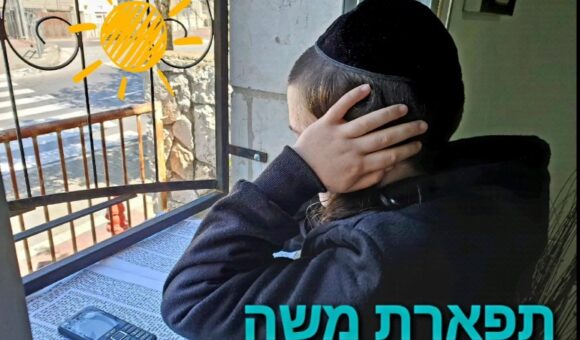


Operation COVID-19: Curbing School Dropouts
When there are neither schools nor Zoom classes, who will keep ultra-Orthodox students from dropping out of their educational frameworks? Yehuda Korenblit, Head of Beitar Illit’s Education Department, found a partner and embarked on a quick rescue mission
What does education look like in the ultra-Orthodox city of Beitar Illit during a prolonged period of emergency? When the COVID-19 outbreak began, only one educational institution in the city switched to online learning.
All other institutions knew they needed to keep up their respective learning routines, but the scale of the challenge required creative and effective solutions for managing a regular education system in homes blessed with many children but lacking computers and internet connections.
The education department’s task was not simple, but with a swift preparation process lasting less than one week, the various institutions set up a dedicated remote learning education system: instead of Zooming on computers, they used kosher phones. Children could use their phones to join voice-based sessions for personal conversations with their teacher while listening to recorded classes.
This method proved to be a rapid, high quality solution for thousands of students in Beitar Illit. But we knew that there were still hundreds of students caught in the middle who were not participating in the phone-based sessions for all kinds of educational, emotional and/or social reasons. These 300 students were defined as being at-risk of covert or overt dropout, as they had been left without educational frameworks even before COVID-19 hit. Some of these students found themselves alone with no educational framework to support and guide them in these challenging and sensitive times.
King Solomon, considered the wisest of all, had provided the solution for times of crisis such as these when he said that the best advice is to obviously receive advice. As he said, “In the multitude of counselors, there is safety”. I called a resident of the city, Menachem Bombach, the head of the Netzach education network and a MAOZ Network member. I outlined the challenge for him and asked for his advice.
We realized that the first thing to do was technical: reconnect these students to learning. So through fast collaboration, the charity set up a platform for dedicated distance learning. We raised funds to purchase equipment for students who needed it. We came to their doors, and every student who received equipment was also paired with an adult mentor to guide them and act as a point of contact during this period, while supporting their continued learning and narrowing the educational gaps.
Through this joint effort, we managed to retain a large number of students within a learning routine. An unusual routine, admittedly, bzut within a clear framework, which is so important, as we all know.
The challenges didn’t stop there. When I received my phone bill for the first month, I couldn’t believe my eyes: my own personal phone bill had come out to 1,000 shekels. And I wasn’t alone. All the families whose children were connected to domestic phone lines received bills for thousands of shekels.
Infrastructure collapsed pretty fast as well. We had always had phone reception issues in Beitar Illit, and now with so much activity on so many lines, the infrastructure was unable to handle the load.
The crisis also brought up opportunities for collaboration. First of all, within municipal departments, such as the collaboration between the education and psychological services departments regarding learning via phones or strengthening relations with parents. There were collaborations on the regional level as well, as a phone line and voice sessions were set up for the community center, for communities and youth organizations. There was further collaboration between the Municipality and government ministries, such as the Ministry of Communication regarding lowering the unexpected high costs.”
All other institutions knew they needed to keep up their respective learning routines, but the scale of the challenge required creative and effective solutions for managing a regular education system in homes blessed with many children but lacking computers and internet connections.
The education department’s task was not simple, but with a swift preparation process lasting less than one week, the various institutions set up a dedicated remote learning education system: instead of Zooming on computers, they used kosher phones. Children could use their phones to join voice-based sessions for personal conversations with their teacher while listening to recorded classes.
This method proved to be a rapid, high quality solution for thousands of students in Beitar Illit. But we knew that there were still hundreds of students caught in the middle who were not participating in the phone-based sessions for all kinds of educational, emotional and/or social reasons. These 300 students were defined as being at-risk of covert or overt dropout, as they had been left without educational frameworks even before COVID-19 hit. Some of these students found themselves alone with no educational framework to support and guide them in these challenging and sensitive times.
King Solomon, considered the wisest of all, had provided the solution for times of crisis such as these when he said that the best advice is to obviously receive advice. As he said, “In the multitude of counselors, there is safety”. I called a resident of the city, Menachem Bombach, the head of the Netzach education network and a MAOZ Network member. I outlined the challenge for him and asked for his advice.
We realized that the first thing to do was technical: reconnect these students to learning. So through fast collaboration, the charity set up a platform for dedicated distance learning. We raised funds to purchase equipment for students who needed it. We came to their doors, and every student who received equipment was also paired with an adult mentor to guide them and act as a point of contact during this period, while supporting their continued learning and narrowing the educational gaps.
Through this joint effort, we managed to retain a large number of students within a learning routine. An unusual routine, admittedly, bzut within a clear framework, which is so important, as we all know.
The challenges didn’t stop there. When I received my phone bill for the first month, I couldn’t believe my eyes: my own personal phone bill had come out to 1,000 shekels. And I wasn’t alone. All the families whose children were connected to domestic phone lines received bills for thousands of shekels.
Infrastructure collapsed pretty fast as well. We had always had phone reception issues in Beitar Illit, and now with so much activity on so many lines, the infrastructure was unable to handle the load.
The crisis also brought up opportunities for collaboration. First of all, within municipal departments, such as the collaboration between the education and psychological services departments regarding learning via phones or strengthening relations with parents. There were collaborations on the regional level as well, as a phone line and voice sessions were set up for the community center, for communities and youth organizations. There was further collaboration between the Municipality and government ministries, such as the Ministry of Communication regarding lowering the unexpected high costs.”
Behind the Masks, our Humanity Stands Out
Adel Iktelat, a senior Clalit HMO official, deals with the pandemic every day at work. Then one day, it hit close to home
“I’m Adel Iktelat, I live in Daburiyya and I’m the Nazareth Director of Nursing in the Clalit HMO’s Northern District and the Director of the Repeated Hospitalization System for the Northern district.
Daburiyya is a 10,000-person village populated by some of the highest rates of nurses and doctors per capita in the Arab society. I live here next door to the house I grew up in, where my parents live – my mother, may she live a long life, and my father, who sadly passed away during COVID-19. He died on March 13, at the peak of the COVID-19 crisis.
My father’s funeral was on Saturday, and I was on the phone the whole time. I barely even went to the mourning house. Finally, my older brother turned to me and said, ‘Listen – go. No one’s angry. Go out and do your work. They need you and we understand.’ The very next day, I was already in the office. I told everyone that if I had managed to come from my house to deal with the situation, everyone had to buy in. This was our moment of truth.
Then came a wave of morbidity in the area’s villages: Daburiyya, Kafr Kanna and more. An outbreak took place in a nearby nursing home called Yavniel. It started with one, two, three, four, five people, and then we discovered that almost house had someone who had been in contact with a confirmed patient or who was sick him or herself. It was then when Daburiyya began making the headlines.
Daburiyya’s mayor was smart; he knew who to contact. He picked up the phone and called everyone who works at Clalit and told them that he needed help. And he didn’t ask – he demanded. Daburiyya is not typically part of a zone I’m responsible for, but since I live here, I asked to focus my efforts here.
At the peak of the crisis, we set up a testing tent and began operating it. We set up three testing cycles in Daburiyya, and Clalit conducted around 700 tests. It was a true local collaboration – everyone put in a joint effort.
I don’t typically deal with Magen David Adom or the IDF Home Front Command on a daily basis. We only see each other when we run some sort of exercise or when the Ministry of Health conducts reviews – not the happiest of occasions. But suddenly, everyone became a partner around the same table. There were tons of opinions, many different customs and various political identities, but at the end of the day, we all wanted to help everyone. This type of collaboration is ultimately what will help curb the disease.
I think COVID-19 is the only situation where the State of Israel has truly been threatened and Arabs and Jews have stood side by side; Jews have trusted Arabs and we have worked together. We’re all behind masks. The hazmat suits we all wear have proven that our appearances have no real meaning. Our content and humanity have stood out more than anything. It doesn’t matter where you came from. That’s thanks to COVID-19. That’s the beautiful side of the coronavirus.”
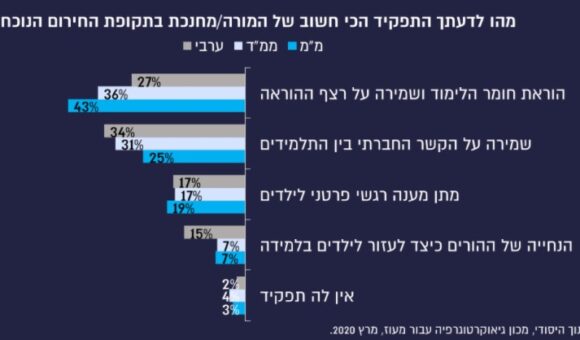


Parents Have a New Role. And We Have to Listen to Them
What happens to parents when the school system closes and the classroom is replaced by the living room? MAOZ’s ADVOT Joint Venture decided to find out with a survey, which was then delivered to policymakers
When the pandemic broke out and the country shut down, classrooms were left behind and studies became remote. The classrooms, teachers’ lounges, principal’s office and schoolyard were replaced by a single space: the home.
Parents discovered that they had a new role: they needed to be part-teacher and part-tutor, reinforcing their child’s education with private lessons. With no prior preparation, they were suddenly required to be much more involved and active in their children’s schedules.
How did they handle this? And what did they think of their new roles? What’s difficult for them? What works? What doesn’t? What could help? And what simply needs to change?
The ADVOT Joint Venture decided to find out what parents had to say. Thus the parent survey was launched, aiming to bring a new voice to the policymakers’ table. More than 800 parents took part in the survey, which sought to uncover attitudes and perceptions regarding distance learning.
The information was collected, organized, and transferred to the Ministry of Education and local authorities, with the aim of updating and adjusting the approach and implementation of distance learning. In Umm al-Fahm, for example, a Network member used the data to help in the process of holding meetings focused on increasing trust among parents. In the Ministry of Education, discussions about learning were held based on the insights obtained from the data.
The knowledge continued to circulate to the OECD research body, to other organizations which analyzed the data and distributed it to their audiences, and to media outlets which covered the story through the eyes of the parents. Following the general survey, a group of ultra-Orthodox Network members initiated a special survey for ultra-Orthodox parents, and the insights obtained regarding the reopening of schools between lockdowns were applied.
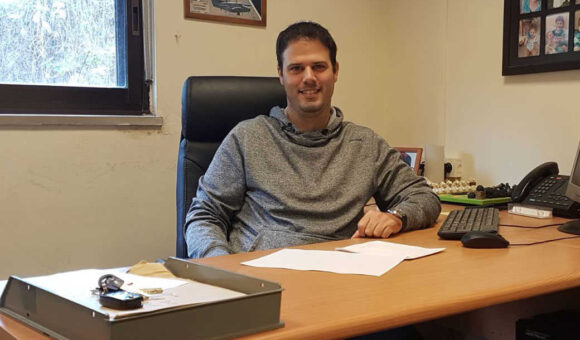


Spike in People Seeking Psychiatric Treatment Due to the Pandemic
In his clinic, Dr. Shimon Burshtein, a psychiatrist, sees many patients who wouldn’t have needed him if not for the pandemic. But now he can provide remote care to people in their natural environment
“Psychiatry is healthcare for mental illness. There are those defined as patients with psychiatric illnesses, such as depression, anxiety, and schizophrenia.
And lately there are also many people who have never been diagnosed with a psychiatric illness, who have turned to mental health services due to distress. These are not people who have an illness that is defined as a mental disorder – they’re simply in psychological turmoil regarding the new circumstances they find themselves in.
There are two components to this: one is certainly the objective difficulties. When someone is anxious about whether his or her children will have food to eat tomorrow because his or her business isn’t running and there’s still a mortgage to pay, there is an objective difficulty and objective tension there. The second component is the distress arising from the uncertainty, and the fact that he or she doesn’t know what will happen.
People have depleted their reserves, causing distress levels to rise. Then, if they want to make an appointment with a psychiatrist, they discover that the next opening is in three months. It’s when our lack of availability has heavy ramifications, such as suicide attempts, that I have the hardest time. I say to myself: ‘if I had been available, would the outcome have been different?’ The very question is problematic because it arouses guilt and frustration in me.
But this crisis also presents a kind of opportunity, as any crisis does. It is now possible to implement a process of remote treatment – something hospitals have tried for years to build infrastructure and gain recognition for. Not all psychiatric patients know how to use Zoom, and not everyone has a suitable internet connection at home. So for some patients this is complicated. But others actually find it easier. When these patients are in their natural environment, they feel more comfortable expressing themselves and they can really be seen.”
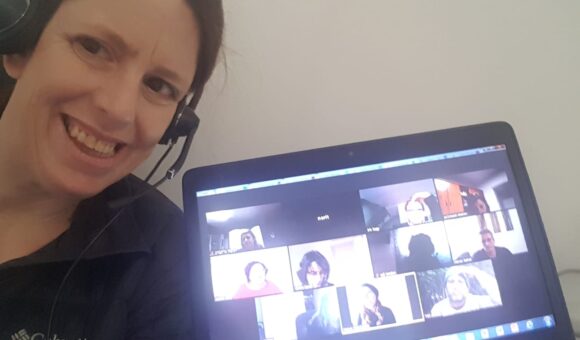


Bringing the Teaching of Math into the 21st Century
When schools stopped and remote learning began – that’s when Nerit Katz, Director of Mathematics for the Ministry of Education, realized she can start an historic change in the way math is taught
“I’ve worked in the education system for years, but during this pandemic, I’ve seen the entire system changing before my eyes. Mathematics teaching, and teaching in general, has not changed much since the 19th century – there’s always a teacher writing formulas on the board in front of a class of 40 students. Everything we were familiar with, everything we learned, everything we thought, everything we knew – is changing. The concept of school, classroom, teacher, student – everything that sounded logical a few months or weeks ago has stopped working.
During the pandemic, school stopped – and so did classroom lessons. Everything became computerized. It very quickly became clear that you can’t teach mathematics on Zoom the same way you do in a classroom: on the one hand, teachers struggle with the technological adaptations (how do you write formulas on the board on a computer?) and on the other hand, students have difficulty concentrating in the absence of a physical learning environment. If the teacher goes too fast, the student doesn’t understand and is left behind.
Until a few months ago, my role as Director of Secondary School Mathematics for the Ministry of Education seemed a bit simpler: I was responsible for mathematics studies in middle and high schools. My task was to work with teachers and students on mathematics studies so that more students would study and take part in this circle of learning and excellence.
Now my mission has gotten a bit of a twist. If we want students to learn mathematics today and continue our great efforts to increase the number of students and prevent students from dropping out, we ourselves have to adapt.
We started the Home and Away program because we realized that we needed to find a real solution for teaching during the pandemic, and in the 21st century in general. Even before the pandemic started, we had begun considering how to create solutions and a different kind of learning.
Home and Away is a program that was born on the same day the pandemic was born. Teachers needed to teach from a distance, and they were feeling helpless. They did the easiest and simplest thing – they took their classes as they were and simply ran them on Zoom. In the classroom, the marker on the board has a lot of advantages and disadvantages. But when we move the board and marker to Zoom, it seems there are only disadvantages. Therefore, we understood that we had to do something different.
We decided to focus on a group of 10th grade students preparing for their matriculation exams in the coming school year. We built a entire distance learning system for them – not only to strengthen their learning and help them stay connected, but to create a comprehensive and encompassing structure to help them continue their regular learning exactly as if they were in the classroom.
How does it work? We realized that we needed to change the form of learning in three aspects: to adapt the old form of teaching to a digital platform, to build a digital tool that would enable us to keep track of each student’s progress, and to create meetings for individual accompaniment.
All our activities have now moved online: we film in studios and upload lessons to the internet for all students in grades 7th to 12th. In addition, we provide online solutions for teachers, operate an online learning system for students, make knowledge accessible with relevant material and content for teachers and students, and focus on students who currently learn outside an organized framework with a teacher. All of this is done online.
We built a “smart site” that helps teachers adapt their teaching to each student’s respective level. The site keeps track of students’ progress. If they solve problems quickly, the site races through the material. If they have difficulty with some tasks, the teacher will get involved and provide the appropriate assistance. For the first time, the teacher has a dashboard and knows how well each student in the class is mastering the study material.
The students view the recorded classes in advance, at a time and place that is comfortable for them, and the teacher knows the exact situation of each student through using the dashboard. The teacher’s precious time is invested in individualized learning and practice for each student according to their level. The learning is much more personalized in this way.
Today I can say that the challenge of distance learning has opened many opportunities for us. The teachers were open to hearing what we at the Ministry had to offer and the system was open to the process. Usually, teachers do what they did yesterday and last week and two weeks ago. In this situation, on the other hand, in we have a significant opportunity to change the system.
It was clear to us at the Ministry of Education that we couldn’t provide all the solutions; therefore, we created partnerships with players we don’t usually partner with. The first partner is P.I.E. Challenge and the second is Branco Weiss. Collaboration is not trivial, the situation is not trivial and when the situation is not trivial, we need to find solutions which are not trivial. We recently also partnered with Digital Israel in order to reach more teachers and students.
This program began for 10th graders in 5-unit classes, with 28 teachers. In the second stage, which happened a few weeks later, 120 additional teachers joined. We opened the current school year with much higher numbers. I’m excited to say that we have 2,200 teachers registered and 10,000 classes participating in Home and Away.
I think Home and Away is the solution for this specific year of the pandemic, but also for the year that will follow. It is an optimal program for teaching mathematics differently, appropriate to this period. A different kind of math teaching.
I am a big believer in mathematics. I’ve always believed in it. When my own child is at home and needs a moment to reset, I send him to do some math problems. I think that this is always correct, and especially during the pandemic period.”
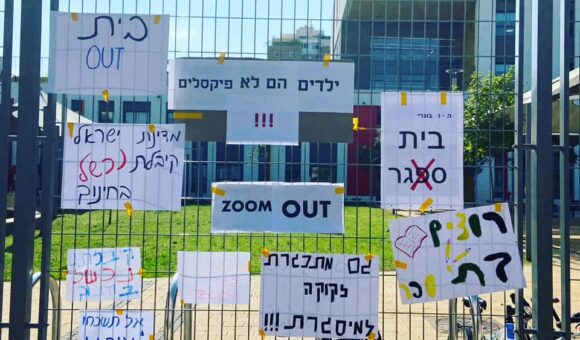


How We Can Use COVID-19 to Start an Educational Revolution
One regular remote learning day a week, cutting the number of subjects, and more independent study. Shirley Rimon-Bracha, Head of the Education Administration in the Tel Aviv-Jaffa Municipality, wants to keep the changes made during the pandemic even after it’s over
“My role has changed over the past year. As the head of such a large system, I rarely need to engage at the micro level. I mainly deal with macro issues – processes, policies and thinking one, two, four years ahead.
But over the last few months, I’ve found myself dealing only with today, tomorrow, the day after tomorrow – at most a week from now. And I’ve been exposed to a lot of small details that policymakers usually aren’t familiar with on a day-to-day basis. But when you take a moment to pause, when you look at individuals and hear their stories, you truly understand the meaning of education, and why we say that education is ‘tikkun olam’ – a step toward repairing the world.
This period has convinced me that we must allow school principals more authority. That they are the ones with the knowledge and understanding, and that the role of local authorities should be to enable them to take action. It has become clear to me how important it is for a government ministry to be responsible for oversight, rather than serving as an executive body, an oversight body and a development body. It cannot be everything at once.
In every school we go into now, we see children studying in places they have never studied before. On the roof in the schoolyard and in the hallways outside. We tell the principals to treat the children’s time in school like gold. At home they can do whatever is possible through remote learning; at school you should hold discussions, have conversations, and do the things that require the accompaniment of an adult.
The whole approach to teaching and learning has gotten a boost of creativity, as we seek to get the most out of the children during a period when they aren’t coming to school every day. There’s something about breaking up the routine, about the disruption, that is so good for the system. The system has needed this disruption for a long time.
Now we need to work on how to maintain it, and this is the top priority.
My new slogan is: how not to go back to February 2020. Assuming that by February 2021 all children will already be back in the school system, it cannot be the way it was in February 2020. Instead, it should be more like September 2020, which was diverse, creative, outdoors. It was up, down, sideways, conducted from home, hybrid. Full of engagement with nature, playfulness, lots of independent study for the kids – an activity to which teachers don’t always attach enough importance.
So that’s our job now. To not go back to February 2020. And I can’t do it alone; it’s not something a municipality can do alone. This is the role of the government.
What will it look like? I think it’s important to have remote learning one day a week for post-primary education. Four days a week spent physically at school and one day learning from home. This is so that children will miss going to school, and also so that they will practice independent learning. One of the things we learned during the pandemic was the extent to which children are not equipped to learn on their own.
Such a change would jumpstart the education system and save contact hours. During this time, children could study from home asynchronously, and these hours would be devoted to teacher learning.
To this end, we need to add smaller class sizes; and if some of the children are studying from home, this is possible. We will also need to reduce the number of subjects, since it’s not possible to study 15 subjects a week if you take one school day out.
Principals being flexible enough to build changing systems, a reduction in the number of subjects due to less time in school, and sanctifying the ‘golden hours’ which are physically spent in school. If we can hold on to these changes, we will have changed the system – and I will forever say ‘thank you’ to my beloved coronavirus.”
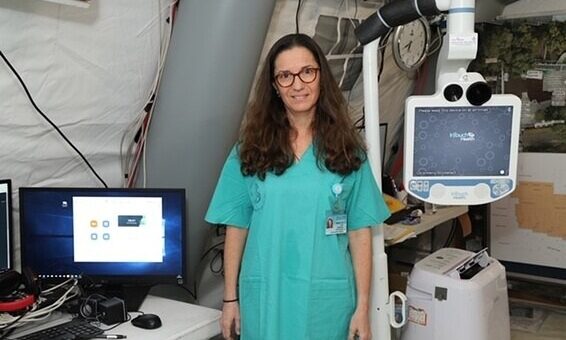


How Coronavirus Has Changed the Medical Treatments We’ll Receive
When she established the first coronavirus ward in the country, Dr. Galia Barkai had to find ways to treat patients remotely in order to keep staff from becoming infected. Now, she’s establishing a center for remote medicine at the Sheba Medical Center
“At the beginning of the pandemic, I thought it would be a two or three-month issue we’d eventually adapt to and then it’d be over. We didn’t imagine that its impact on our lives would be so great.
It was a big learning curve for the hospital from the very beginning, when I was tasked with establishing the first ward for coronavirus patients. This meant using telemedicine tools not to remotely treat patients, but to protect medical staff.
We started with these patients and then the lockdown began. The outpatient clinics closed and no one could leave their houses. Most of the patients who really needed us were those not suffering from COVID-19: cancer patients, children with chronic diseases, and more.
So very quickly, within 10 days, we enabled all of our caregivers to perform treatments via video. Because we deployed this service so quickly, we were able to learn relatively easily how to improve its processes. If we had implemented it for a year in the hospital, it would have taken much longer to improve processes, to learn about the technology and the sequence of treatment.
During the pandemic, we realized that beyond wanting to give people access to remote services, we wanted to build an independent body that will greatly increase our telemedicine capabilities. This is the unit I am currently in the process of setting up.
We are setting up services that will allow us to monitor patients at home, perform home hospitalizations, and make these services available even to people who are geographically far from us. Take people who live a long way from central Israel, for example, and are unable to receive cardiac rehabilitation. Thanks to the fact that we can conduct cardiac rehabilitative care remotely, we’ll be able to provide the service to people who live further away, as well. I see telemedicine as a means of making quality medical services accessible to more distant places. Remote medical services also make it possible to discharge people quickly to their homes rather than keeping them in long-term hospitalization.
One of the things that surprised me was that my patients adapted to the service relatively quickly. It was actually more difficult for the doctors. It was harder for them technologically, and from an administrative viewpoint it’s more complex for the caregiver.
We must remember that the medical profession is a very physical one. Physicians have to undergo serious adaptive change to be able to break away from the belief that they must physically be in the same space with their patients – to touch them, hold their hand, and see them up-close.
I myself, during the years I worked in the ward, never missed an opportunity to conduct a physical examination of each of my patients – even if I had examined them the day before and I knew exactly what I’d find in their stomach or legs. These rituals are deeply ingrained, and you feel you haven’t done your job if you haven’t examined the patient from head to toe. Breaking away from this habit presents a difficulty to someone who has been doing it for many years.
Even for me, someone who has been practicing telemedicine for a few years, it’s hard to give up the physical, hands-on care. And I’m sure that in the future, in addition to remote medicine, there will still be plenty of room for physical contact, face-to-face meetings, and intensive personal treatment.”
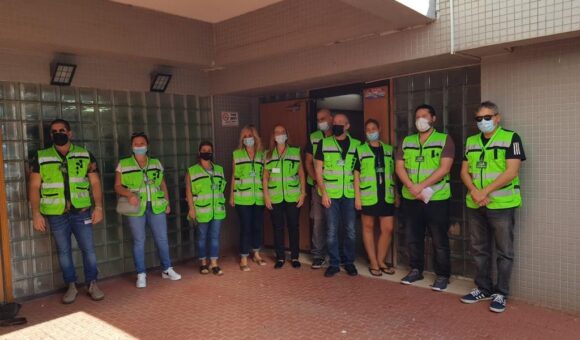


The moment I Realized the Responsibility is Mine
“Liat Shohat, Mayor of Or Yehuda, will never forget that phone call: “The first confirmed case in Israel is yours. That was the moment she realized all her
residents really had – is her and her team
I remember a phone call I received somewhere at the end of February: ‘The first confirmed case in Israel is yours.’ On that day the virus began to run our lives. It happened in one of the toy stores in the city, on the busy costume buying days leading up to the Purim holiday. The first confirmed case was located there, in Or Yehuda, and from there it developed throughout the country. That’s how Or Yehuda became the first town in the country with corona.
I was on the phone with the highest echelons of the Ministry of Health. I began the conversation with one person, and slowly they put more and more people on the call. I immediately understood the significance of the event. They were considering what the guidelines said, who had to go into quarantine, how do we report, how do we assure. Pandemonium.
That was the moment I understood how great my responsibility is. In a period like this, in which the government authorities don’t really have more knowledge than anyone else, the residents need someone they can rely on. Us.
Very quickly we found ourselves doing things we had not imagined one month prior, and establishing a citywide headquarters for coping with the coronavirus – who really knows what that means? An almost daily routine began: At 8 pm a press conference with the Prime Minister is broadcast, and in the morning the residents call the city headquarters: Do the guidelines apply to me? Am I permitted to go to work?
On one of the mornings, the facilitator from MAOZ called me and asked, “How can we help you?” This question made me stop. I repeated the question out loud: “How can you help me?” We agreed to meet the next day.
We met. On screen of course. We mapped the challenges of corona as they appear in Or Yehuda. Our central problem was how to enforce the guidelines. I found myself in daily conversations with the police, the Home Front Command, the urban policing department – looking for the authority that would make the residents obey. But how many supervisors can we recruit and how many tickets can we write?
In one the meetings with the MAOZ staff, a simple idea was raised. Maybe instead of police officers and supervisors, we can call up residents. We decided to establish a volunteer patrol, give them green vests, like the police wear, and send them to speak with their neighbors. And it works. It’s amazing what a green vest can do. When a resident takes off her mask, and someone in a green vest admonishes her, it doesn’t matter that they don’t have official authority. She obeys”.
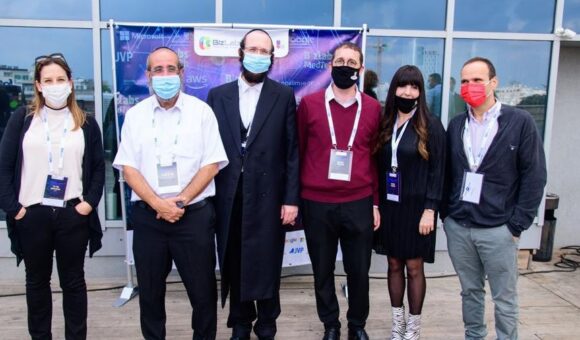


The Ultra-Orthodox Entrepreneurs Inventing Tomorrow’s Pharmaceuticals
Lacking experience in the IDF’s elite Unit 8200, but armed with a drive to succeed, ultra-Orthodox entrepreneurs are taking part in a special program for medical startups led by Bizmax CEO Yitzik Crombie
“Bizmax was founded to encourage support and employment in entrepreneurship among the ultra-Orthodox community. Over the last three cycles that have taken place in Jerusalem, we’ve provided support to 21 startup companies from different fields that have raised over $10 million.
Five years ago, when we started these programs, our only goal was to support ultra-Orthodox-led startups, no matter the field or what the market demanded.
But now we have decided to do things differently. We conducted extensive research to check the areas where startups exist and where they don’t – above all else to see where we’ll be able to add significant value. Before COVID-19 even began, we found that the medical field was growing. Now, that growth has greatly expanded. We realized that this is the arena – medical equipment and digital healthcare.
In order to be an entrepreneur in the high-tech industry, you have to operate in an expansive ecosystem. You can’t lead a startup while confined within the walls of the ultra-Orthodox society. To succeed, you have to work with other sectors and societies.
So we looked for a partner, and we found the Wolfson Medical Center. With a great deal of goodwill, and minimal red-tape, we were on our way. The BizLabs MedTech program was established. We identified seven startups in advanced stages which were led by ultra-Orthodox entrepreneurs. The teams and products will receive intensive assistance over the next six months, with guided tours and meetings with relevant experts, investor forums, access to hospital labs, and more.
A few weeks ago, we held a special event for the program launch – with only 20 participants because of COVID-19 restrictions. Only the principal partners were invited. Out of twenty, five were MAOZ Network members. We had Motti Eichler, Founder and Chairman of the Achim Global Foundation, which supports the program; Arik Adler, Treasurer of the Bnei Brak Municipality; Shai-Lee Spigelman, Director-General of the Ministry of Science and Technology; Roy Cohen, CEO of the Haredi Institute for Public Affairs, and myself. The fact that we’re all MAOZ Network members who know each other made the whole process much easier, and strengthened the work we did together. Communication is different when it’s
The Power of MAOZ Network Connections: 3D Printers Printed Protective Equipment for Hospitals
The MAOZ Network’s greatest strength lies in its ability to connect its members with one another, especially during such an unprecedented period. So how did a single message in the Network turn into a massive operation to print medical equipment?
“The coronavirus crisis began with a huge sense of uncertainty. Suddenly we were hit with a virus, an emergency, hordes of sick people. A national and global pandemic. So where to begin? How do you understand and map out your needs? How do you swiftly recruit partners and provide efficient and appropriate solutions?
Amid the chaos, we came to realize that more and more people were becoming infected with the virus. But on top of all this, the infection rate among medical staff was incredibly high. We realized that we had a huge problem in terms of protective equipment for doctors and medical staff, combined with a wider shortage of equipment in the medical system. But what exactly was there a shortage of? What was the extent of it? Which equipment was most urgently needed? How could we communicate these gaps?
At the same time, I received messages from civilian organizations that we routinely work with, asking how they can lend their assistance with the medical crisis. I’m talking about developers, engineers, 3D printer operators – an entire group of people willing and able to produce whatever was missing. On our part, however, we didn’t really know where to begin.
So I sent a message on the Network WhatsApp group and asked where assistance was needed. I imagined that amid this mess, the Network would provide me with a clear picture of everything going on in hospitals, while rapidly helping me create the right solutions.
I received replies from members of the INBAR program, who are the most qualified to identify these specific needs. They explained that the greatest shortage was in basic protective gear, such as face masks. Armed with this information, I went back to the makers we work with and together we checked what could be done and how. They all gladly volunteered their support for whatever the medical teams needed.
But how could we transport the personal protective equipment that would be produced? How could we ensure that the new masks would arrive quickly to Northern Israel? Or to a clinic in the South? How could we generate swift transportation that would not hold up the emergency production & supply line that was created? And it goes without saying that all this had to take place during a lockdown.
We began exploring collaborations with other MAOZ Network members who were willing to assist in transporting the equipment. Ultimately, we cooperated with a Network member at UPS who helped move the new equipment speedily from one location to another.
Another collaboration came out of it too, as a Network member working for the Lev Ehad organization took it upon the organization to carry out the complex logistical transportation task.
After several days I revisited a message I had received on the MAOZ WhatsApp group, in response to my request for information regarding shortages. The message was from a Network member who works at a philanthropic foundation. He informed me that the foundation wanted to help too. He asked that I let him know what to do.
So I got back to him and we brainstormed how we could support the manufacturers who were working on a fully volunteer basis and at their own expense to make up the shortages in equipment. We greatly appreciated their efforts and obviously would have liked to compensate them enough to cover the cost of the raw materials.Working together, we succeeded in soliciting a grant, and with the help of our partnership with MAOZ, we were able to transfer the money professionally and efficiently, with minimal hassle.
This shows that, whatever challenge arose along the way, we were able to find a solution through the Network – which enables me and us to act swiftly, efficiently and mainly with great flexibility.
Today, the entire process (coordination, production, and supply) is essentially autonomous. The effort now extends even beyond the Network, as quite a few hospitals and printing shops collaborate directly between themselves.
As for us, we will continue to learn how to do things even better and more precisely. For example, we are busy developing a joint online system that will allow manufacturers and hospitals to remain in touch and communicate needs and solutions swiftly, with no need for a mediating party. Simplicity, efficiency and swiftness are what we need and are now able to achieve.
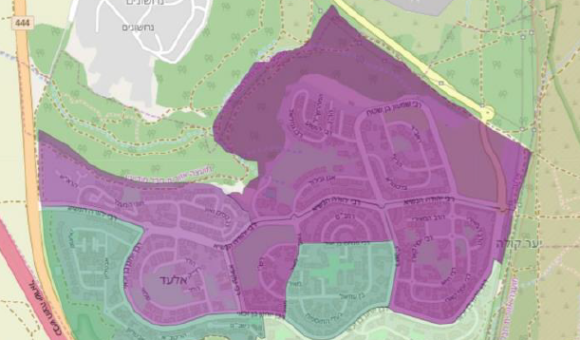


The Data that Helped Arab & Ultra-Orthodox Local Authorities
During the first COVID-19 wave, healthcare bodies lacked the necessary data regarding morbidity rates in the Arab and ultra-Orthodox societies. This is where MAOZ entered the picture
It was Friday night when the phone call came in from the polling company: the first data results about the ultra-Orthodox and Arab cities were ready. The findings were significant. For the first time, it was possible to identify which specific neighborhoods were susceptible to the next outbreak. Dr. Chanan Cohen of MAOZ’s Knowledge & Strategy Center, who conducted the study, called Hila Ganor Schindel, MAOZ VP Knowledge & Strategy and MAOZ CEO, Dr. Yoav Heller: “This data needs to be passed on to the Weizmann Institute, to HMOs, to the Ministry of Interior and to the local authorities themselves.”
This data, which zeroed in on the two societies which have been so difficult to survey and examine, has brought MAOZ’s Knowledge & Strategy Center into the hottest arena of medical data players in Israel. It’s an arena bursting with competition and emotion and full of players backed by scientific knowledge and funding. The valuable information in this community’s hands determines the State of Israel’s policy in fighting the COVID-19 crisis: where to test and address, which guidelines to issue and more. MAOZ’s data has the potential to ultimately determine who lives and who dies.
MAOZ’s small Knowledge & Strategy Center entered this high-stakes arena almost by chance, changing the picture and altering the rules of the game altogether.
It all began when the Prime Minister tasked the Ministry of Interior with dealing with the Arab and the ultra-Orthodox societies during the crisis via the local authority mayors. This responsibility was essentially given to two MAOZ Network members, opening the door for MAOZ to play a part.
We began thinking how we could add the most value. We quickly realized that the first problem was that there simply wasn’t enough data on the situation in the Arab and ultra-Orthodox societies due to a lack of tests. We couldn’t increase testing, but we heard of another way to check for possible outbreaks: surveys that track symptoms and predict where the next outbreak of the disease could be.
Such a survey was of particular importance in both of these populations, especially among the Arabs. The data indicated very little infections among the Arab society, but our hypothesis was that this was only due to a lack of tests.
We discovered that surveys examining symptoms were already being conducted by a number of entities – the Ministry of Health (which had recruited a business analytics company to carry the process out), the Weizmann Institute and the Maccabi and Clalit HMOs. However, very little information had been obtained regarding Arab and ultra-Orthodox local authorities. They just hadn’t been tested effectively.
This information was very important to the Ministry of Interior, as it could help them assist the relevant local authorities. There is where MAOZ, with our strong and tested connection to these populations, could contribute our unique value.
So what’s the data gap when it comes to these populations? And how can it be fixed?
We realized that the source of the disparity lied first and foremost in the survey method – internet surveys. Internet surveys typically see low-response rates among the ultra-Orthodox (some of whom do not have internet connection) and the elderly, who are widely seen as the most important target audience in this epidemic. These surveys pass from one person to another (a model called the “snowball method”), leaving entire populations which are similar to each other out of the sampling.
Chanan had an idea of how to reach the Arabs and the ultra-Orthodox: instead of conducting an internet survey, he suggested to conduct a culturally-tailored telephone survey. People would be called and a recorded message would ask them to answer a very short survey by pressing keys.
But that wasn’t enough. How can people who do not usually take part in surveys be convinced to answer questions? And how can it be ensured that the information is geographically targeted enough in order to serve as a tool for local authority mayors?
The solution which was found – working directly with the Arab and ultra-Orthodox local authority mayors – addressed both these problems.
The goal was to ask the local authority mayors for full records of all the residents who live in each community in order to contact everyone directly and meticulously rather than give off the feeling of a general survey.
We started with four mayors – two Arabs and two ultra-Orthodox. One by one, Chanan and a Knowledge & Strategy Center analyst, Nofar Gueta, called the local authority mayors. They explained the request and the value the work could have for the mayors’ communities – the data would allow them to provide their residents with an accurate medical response. The mayors asked tough questions. For example, they raised issues related to privacy. In response, Chanan and Nofar assured them that information about a specific person would not be kept; only information about the neighborhood and the local authority would be preserved and used.
But our work with the mayors didn’t stop here. We asked them to record the message to their residents, as well as record the survey themselves. “It’s very important for the residents to hear you. They will only agree to cooperate if it comes from you.”
Most of the mayors agreed to record the text they had been given; in some ultra-Orthodox communities, a well-known rabbi recorded the message. In one local authority, the area’s security official recorded himself asking the questions.
The first measure of success was determined by the number of people who answered the survey. Usually, the response rate for such surveys is 5-10%. Our hope was to reach a 15% response rate.
On Friday afternoon, the initial data came in and stunned us. Our bet worked. Roughly 40% of the residents answered the survey – a high number, especially since it is based on all residents of the local authorities and not just a representative sample. We checked the data again after seeing it come through: “It can’t be.”
We urgently requested the survey data itself from the polling company. It arrived at 11:00 p.m. and revealed clear indications: there were differences between neighborhoods within local authorities themselves.
Chanan, who grew up in a religious home, thought the situation over for a moment. “But I didn’t want to waste time,” he says, and so he decided to pick up the phone. “We didn’t think we’d ever talk about work on a Friday,” Hila told him.
And so, overnight, we found ourselves to be major players in the State of Israel’s competitive medical data arena. We decided to become an open source: to pass the raw data on to all the research parties involved in the field so that they could analyze it and generate insights from it to help local authorities and government ministries make appropriate decisions. These players typically compete with one another and rarely share information with each other. Of the players involved, only the Weizmann Institute sees itself as an open source.
We made the initial connection to the players in the field – the Ministry of Health, HMOs and the Weizmann Institute – through Network members.
We called the investigators as early as Saturday morning. The phone calls were made from the kitchen or living room, while on the other side we heard children playing in the background. We decided to make them a generous offer – get our unique data for free in exchange for a commitment to two conditions: 1. That they return the processed findings to MAOZ; 2. Not to publish the data to the media in order to avoid creating negative public opinions.
Everyone accepted the terms. The Weizmann Institute started working at 10 a.m. By that very evening, they had already sent us a preliminary analysis with a map showing five “red neighborhoods” in which there was an indication of the virus’ presence.
We called the local authority mayors who had cooperated with us first in order to personally pass our findings along. One of the local authorities which came up was Umm al-Fahm and so we immediately updated them.
Following the initial data, everyone realized the potential, and we continued conducting surveys. Due to the lack of testing, the symptom survey has become a major tool in national decision-making, along with mapping verified cases of infection.
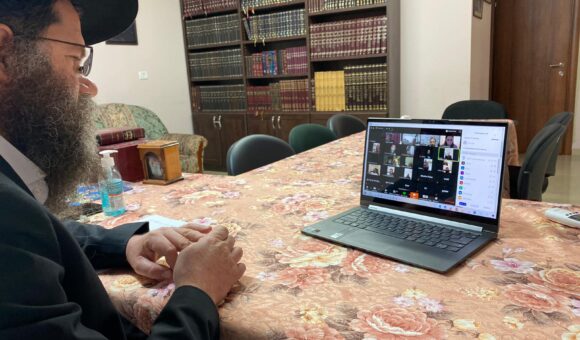


A Special Collaboration: Doctors and Rabbis
How do you convey public health information to the ultra-Orthodox society? With a healthcare response specifically tailored to the unique needs of the community
It was in the early days of the pandemic in Israel, when the only certainty was uncertainty and lack of clarity. What is this virus? How do people get infected and how can they protect themselves?
Much of the Israeli public process the confusing and ever-changing guidelines through broadcasts, briefings and press conferences. But these methods didn’t reach all of Israel’s societies.
Network members from the ultra-Orthodox sector approached MAOZ with an idea that would improve the transfer of information and increase collaboration in the ultra-Orthodox society. How? The healthcare personnel in the MAOZ Network would convey information to the ultra-Orthodox society in a clear and professional manner, explain the guidelines and answer questions with the aim of embedding the guidelines within the community.
Thus a connection was born between members of the INBAR healthcare Network and community rabbis from the ultra-Orthodox society through professional, personal and open conversations that built connections.
Just a few hours later, the doctors and rabbis held a Zoom conference, and the rabbis raised the questions that concerned ultra-Orthodox society: could the mikvahs be opened? How can we prevent infection in educational institutions? And where should we be focusing our attention?
The collaboration continued after the meeting, with talks held in additional communities with the aim of increasing awareness and collaboration.
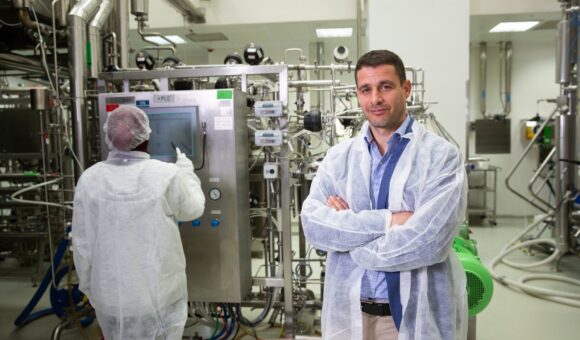


Helping a Small Northern Factory Use Artificial Intelligence
What small factories lack when competing in the global market is access to accessible, high-quality information on production processes and technology. That’s where Oz Katz, Director of the Industries Administration at the Ministry of Economy and Industry, comes in
“What does a factory need to survive the fourth industrial revolution? It’s not enough to have money, good employees, and customers. What it really needs is to learn about advanced production processes, the use of robots, artificial intelligence, and what the competition is doing. But while large factories invest vast efforts and resources into this, a small to medium-sized enterprise usually doesn’t have the availability or resources to learn about and implement these changes. This results in the weakening of small factories, with a third of Israeli plants having low productivity compared to the OECD and being in danger of closing.
It was clear to us, as a government body, that we must intervene in the face of this challenge. We knew that our task was to help factories learn, progress, streamline and take themselves a step further to stay in the game. So a decision was made to establish the Institute for Advanced Manufacturing in Northern Israel, which will provide small and medium-sized industries with professional guidance and advice, and will serve as a knowledge center.
We understood from the beginning that to produce a system that would work in the long-term and work well, we would need partners; so we decided that the institute would be run by a body from the business sector, with minimal bureaucracy and maximum professionalism. Government goals were laid out for the concessionaire, and we established a bonus-based incentive model. A government budget of 50 million shekels was allocated.
I think that’s what’s special about this: I bring with me the government’s initiative and desire to see change in the industry and in the region, but also the understanding that change requires partners. Our immediate partner is the business sector, which brings value to the table that we simply cannot bring ourselves. Therefore, the institute established to provide this service to the factories will be run entirely as a corporate entity, entrusted with administering government funding and implementing the goals which have been set. Our goal is a 30% increase in productivity for the institute’s customers, who are factories with low productivity.
The COVID-19 outbreak made things even more complicated. If small plants have always faced difficulties and challenges, they’re now being impacted by a global pandemic. During a lockdown that includes traffic restrictions, how do workers get to the factory? When there is a directive for only 10 workers indoors, how do you operate the production floor? And if the orders are to work from home, how do you recreate the information found in notebooks and binders at the office?
But it was actually during this period that factories gained clarity about a lot of elements, including efficiency, manpower and productivity. In the year since the pandemic began, over 100 factories have turned to us for guidance and advice. And this is without any advertising or marketing – only word of mouth. Over 60 factories are currently participating in the process.
We call the first stage the road map: a diagnostic process, in which the institute’s representatives visit the factory during its working days and map out areas that need streamlining. It takes about a month-and-a-half, at the end of which the plant manager is presented with a situation report mapping out approximately 15 different challenges. For example, here are some recommendations that might be received at the end of the diagnostic phase: integrating a system of sensors for information monitoring, integrating robot systems, optimizing factory work routines, a control system, and more.
Then we take a step forward, and here comes the challenging part: envisioning how the reality might look different. Will the plant manager be able to picture the change? What will the factory look like with the new technology coming in? What will it look like with the change in management patterns and work routines? It’s not a simple process. At this stage, we assist the factories in the consulting and implementation phase of the projects proposed in the road map that the plant management has chosen to focus on.
In order to fully succeed in this stage, over the coming months, we plan to establish a demo center: a physical space where equipment with the most advanced technology will be displayed. I believe this should become a pilgrimage site for factories and industries, in Northern Israel as well as all over the country, who recognize the need to become more efficient.
The factory manager will arrive with their road map and be able to see with their own eyes what we are recommending, as well as why and how it works. It’s not theoretical, it’s not in a video, it’s not in words – they can actually see the machine, feel it, try it.
And then what? Once the plant manager decides exactly what they need, we will brainstorm together about how to finance it. Part of the subsidy will come from the institute, part from an investment body we’ve set up, and part from the factory itself.
To make real change, we understand that it’s not enough to work on the infrastructure of the factory; one also has to work on its management. So we set up a course for managers, which will offer any manager an opportunity to become a professional and prominent entrepreneur. This is a course of about six months, which will be offered to any manager who has completed the diagnostic phase. The course includes significant and detailed knowledge for the manager and guidance in the implementation of the projects in their road map, among other things, by working closely with a mentor.
The factories, for their part, get high value at an exceptionally low cost: they pay a token fee of 2,000 shekels to demonstrate commitment to the diagnostic program, after which the consultation and assimilation programs are subsidized at a rate of 50-70%.
Recently we understood that a partnership with the business sector is not enough: to fully realize the task we’ve taken on, we need to forge a partnership with academia as well. So the ORT Braude College of Engineering won the bid to operate the institute, together with the Tefen consulting company. We are now working to connect the Technion – Israel Institute of Technology to the project, as well.
This is how, together with our partners, we can make the institute an engine of regional development and turn the Northern region into an international center of advanced production.
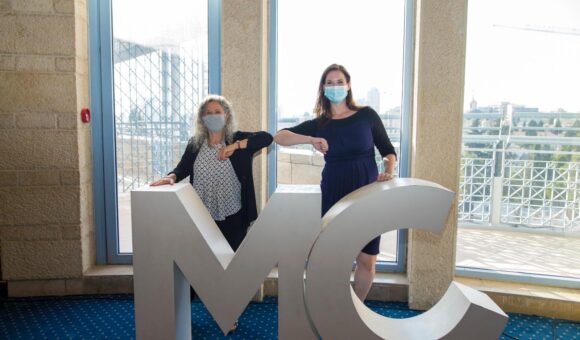


How to Introduce Israeli Startups to American Investors During COVID-19
Startup accelerator Mass Challenge used to fly entrepreneurs abroad to meet with investors. But as the world ground to a halt, CEO Yonit Serkin found a partner: Manal Haddad of the U.S. Embassy, who managed to “bring” America here
“One of the biggest challenges for Israeli startups that wish to succeed overseas is understanding the respective local culture. That challenge is particularly hard for those who lack personal exposure to American culture.
Mass Challenge Jerusalem is Israel’s biggest startup accelerator. We are part of a group of accelerators with the flagship program based in Boston, and our goal is to deliver a nonprofit platform that promotes entrepreneurs who try to solve problems and bring something new to the world. Our role is to encourage entrepreneurship and innovation on a large scale. We select startups that have potential and provide the entrepreneurs with a network of mentors, materials necessary to succeed abroad, and contact with investors.
As part of our program, we take the startups to the U.S. and introduce them to potential American investors. But what do you do during COVID-19, when flying out of the country isn’t an option but foregoing the cultural training also isn’t possible?
This is how a connection was formed between us and Manal Haddad, a MAOZ Network member and a Program Manager and Grants Specialist at the U.S. embassy in Israel. Manal told me the embassy had released an invitation to tender aimed at encouraging commercial ties during COVID-19.
Together we established a program that prepares Israeli entrepreneurs to interact with American culture and markets. The program doesn’t only include the typical entrepreneurs – men who have completed their service in the elite IDF Unit 8200 – but rather, we decided we wanted to help women, Arab citizens, and the ultra-Orthodox, most of whom are real trail blazers.
We came up with a program that will provide them with everything they need, so that when they get on the plane they’ll know what to expect on the other end. Workshops, get-togethers, contact with investors – and it’s all online. The U.S. Embassy is not only a funding partner; it’s a partner in building the program itself. It gives us access to speakers, experts, and connections.
And thus, in spite of – and partly thanks to – COVID-19, a partnership was formed: one that enables us to overcome travel restrictions, and thereby continue to encourage Israeli success in the United States.”
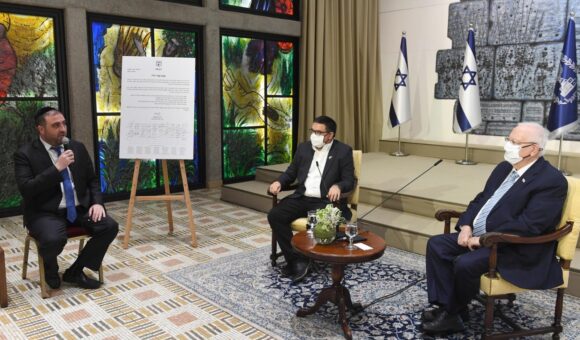


The Knesset Member who Initiated a “Pact for Mutual Respect”
70 Knesset members have signed a pact initiated by MK Moshe Arbel from Shas, who explains: “The goal of the Pact for Mutual Respect is not to abolish differences of opinion – but to preserve mutual respect despite them”
To argue without incitement, to think differently without hatred. This agreement must begin from above – and 70 Knesset members have signed a pact committing to exactly this. Behind the “Pact for Mutual Respect” initiative stands MK Moshe Arbel from the Shas party.
In the pact, the MKs commit to serve as personal examples, to hold fair and honest dialogue and to act with respect, pleasantness and mutual responsibility for one another.
At the ceremony presenting the pact to the President of Israel, Reuven Rivlin, MK Arbel stated: “The goal of the Pact for Mutual Respect is not to abolish, heaven forbid, differences of opinion, which are so necessary in a deliberative democracy, not to abolish, heaven forbid, diversity of thought and not criticism either. Its goal, as written, is to preserve mutual respect despite strong differences of opinion! Its goal is to enable us to struggle over principles without arousing hatred and divisions.”
The President accepted the pact and added: “These are difficult days in Israel. Disagreements have become a political tool, a means for the parties to gather votes. This stands in total opposition to the wonderful pact that you seek to establish as a statement on behalf of the Knesset.”
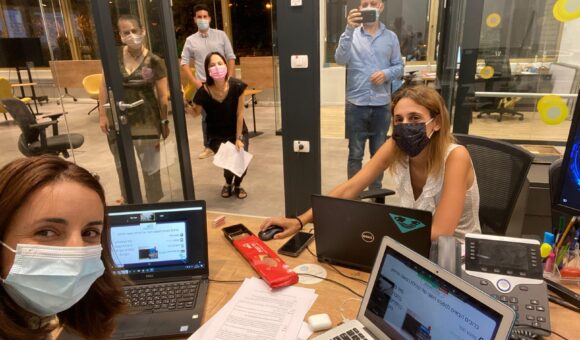


The Telemedicine Revolution Starts with Collaborative Learning
The telemedicine revolution has equalized access to medical care between Israel’s Center and its periphery. To maximize this effect, INBAR members from four different organizations have come together to establish a community
The healthcare system, which has manned the front line of the fight against COVID-19, is in the midst of the biggest revolution it has seen in decades. Hospitals and HMOs are focusing their efforts on COVID-19 patients, but while the rest of their patients may be staying home, they still require care. To meet these patients’ needs, the healthcare system had to make an overnight transition and provide remote services.
The idea of telemedicine is an age-old dream that solves issues such as lack of resources, geographic gaps in access to care, and long waiting times. And now, all of a sudden, the dream is coming true.
Each hospital and HMO has separately made this transition on their own. They found ways to provide medical care, services, and treatment remotely. The leaders who recognized that this was a challenge best faced together were members of MAOZ’s INBAR program: Esti Shelly, Director of the Digital Health Division of the Israeli Ministry of Health; Talor Sax, CEO of digital health investor eHealth Ventures; Oded Shtemer, Regional Managing Director at Leumit Health Services; and Lilach Didi, Quality Assurance Coordinator at Galilee Medical Center. Additional fellows from the program quickly joined them: Professor Arad Kodesh, Head of Mental Health Services at Meuhedet Health Services; Dr. Efrat Gil, Head of Geriatric Service at Clalit Health Services, Haifa and Western Galilee; Chani Sakal, Head Dietitian at Leumit Health Services; and Adi Reisenleiber, Administrative Director at Schneider Medical Center.
Organizations’ needs are indeed unique, and they inevitably compete for funding and patients; however, they also share many professional, technological, legal, and regulatory challenges. Working together allows them to identify solutions together and break through barriers.
The transition to telemedicine is much more complicated than just deciding to have a video chat or phone call. The entire worldview and infrastructure which exist behind the scenes must be adapted to the new world. Which cases are suited for remote treatment, and which aren’t? Which patients are capable of using technology? How can we utilize this change to make things better? What kind of training do the doctors and medical staff need? What new risks does this pose? What technologies are available?
The answers to some of these questions can be found within our organizations while others can be found elsewhere, requiring us to identify them ourselves.
This is why, with the help of MAOZ, we founded the Telemedicine Community – to learn together and develop solutions. To get started, the group researched how medical learning communities, such as the American Telemedicine Association, looked and worked. The first meet-up had over 200 attendees: healthcare executives, hospital directors, remote service managers, and medical personnel working in the field. MAOZ Network members made up 30 of the attendees.
The attendees were divided into the following specialized workgroups: nutrition, psychiatry, gynecology and pediatrics, genetics, geriatrics, general practice, technology, oncology, and rehabilitation medicine.
By sharing personal stories and demonstrations, each group mapped the challenges, the existing solutions, and the barriers, and offered ideas and visions about what could be done.
The transition is highly complex. Driving adaptive change in so many fields at once is no simple matter. But the connections forged in this group will spark solutions and initiatives that will propel the medical field forward, make quality medical care accessible to more patients, and result in unprecedented collaborations between organizations that had previously seemed incompatible.
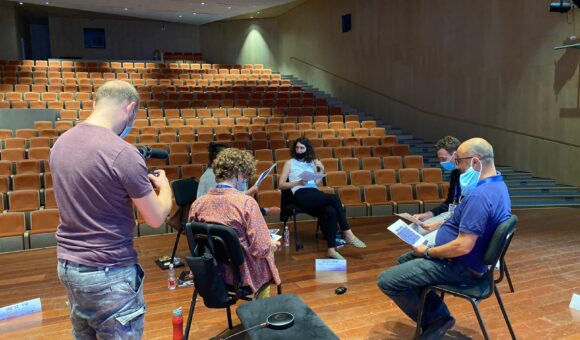


The Unique Partnership between Artists and the Ministry of Culture
Since the beginning of the Covid-19 pandemic, the world of culture has been closed. The Director General of the Ministry of Culture led an exceptional move for a joint thinking day for staff of the government ministry, artists and representatives from the world of arts and culture.
Since the beginning of the pandemic, the world of arts and culture has been closed. Overnight, performances were cancelled, photo shoots were postponed, and tens of thousands of artists and stage workers found themselves with no income and nothing on the horizon.
At the height of the first wave, the Ministry of Culture, led by Minister Hili Tropper and Director General Raz Froelich, a member of the MAOZ network, decided to create an intensive thinking day addressing how to assist the culture industry. What was special about this day? It was planned in cooperation with representatives from the world of arts and culture, who were full partners in thinking about and formulating solutions. MAOZ accompanied the planning day, a “hackathon” with participation of senior cultural workers from every sector in Israel.
The decisive majority of the participants were people who had never even heard about MAOZ. Out of 100 people invited to the meeting, only two were members of the MAOZ network.
As this period necessitates, this event also required creative solutions: half of the meetings took place in person and half on zoom. The ideas formulated were presented by participants in one room – the Director General and the Minister sat in another room.
The situation at the opening was not simple: the participants arrived angry, familiar with promises and disappointments. However, from the first moment the meeting gave them a unique opportunity – to make their voices heard in one room with the decision makers.
So, despite the pain that they brought with them, the event created encounters that would not have happened elsewhere. And together, participants raised creative ideas: a special app to make small performances possible, flexibility for employers and more. And no less important than the ideas: a direct connection was made between cultural workers and the government, one that simply did not exist previously.
Most of the challenges that have been created due to the pandemic are far from resolution. The Ministry of Culture is still working hard to find the right outline, the formula that will make it possible to reopen the world of arts and culture.
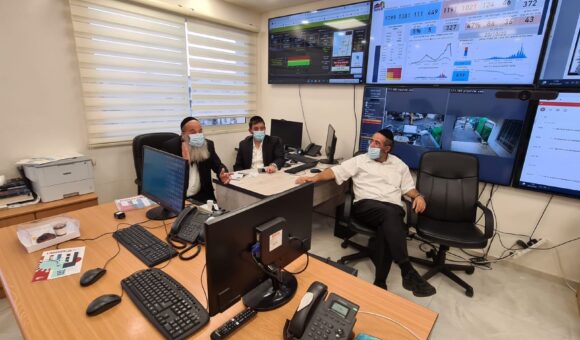


How Good Neighbors Became Bnei Brak’s Secret Weapon
Bnei Brak started an “army” of voluntary coordinators for apartment blocks who do it all – from taking out the trash for quarantined neighbors to saving lives. Their “commander” is Shimi Kashash, Deputy Director of the city’s Education Department
“On Chol HaMoed Sukkot, I picked up my phone: ‘Hello, have I reached the building coordinator?
‘Yes, how may I help?’ She asked.
‘Listen, there’s a woman in your building who’s lonely. Her son has had to isolate and there’s no one to visit her and bring her food. Could you take care of it?’
‘Gladly’, she replied. ‘I know her. I’ll call my daughters now and they’ll take care of it.’
I heard noises in the background, so I asked if this was a bad time.
‘I’m just in the delivery room, but it’s my job. I’m on it’.
I apologized and told her there was no need, but she insisted that it was her duty. She, along with 3,800 other volunteers, are the ‘secret weapon’ of the residents of Bnei Brak in the fight against COVID-19.
We all remember Bnei Brak in the first wave of the coronavirus. Masses of infections, the Passover Seder being just around the corner and uncertainty reigning throughout the city. The Municipality wasted no time setting up a Situation Room, which was led by Arik Adler, MAOZ Network member. The first thing he did was receive status updates from the field. Residents called us about everything ranging from how to celebrate the holiday to understanding whether they needed to be in isolation. The 106 hotline (for municipal matters) was reinforced with external operators, but we had no idea how to give each individual a personal response, and how to keep our ears to the ground.
Bnei Brak has no neighborhood or community administrations. The communities belong to rabbinical courts, and rather than being concentrated in one place, they’re spread throughout the city. The question remained, how do you reach each and every resident?
The Mayor called in his team, and then an idea surfaced. During the election campaign, every party had voluntary field coordinators. Each coordinator was responsible for a building – they would show up there and convince people to vote. With that being the case, we realized: the volunteer infrastructure was already in place – all that was left was to recruit them. We convened an urgent meeting with all the political parties, all of whom agreed to share their volunteer database with the municipality, which was an unprecedented act. Within a matter of hours, we had 1,300 volunteers standing by.
At that point, Arik Adler and the Mayor called me into an urgent meeting. ‘Shimi, in addition to your regular work, you have a new mission – organizing building coordinators. Good luck!’
My first challenge was to recruit more volunteers. This was where the local charity organizations helped. The remaining coordinators we recruited by going from street to street and hanging up posters which read ‘coordinator needed for this building – official representative of the municipal Situation Room’.
When we had recruited 3,800 coordinators, we decided to take a step that would emphasize to them that, while the position was voluntary, it was nonetheless official, serious and of critical importance. We officially certified them for the role. Each building coordinator received a package to their home with a letter of recognition and a detailed leaflet with all the contact details they might need.
The coordinators’ responsibility is to inform their neighbors that they are the point of contact for matters pertaining to COVID-19. They then send the issues that arise over to us in the Situation Room via a dedicated extension on the 106 hotline set up specifically for them. This process makes it easier for us, as we are more effective when working with 3,800 people rather than with 200 thousand residents.
The coordinators receive regular updates from us regarding the situation in the city, and when one of their neighbors has to isolate, they help them by taking out the trash, doing their food shopping etc. This is a simple solution that gives residents a feeling that there is a municipal representative within their building. They know that even when they are in isolation, they’re not alone.
The project came about due to COVID-19, but we have discovered that it also provides solutions to other needs. During a recent weekend, we received a call from a woman who was in a state of psychological distress. The welfare services took a bit of time to arrive, and every second in these situations has the potential to become a matter of life and death. Working with the welfare services, we called the building coordinator, who went over to the neighbors’ apartment – and within two minutes, we had spoken to her and put a professional service provider on the line with her. We saved a life, no more and no less.
There’s a saying that ‘what works well in routine will work well in emergency’. In Bnei Brak, we learned that the opposite is also true: ‘what is created and put to use in emergency will be beneficial also in the routine’. Over recent days, the infection rate in Israel has increased, and a third nationwide lockdown is already in the air. I have prepared the coordinators for whatever comes next.
But even after the pandemic ends, this change will not disappear. A city with no neighborhoods and no community administrations created individual ‘building communities’ with a sense of mutual responsibility.
And that, in my opinion, breathes new life into the saying that ‘it is good to have a neighbor on-hand’.”
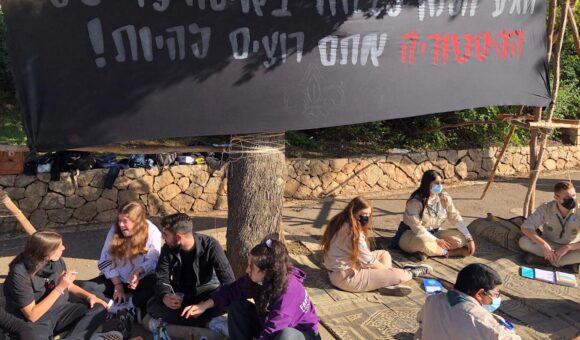


Zoom Instead of Summer Camps and Fire Ceremonies
The coronavirus crisis significantly harmed scouting in-person activities. The Secretary General of the Israeli Scouts, Cali Cohen, was happy to discover that while the movement leadership still didn’t know what was happening – the youth were already taking part in full activities at a distance.
From the moment we got into this crisis, it took us some time to understand that the existential heart of the Scout movement had been taken from us.”
The field responded much more quickly than we did. The children understood that we would move everything to the virtual space, with which we the adults were not as familiar. It took us 48 hours to move all the guiding activities to the virtual space and we created a new arena where we operated the whole array of activities virtually.
The insight that we were really at the start of a huge crisis happened on the eve of Pesach, when we understood that our Pesach operations were canceled and that we were in the middle of a rolling crisis that imposes challenges and difficulties we had never encountered before. This also meant a heavy economic crisis, because of the cancellation of activities and cuts in government funding, and therefore we were forced into a move toward freezing activities and furloughing staff.
It is clear to us now that our reality has changed. We will be meeting in small groups for a long time. The whole organization is learning to work with a much thinner headquarters staff and with fewer meetings in the field. And remember, this is an organization that is usually based on longstanding traditions.
Our decision-making processes have become much faster. But that doesn’t dissipate the fog, and that’s the key problem. We are coping each morning with what each day brings, and we are only able to define what the next day will look like.
Before the crisis, I was in a very strategic place, thinking and planning for the long term. And suddenly: boom. Everything gets put in the drawer. To reopen the drawer, the boat needs to be sailed into a safe harbor. And therefore, right now, we are totally in survival mode. When we get to a safe harbor, we will open the files again and start planning for the coming decades.
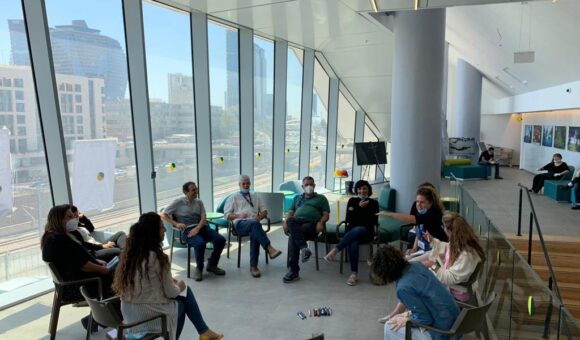


Who Looks After Businesses When the Nonstop City Stops
When the pandemic caused businesses to close overnight, business owners in Tel Aviv discovered that support came from an unexpected source: the Municipality, in an initiative led by Alma Shiran, Director of the Community Administration for the Southern part of the city
What makes Tel Aviv what it is? For some it’s the local restaurants, for others the neighborhood cafés, new juice stands, old barbershops, and so on. Residents give the Tel Aviv-Jaffa Municipality top marks in its satisfaction index. But business owners, who play such a vital part in shaping the city’s character, are less satisfied.
The Tel Aviv-Jaffa Municipality has always invested significant efforts in its residents. For its businesses, however, it has mainly presented requirements: licensing, property taxes, collection. Even before the arrival of COVID–19, the Municipality understood that its relationship with businesses needed to change. So the Business Division was transferred to the umbrella of the Community, Culture and Sports Administration. But before the administration had time to implement changes, the pandemic began and changed everything. Businesses were closed, the city went dark, and the air filled with despondency and trepidation.
The Tel Aviv Municipality realized that it had to take immediate responsibility for the businesses, which are an essential part of the city’s landscape, and some of which are owned by residents of the city. Alma Shiran, Director of Community Administration for the Southern part of the city, turned to MAOZ for guidance. Together with Director of Community Administration, Ronit Farber and members of the administration management, including Network member, Michael Vole they began the process. The first important step was hearing from the businesses: business owners shared their thoughts with the Municipality, often challenging it. They talked about the difficulties they experience and identified opportunities for improvement.
The Municipality quickly formulated a proposal for an intervention which includes 21 immediate actions that could help businesses recover. The community administration mapped out what a response for these businesses should look like, thinking about how to work with them and how to create a community of businesses.
The program resulted in the start of a learning process which was followed by a process of implementation. A new unit was established, and five new workers were recruited for it. The cost the pandemic has had on businesses cannot be erased. But for the first time, they’re receiving a response and benefitting from the Tel Aviv-Jaffa Municipality’s new attitude.
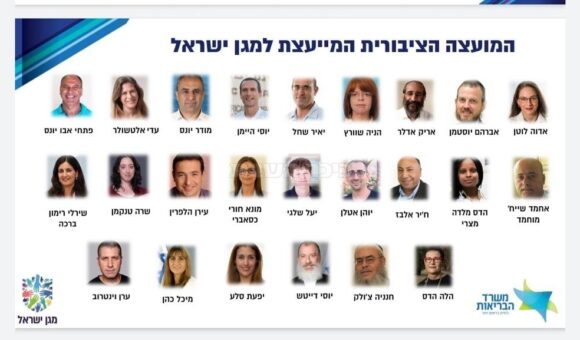


The New Contract between the Public and the Government Starts Here
How do we ensure that COVID-19 regulations are appropriate for the living conditions of all population sectors in Israel and that they remain practical? Dr. Shlomit Avni from the Ministry of Health has established a public council with members who represent all population sectors
“Due to deteriorating levels of public trust, infection rates are on the rise”, said Professor Ronni Gamzu at the Magen Israel headquarters when he first began his position as the national COVID-19 Project Coordinator. His mission, he declared, was “to form a new contract between the healthcare system, the government and the public… From the government’s side, the new contract means transparency, professionalism, relevance and communication”.
To execute this task, Professor Gamzu decided to establish a public council with representatives from all sectors of the population. This mission was put under the care of Dr. Shlomit Avni, Director of the Department for Policy Planning in the Ministry of Health’s Strategic Planning Administration.
With MAOZ’s assistance, she consolidated the list of experts – including representatives from the ultra-Orthodox and Arab societies, and civil society organizations representing groups such as the elderly, people with disabilities, youths, residents of the country’s peripheral regions and more. The council’s role was and remains to assist Magen Israel in consulting and reviewing the regulations set by the Ministry of Health according to indices of fairness, practicality and clarity.
Council meetings are attended by the COVID-19 Project Coordinator, Head of Public Health, Dr. Sharon Elroi-Preis, a MAOZ Network member and the director of the Magen Israel headquarters. The council uses its professional and community networks to enhance public trust, identify gaps and needs on the ground, and rekindle hope and solidarity.
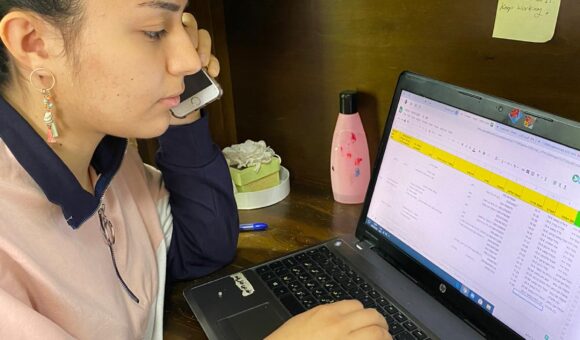


When the Residents Are in Distress and the Hotline is Blocked
The emergency hotline in Jisr Az-Zarqa was blocked on many residents’ mobile phones, and nothing seemed to work. One message in the MAOZ WhatsApp group solved the problem for Anat Nehemia Lavee, CEO of Edmond de Rothschild Partnerships
“In ordinary times, our mission is to develop young leadership in the periphery; we work with thousands of young men and women in towns, villages, local councils, and cities, from the North to the South. When the pandemic arrived, it was clear to us that this same mission was still relevant – maybe even more so than ever.
We looked for partnerships with other organizations in the periphery that had a regional outlook. Then we made a connection via Network member, Roni Flamer of Lev Echad (One Heart), which operated emergency hotlines in a number of local authorities.
Lev Echad had a challenge: how to start operating in Arab local authorities for the first time, in communities they were unfamiliar with and who were unfamiliar with them. This is exactly where we had an advantage, as we had already been operating with young local leaders in dozens of Arab local authorities.
So we started working with Arab local authorities all over the country, setting up hotlines to which residents, who were now shut inside their homes with their families, could call.
We set up just such a center in Jisr az-Zarqa. We were assigned a building by the local authority, recruited volunteers from our Masar leadership program, and purchased a telephone number which would serve as an emergency line for residents to call.
At the same time, we launched a public information campaign to communicate with residents about the virus and stress the importance of quarantining. The campaign helped the local authority remove itself from Israel’s morbidity map and helped persuade infected locals to go to quarantine centers. We also distributed thousands of food parcels, games, and children’s activities to help residents in need.
After a few days, however, we realized that we had a problem: we started hearing about residents not being able to reach the hotline. They would call our new phone number, but the number was blocked. It turned out to be a malfunction on the provider’s end. This technical difficulty resulted in a great deal of urgent calls, as well as many requests for basic food products and baby formula that simply weren’t reaching us.
We figured that this problem would be easily solved. How hard can it be to unblock a phone number? But a few hours went by and we were unable to resolve it. A day passed, and then another day, and still we had no answer from the communications company. The line was blocked, and residents were unable to contact the center.
So I sent a message to the MAOZ Network WhatsApp group and asked: ‘does anyone have ideas? Can anyone help?’ A minute passed, and then a message arrived, and then another and another. Everyone offered their own channels of support.
One Network member suggested I consult with another Network member. I called him up and he put me in touch with his contact (who was not a Network member).
I called and he put me straight through to the CEO of the relevant communications company. He promised to take care of it immediately, and within half an hour the phones at the hotline started ringing again. The block on the line had been removed, and hundreds of residents were now able to reach us.
All it takes is a small connection; activating people in the right places and rallying to help each other, because we’re all ultimately working toward the same goal—helping Israeli society respond to this emergency.
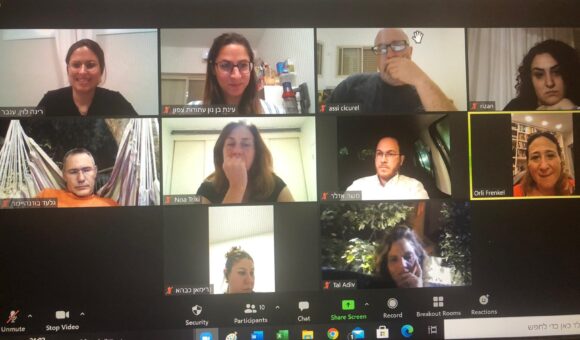


Behind the Scenes of the Healthcare System
Managers consulting managers: how does the head of a hospital make decisions, and who does she consult with? Who shares the burden? And where can they meet?
During this intense period, members of the INBAR Network — hospital directors and administrators from throughout Israel — decided to create a forum in which to brainstorm and share insights on urgent problems, some of them shared by all and others similar to one another. Should family visits be allowed in COVID-19 wards? Perhaps only to enable family members to say goodbye? These are questions that extend beyond a single manager, and the forum provided all participants a space in which to deliberate, learn, contemplate, and even feel less alone.
The forum has been supplemented by an additional one — this one led by community health providers, and similarly rooted in a deep sense of trust. Managers from all the different HMOs, both from headquarters and fieldworkers, have decided to make room in their agendas for a degree of collaboration without forgetting the differences and competition that exist outside the forum. After all, it goes without saying that every clinic has to endure the realities of COVID-19, maintaining protocol and minimizing isolations and infections.
These forums uniquely illustrate how mutual connections between Network members can positively impact their ability to do their jobs.
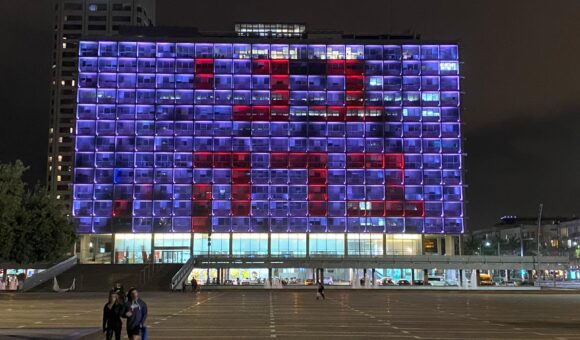


Bnei Brak, You’re Not Alone: Tel Aviv, Petah Tikva and Kfar Qasim in a Demonstration of Support
At the peak of the first COVID-19 wave, when Bnei Brak was in a bad state and was receiving sharp public criticism, Network members from local authorities initiated a demonstration of support for the ultra-Orthodox society
It was the peak of the coronavirus outbreak in Israel, with infection rates in Bnei Brak and other ultra-Orthodox communities at its height and accompanied by significant criticism on social media and in the press.
But MAOZ Network members chose to echo something else at this difficult time. They decided to express support.
It started as a local initiative and spread just like the virus, each person infecting the next. A Network member from the Tel Aviv Municipality convinced the mayor to display a public gesture of support: the Tel Aviv City Hall building was colorfully illuminated with Bnei Brak’s name and the symbol of a heart. With the encouragement of additional Network members, public statements of support were also issued by the mayors of other cities, including Hadera, Bat Yam, Efrat, Petah Tikva and Ramat Hasharon.
An extraordinary tribute came from the Arab city of Kfar Qasim, which published a letter of support to the mayor of Bnei Brak titled, “We’re all in the Same Boat During the Pandemic”.
In Yeruham, signs were posted to bolster the spirits of the city’s residents and its ultra-Orthodox community: “Sending love to our very special ultra-Orthodox community, who are deeply concerned about their relatives in Bnei Brak and Jerusalem.”
And it wasn’t a one-way street: ultra-Orthodox Network members decided to use the opportunity to connect their community, which ordinarily keeps to itself, with the general public. “News from Hadrei Haredim “, the Facebook page of an ultra-Orthodox news outlet which usually only publishes content about the ultra-Orthodox public, made an exception and shared a video of support from the secular mayor of Petah Tikva.
On Passover eve, leading rabbis from the ultra-Orthodox community launched an initiative that, unusually, targeted the secular public as well: they called on everyone who observes the seder to go out to their balconies and sing “ma nishtana” at 8:30 p.m.
The proposal was adopted all over the country, in ultra-Orthodox, religious, and secular local authorities alike. And on the night of the Passover seder, millions of children went out to their balconies to sing at the same time.
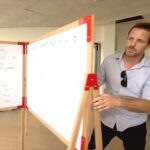


It Started with a Teacher Who Wouldn’t Turn Her Zoom Camera On & Ended with an Educational Celebration
At the beginning of the COVID-19 crisis, Ben Erely, the Ein Gedi High School Principal, understood that the majority of the effort would have to be invested in the teachers. It started with delivering computers to their doorsteps, and ended with teachers promoting new ideas together
“In one day, the rug was pulled out from under the teachers’ feet. They suddenly had to reinvent themselves overnight with no training, and essentially forget everything they’d learned“.
I’ve been managing the school for four years now and over that time, we’ve made great changes to empower and train our teachers. We created pedagogical programs, sent them to continued education programs abroad and really invested in every aspect of the school. Our view is that if teachers don’t change their personal habits of their own volition, no external force will make them change.
These are the insights I had when COVID-19 began. We decided to work hard on empowering our staff, based on the assumption that by empowering our teachers, we would be doing the same for our students.
We worked with them on the basis of four guiding principles. First of all, we kept their routines going – we decided to continue as usual.
We gave them emotional, material and social support. For example, I personally came to each of their homes to give each teacher his or her own computer. We scheduled our meetings at times that were comfortable for them and created personal programs to demonstrate that we see them and think about them.
On the professional side, we gave them responsibility and encouraged their entrepreneurial spirit. We put together work groups to support teacher-led initiatives and offered teachers the opportunity to participate in the initiatives that were of interest to them. This resulted in many work groups being created voluntarily, from one day to the next.
The technological gap became very clear to us during the crisis, requiring special attention. We discovered a huge disparity between teachers: some of them had previous experience and adapted very smoothly. But others were really frustrated with the technological challenges. One teacher experienced a deep crisis resulting from the fear of teaching from home. One of the ways we dealt with the technological challenge was through an environment of sharing. Whenever a teacher found a new feature on Zoom or a new and interesting technological way to teach, he or she would immediately share it with the rest of the faculty and help the rest of us. Today we have a very strong team full of initiative. And most importantly – we managed to bring a great deal of happiness into the teachers’ lives. These are not simple times and the challenges continue, but after nine months, we’re finally feeling optimistic.”
How Do You Say “Social Distancing” in Arabic?
Members of the MAOZ healthcare Network organized a special day of filming to create short Arabic-language public service announcements
Following the initial outbreak of COVID-19, the first challenge was to instruct citizens what to do and why. Formal guidance and restrictions were first published in Hebrew, followed by gradual translations into Arabic and other languages.
However, members of the MAOZ healthcare Network believed that mere translations were not sufficient: for Arabic-speaking citizens to truly understand, the messages needed to be adapted and communicated appropriately.
MAOZ Network members rose to the task: Dr. Rami Grefat, Adel Iktelat, Ahmad Muhana, Dr. Anan Abbasi and Prof. Rabia Khalaila worked together to articulate the precise messaging. The Network members took the Arab society’s unique cultural makeup and circumstances into account.
Together, they participated in a day of filming to create a series of dedicated short videos in Arabic that were distributed among the Arabic-speaking public and which received widespread exposure.
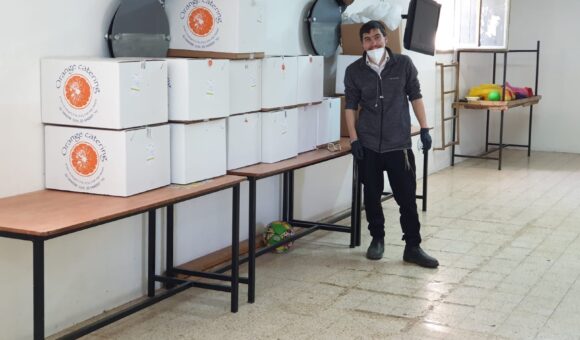


How My Familiarity with the Haredi Community Helped Us Cope with the Pandemic Locally
Kosher catering and agreements with the local Rabbis: Aviya Kedari, Director of Social Services in Gush Etzion, tells the story of how his participation in MAOZ visits with ultra-Orthodox communities, helped him forge a partnership with the ultra-Orthodox residents in his municipality
During this period in which coping with the corona pandemic and its spread among the Haredi community and crowded neighborhoods is in the headlines, we want to tell a different story. A story of success in analyzing the challenge, a story of partnership in finding solutions and most importantly, keeping “the work at the center.”
Over the past year, in the framework of the network, we took a journey to get to know the Haredi community. The journey was the continuation of familiarization and desire to learn and find out how to provide appropriate services to the community.
I am certain that it contributed to the way we approached management of the “corona challenge.”
The Gush Etzion Regional Council numbers 24 diverse communities: secular, religious, mixed, kibbutzes and among them, Haredi towns. Meitzad is a Haredi town that numbers 500 residents, 110 families, at the end of the road on the frontier of the Judaean desert, located on the tributaries of Nahal Dragot, a community full of joy and Torah. The geographic challenges have made this small community unique.
The characteristics of this small Haredi community: The number of children under 12 is 280, more than half the residents of the town, the number of adults over 61 is only 11, a small number due to the settlement characteristics. 25 families are known to the social services, constituting nearly a quarter of the residents. The socioeconomic rating of the town is 1 (on a scale of 1 to 10, 1 being the lowest).
After the Purim Holiday (10.3.20), the Regional Council began to formulate a picture of the situation and saw that the direction we were going was not positive. The level of pressure that the residents were under was high, the leadership was confused by unclear directives at the national level and the Regional Council had not yet begun working in a special format.
Only after Purim did the Regional Council begin to work on assessing the situation and moved to working according to emergency procedures.
Timetable:
- Purim March 10 – community megillah readings and parties were still permitted and limitations were not in place before the holiday.
- March 18 – 5 people in quarantine
- March 23 – 55 people in quarantine
- March 27 – 10 residents with coronavirus
- March 29 – 18 residents with coronavirus and dozens in quarantine
What were our guiding principles? To work with the local leadership, not to replace them or to work over their heads but with them.
To understand the differences and the challenge of transmitting information to residents – to prepare appropriate means of communication and to be aware that the population is not exposed to WhatsApp or to news channels at the same frequency as other sectors. Appointment of an eloquent speaker from the community for internal communication. Increasing attention to the local newspaper and adaptation to the situation.
To enlist the community rabbis and the various thought leaders to make difficult decisions such as closing the synagogue and canceling the minyans, before this happened in other communities.
To solve disagreements within the leadership and to enlist everyone to put “the work at the center,” a little mediation and a little liaison work and seeing the whole picture.
To become familiar with the internal language and what is important to the community. The concern about lack of food, the need for large food baskets, Pesach approaching, the appropriate level of kashrut.
Direct communication with grocery shop owners to understand the best way to help them preserve a suitable inventory.
To obtain food for all the town residents from the welfare department due to the number of ill people and the socio-economic level of the town. The goal – to assist the residents in maintaining the strict closure.
To make efforts to bring catered meals from a vendor and a kashrut level appropriate to the community. Not to try to convince people to “give up on” their level of kashrut but rather to understand that in order to achieve cooperation we need to listen and not to “educate.”
To enlist the national government, the supervisory level of the Welfare Department, to understand the challenge and the proposed solution – the Jerusalem District administration helped and fought for the residents.
Food distribution was conducted by entities within the town, a national service volunteer who lives and works in the town during regular times, assisted by groups of volunteers. Empowerment, resilience, maintaining community activism, formulating a list of recipients with the assistance of town staff.
As of April 5, 2020, the number of residents in quarantine had decreased by dozens and the closure guidelines were still being observed.
Residents who were diagnosed with the illness had begun to receive their first and second tests in order to check whether they had recovered. Due to the physical distance this was a challenge for which different entities were enlisted to help. We know and believe that all the steps taken stopped the spread of the disease and brought the community onto a track of recovery.
What can be learned from this case for other places? Respect and attention to local leadership. Shared leadership with a clear goal – to put the work at the center and not fights about respect, blame and credit. To understand and formulate the needs of the Haredi community – to provide appropriate solutions.
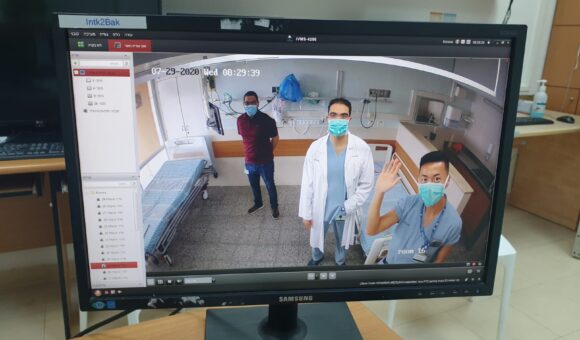


Hospitals Are Struggling. So How Can We Create Resilience Within Them?
Hospital wards have always had a clear hierarchical structure – there are doctors and there are nurses. Dr. Shani Brosh, from Carmel Hospital, realized that the pandemic offers an opportunity to change that
Everyone is talking about the risk of the healthcare system collapsing, and that we won’t be able to treat acutely ill patients because we won’t have enough beds or respiratory machines. But the real problem is different: we don’t have enough personnel to deal with such a large amount of patients in complex medical states who require long and unclear hospitalization. Even when staff members are highly motivated and prepared to push full steam ahead, the emotional overload and burnout still weaken them.
A COVID-19 ward is like a battlefield full of confusion. Think about how medical staff are being pulled out of their regular departments and transferred into a different work environment. They are unfamiliar with the place; they don’t know the rooms, nor their colleagues. On top of that, add limiting protective gear – they can’t see or hear properly and they’re increasingly dependent on each other to accomplish their tasks. And all of that under intense, round-the-clock working conditions in the midst of an unknown pandemic, with the accompanying fear of being exposed to the virus, having to quarantine or contracting it.
As the waves grew higher and higher, the entire hospital, including all of its various teams, became a frontline. No one is immune. Visitors and staff members themselves became the immediate suspects in any case of exposure or infection. There were periods during the summer when we had 130 staff members in quarantine. It forced us to start the migratory season early and move staff members between departments. Moving them out of their usual environment makes it harder for staff and reduces their motivation. This crisis requires each of us to deal with long periods of ambiguity and act in situations of uncertainty. This is the situation with the virus: we know very little, and even what we thought we knew is changing. Making decisions now requires double the boldness and responsibility. And this greatly enhances the risk of burnout.
There is another side to the coin, however – the sense of shared fate and ‘togetherness’. By dealing with staff members’ feelings of loneliness, we can build resilience. Medical staff resilience is built when they feel that they are not alone – they have someone to trust and work alongside.
So how do we build resilience among medical staff during COVID-19? To understand that, I think we need to look at the bigger picture.
Hospital wards have always had a clear hierarchical structure – there are doctors and there are nurses. Only a doctor can do certain things, and it’s clear to everyone that there are certain things that only a nurse can do. They occasionally work together, but most of the time, they work separately. Sometimes, they don’t even know their colleagues’ names.
The COVID-19 wards that were set up overnight created a slightly different dynamic. Doctors, nurses and other hospital workers came from various departments and created a diverse human mosaic.
Due to the risk of infection, we tried to limit the number of staff members coming in to the ward each time. This was a game-changing move that essentially created a situation where each staff member was actually exposed to the other’s tasks. Suddenly a nurse who came in to check a patient’s vital signs stayed there to give another patient respiratory physiotherapy. A doctor who came in to check on a patient turned into a chambermaid, making patients’ beds. Another doctor checked vital signs and fed patients.
The flattened hierarchy allowed in a sense of basic humanity. Staff members saw and felt each other and the power and meaning of different and complementary roles. They built trust and learned to rely on each other. I believe that these feelings dispersed the sense of loneliness and reinforced the team’s ability to overcome great challenges.
Upon returning to their standard departments at the end of their time in the COVID-19 ward, doctors and nurses passed on the powerful sense of what they had been through. Each made friendly gestures within their own area and dedicated time for activities that contribute to informal meetings with staff members. All that was left to do was to keep spreading this message along the hospital corridors.
We continue to work on our staff’s resilience. Recently, with MAOZ’s help, we held resilience workshops at the hospital, as well as a management morning meeting entirely dedicated to this issue. Despite the hospital staff’s busy schedules and all of our urgent ongoing tasks, it’s clear to me and to us that we have to stop for a moment, and make space to enhance our resilience as individuals, as well as that of our teams. ‘May we be good and ready for the days ahead of us…’ as a Hebrew song goes. And us? We’re ready for our next challenge!”
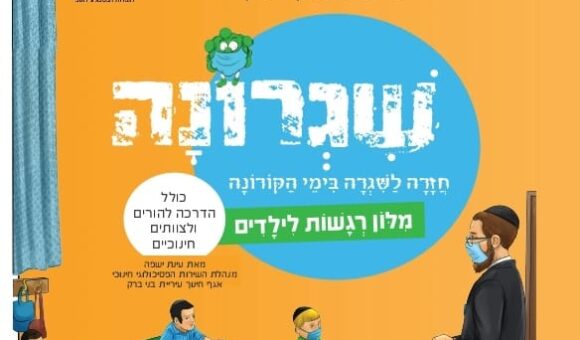


The Book That Helped Bnei Brak’s Children Go Back to School
Without internet or Zoom: Network member Einat Yashpe, Director of the Educational Psychological Service in Bnei Brak, has found creative ways to reach children’s hearts
“With the outbreak of the coronavirus, the system was fully galvanized. As always happens in an emergency, we entered a state of action. But then we discovered that all the rules had changed. Much of what we knew and recognized was no longer relevant. The first thing that disappeared was our natural workspaces. And what’s a psychologist supposed to do without a therapy room or without direct contact with the patient?
While the local authorities were still dealing with the question of whether educational psychologists are essential workers, the Bnei Brak Municipality was the first to answer in the affirmative, defining us as essential.
In trying to find solutions, we looked around at other local authorities, and it felt that we’d had a bucket of ice water dumped on our heads. We felt confused, frustrated, and even a little jealous. Zoom therapy, communicating with residents via Facebook, computers in every home… they had found solutions that we knew we could not implement due to the nature of our community.
We realized that in our community, it would have to be done differently. So we took a break for a few days to think about what we could do, and it ultimately made all the difference.
We discovered that alongside the nothingness and the prevailing uncertainty, there is a lot of ‘something’. There is knowledge and connection and communication between us and the community. And these are great starting points to work with from within a state of uncertainty.
Let’s start with what we knew about the community.
It’s a society with habits and customs and extensive infrastructure for community-based assistance, such as charities, interest-free loans, and hotlines. It was clear to us that we needed to identify and build on existing systems, rather than turning to new solutions that people could view as a threat.
We also knew that there was no digital infrastructure, on principle rather than for technical reasons. This challenged us to find another solution.
And what did we know about ourselves?
We knew we had a vision: to develop an emotional language among the children of the city in order to help them build resilience. We also knew that we had a lot of knowledge about emergency intervention and that we knew how to pay attention to what was going on in the field and build tailored responses.
And what did I know about myself?
I knew that the harder I try, the harder it is for me to develop solutions; but when I let go, it just happens.
Our biggest challenge was at the end of the first lockdown, when we had to prepare the parents and children for going back to school.
Then, one Friday morning, while I was cooking in the kitchen, I thought of Chaim Walder, a popular children’s author in the ultra-Orthodox society who writes a lot about emotions and the importance of expressing them. I know Chaim and we have collaborated in the past.
So I decided to call him and suggest an idea: to publish a booklet that prepares parents and children for a return to normal during the pandemic.
He promised to think about it, and within an hour, he called me back and we started planning what the book would look like. By Sunday morning he had already sentme a draft.
The final challenge was to find partners in the Municipality. This required stepping out of my comfort zone, but I felt a sense of urgency. I knew that the hourglass had flipped and time was running out: if the children returned to school before the booklet was released, we wouldn’t be able to prepare them properly.
So we started with the Mayor’s office, and he volunteered to write a warm introduction. We roped in entire municipal departments, dealing with crises as they arose. But while we had hoped to distribute 40,000 booklets to every child in Bnei Brak, I only received permission to print 7,000. We had to compromise and decided to first distribute the booklets to kindergartens.
The impact was enormous. All around the city, people were talking about the booklet that Chaim Walder had published with the Psychological Service. Teachers in kindergartens where the booklet had not been distributed asked to receive it. Municipal employees applied for a copy for their own children, and the booklet’s circle of influence expanded. In the end, it was decided that any care package sent to a family quarantining in the city would also include our booklet.
And so, with a bit of creative effort, we were able to lower the level of anxiety in both children and parents. We did it in a way that is unique to us: I call it ‘low-tech – high-impact’.”
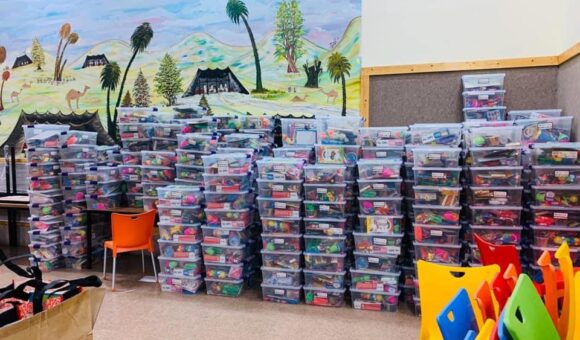


How to Learn Remotely with No Computers or Internet
When most of the country switched to remote learning, children in Bedouin communities, East Jerusalem and Arab towns with no internet access were
left without a solution for their education. In a unique partnership, MAOZ Network members created textbooks for them
When the education system closed during the first COVID-19 lockdown, screens at home lit up and children switched to remote learning.
But how could a student in a Bedouin village in the South participate in this new normal? And what could a student in the Arab village in the North without internet do?
MAOZ’s Situation Room received many calls from Network members regarding children who lacked computer and/or internet access. This gave rise to a unique partnership: coming together to create, print and distribute an educational content textbook in Arabic throughout the country.
Eight Network members and eco-system members participated in the project: Nizar Sarhan, Eli Meiri, Gamil Sharqiya, Adoreh Eless, Foad Zeadna, Yousef Alamour, Kawther Sarsour, and Ali Al-Hawashila. They had never met before and did not know each other previously.
Together with Noor Abed El-Hadi, an additional Network member, the partners put together and edited nine textbooks for children aged six to 12. The finished products included worksheets gathered from different schools around the country, and two of them were intended for children with special needs and/or disabilities. The textbooks were then passed on to a team of volunteers who distributed them in Arab and Bedouin towns from North to South.
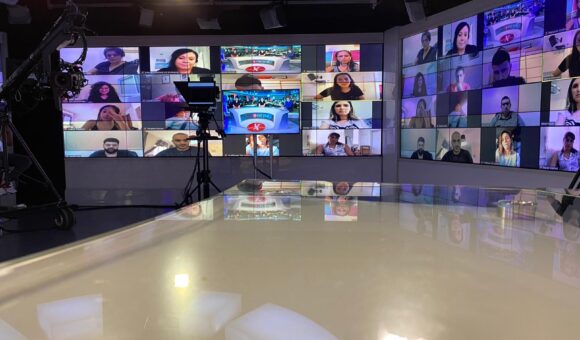


New Partnership to Integrate Arab Journalists into Hebrew Media
After 20 years as a journalist, Yehuda Shohat decided it was time to open a pathway into the media for Arabs too, and created a course in partnership with Network member Manal Haddad from the United States Embassy
“As a journalist, I realized a long time ago that there weren’t enough Arab journalists in major Israeli media outlets. In fact, there are hardly any at all, and the one or two who have managed to find their way in are only ever sent to cover the Arab society.
I decided to change the situation, so I opened a course to train Arab journalists in partnership with Yedioth Aharonoth, ynet, and I’lam – The Arab Center for Media Freedom, Development and Research, with support from the United States Embassy. I teach the course alongside former ynet editor Yon Feder. Our list of guest lecturers includes leading journalists from Yedioth Ahronoth, like Nahum Barnea, and ynet editor Dror Amir, as well as Channel 13 commentator, Baruch Kara.
The course runs for 16 sessions, with 14 of them focusing on journalistic topics, and the other two, taught by MAOZ, focusing on listening and narratives, skills every journalist must master to better understand the people he or she writes about. Additionally, all course participants are given assignments, such as journalistic investigations to carry out and articles to write. I mentor the participants as they carry out their assignments, and the final products are featured in various media outlets to change the public perception of Arab society and strengthen its presence in the Israeli media.
One of our key partners for this initiative is MAOZ Network member Manal Haddad, who serves as the Program Manager and Grants Specialist at the US embassy. The embassy supports the course as part of its mission to promote young leadership, media freedom, employment, coexistence and equality in Israeli society. Manal is already planning to invite some of the participants to embark on an American journey, a tour of the world’s biggest, most influential media systems, which will take place once the pandemic ends.
The course has several key objectives. The first is to ensure that as many of the 13 participants as possible will be hired by leading media outlets to cover diverse topics – not just the Arab society. The second objective is to generate change in Arab society regarding its most pressing issues, such as guns and violence.
I am now hard at work on the next iteration of the course, adding more projects to forge connections between Arab society and the media, and to ultimately help ensure that these valuable voices are heard by the Israeli public at large.”
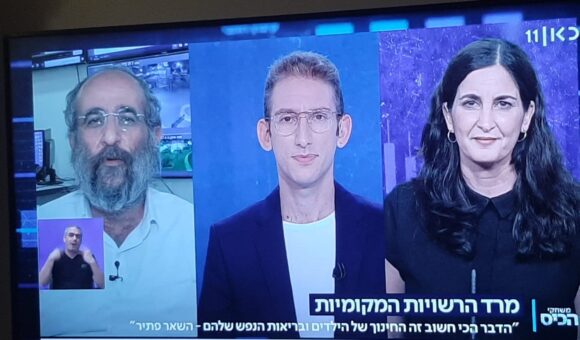


For the Children: Tel Aviv and Bnei Brak’s Joint Action
The two cities convinced the government to quickly reopen the school system –thanks to the collaboration of Network members Shirley Rimon-Bracha, Head of the Education Administration in the Tel Aviv-Jaffa Municipality, and Arik Adler, Treasurer of the Bnei Brak Municipality
What happens when Bnei Brak and Tel Aviv lead an extraordinary collaboration to get students back into the education system?
At the end of the second lockdown, the government announced that bringing first and second graders back to school, for half the school week only, would entail five weeks of preparation and billions of shekels worth of spending. But two Network members decided that after months of having their children sitting at home, there was no time to waste – nor was there any need for such an expense.
Shirley Rimon-Bracha, Head of the Education Administration in the Tel Aviv-Jaffa Municipality, and Arik Adler, Treasurer of the Bnei Brak Municipality and Director of the city’s COVID-19 Situation Room, persuaded their respective mayors to appeal to the government.
And in an unprecedented move, the Mayors of Tel Aviv and Bnei Brak turned to the government together and issued an urgent call to give schools the authority to reopen in a flexible format, in accordance with health guidelines. The main goal was to help get the children off their computers and phones and bring them back out into the world, in an effort to prevent potential mental health problems and social issues resulting from 10 months with almost no face-to-face learning.
In a joint interview, Rimon-Bracha and Adler talked about the initiative that has managed to unite two such different cities. As Shirley said, “If Tel Aviv and Bnei Brak can work together, then the Ministry of Education can find common ground with teachers’ organizations.”
Following the letter from the Mayors, other local authorities expressed support for the initiative, and it was adopted. First and second graders went back to school a short time later, for the full school week, in line with the format proposed by the municipalities of Bnei Brak and Tel Aviv.
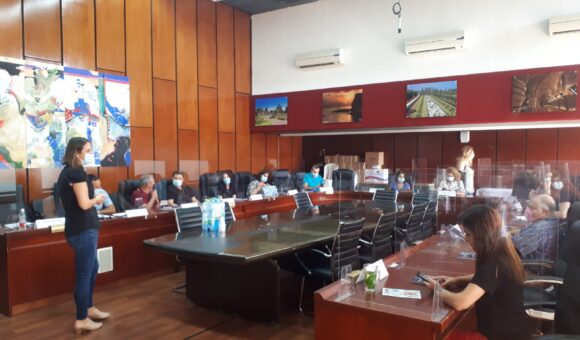


Health and Quality of Life for the Elderly Begins with Cross-Sector Partnership
During this period, when elderly people are stuck at home with limited ability to wander around in public, it has become evident that standard medical care is not enough to keep them healthy. When the Clalit HMO realized this, Gil Lavie, Head of Planning & Strategy at Clalit created innovative partnerships
COVID-19 has thrust the elderly into the top tier of our national concerns. Special headquarters have been established in order to protect their health and numerous government ministries are responsible for them. But at the end of the day, when a lonely elderly person sits at home, isolated from society, not daring to leave for fear of catching the virus – who takes care of them and their needs? A few different bodies share this responsibility, and they are insufficiently coordinated.
Gi Lavie is Head of Planning & Strategy at Clalit. Normally, his job includes comprehensive systemic assessments looking months and even years ahead. During the COVID-19 pandemic, he took it upon himself to look into the long-term health effects on patients who had not contracted COVID-19, but whose routine medical treatment was compromised due to the focus on the pandemic. One of the most hard hit populations in this period have been the elderly, who have largely abided by medical advice calling for them to stay at home. Hundreds of thousands of elderly people live in Israel, many of whom are confined to their homes even in the routine.
This is not a new problem. Public care for the elderly is divided between many institutions –HMOs, municipal social services, social organizations and more. Also at the government level, responsibility for the elderly is divided between numerous government ministries. COVID-19 has exposed the difficulty in providing holistic solutions for the elderly. Many volunteer organizations that were active during the peak of the first wave have gone back to their day-to-day activities, thus leaving the elderly back to receiving only partial solutions spread around a number of different bodies.
An elderly person’s health depends on much more than medical treatment and includes medical, social and welfare elements – as well as logistical solutions for many different needs. The lonely elderly person confined to their home does not have one go-to organization to provide specific solutions.
Clalit is Israel’s largest HMO, providing services to more than half of the country’s population. But when Gil and Clalit looked into the issue, they realized that in order to fulfill their responsibility to protect the health of elderly people, they had to join hands with the other players operating in the field. And this required a level of synergy which simply does not exist.
For example, the Clalit branch in the city of Acre is situated right in front of city hall. The two bodies provide services to the same individuals, yet despite their physical proximity, there is no streamlined information sharing and no shared “clientele” list, which means that they simply miss out on the opportunity to streamline processes and make them more efficient for patients.
Gil and his team decided to seize the opportunity brought about by COVID-19 to create a trifold solution focused on the elderly. Their goal was to streamline the activities of HMOs, municipalities and social organizations, and improve the solutions they provide for the benefit of their elderly clients and patients.
The municipality is a central partner, as it is the main local actor – it knows the local residents and organizations very well and understands all the unique characteristics at play. This is the reason the team decided to create a bottom-up process at the local level of municipalities and local actors rather than pass the responsibility on to government bodies at this point for top-down synergy.
In order to examine the model and develop it further, they decided to start a pilot program in two cities: Acre and Sderot. Gil’s partner in this process is Network member Dr. Assi Cicurel, a rural doctor and manager in Clalit’s Southern District Headquarters.
As part of the pilot program, municipality staff work together with the Clalit team to define target populations and build joint working procedures, in coordination with organizations and NGOs operating in the local area. The person responsible for synchronizing these bodies is the coordinator, a designated position recruited especially for this program. He maintains contact with all partners, including the patient. A digital synchronization tool is currently being defined to allow all parties to receive a comprehensive picture of the patient.
And how does it all look from the elderly person’s perspective? To them, it’s almost invisible. They can contact the same bodies they are used to, such as HMOs or social service organizations. These bodies will then enter the application to the shared system and operate in coordination with each other. The coordinator will make sure that the patient’s problems receive the necessary solutions and he or she will consolidate the solutions provided by the different bodies as much as possible.
As with any startup, this initiative also faces challenges. When talks with the Acre Municipality began, the city didn’t understand why this initiative was necessary and what interest Clalit had in promoting it. But when municipal employees understood how it would improve care for elderly people, doors started opening.
Identifying the correct success criteria is a challenge in itself. How does one measure success? Do higher patient satisfaction rates mean that the activity has achieved its goals? Maybe if the elderly person reports that they’re feeling less lonely or have no shortage of anything? Is it realistic to expect improvement of health indicators due to the activity?
Despite the difficulty in defining results, Gil said that Clalit views the initiative as a strategic, long-term step and as an opportunity to upgrade relations between HMOs and municipalities.
“Clalit’s size, power and capacities obligate us to be national leaders. If we can create a model for real partnership between HMOs and municipalities, thereby improving our patients’ health and quality of life, it will be a significant breakthrough.
I hope and believe that this is the first of many more partnerships between these groups, and that other organizations and government ministries will promote the extension of this model to other fields. Everyone, most of all our patients, stands to win.”
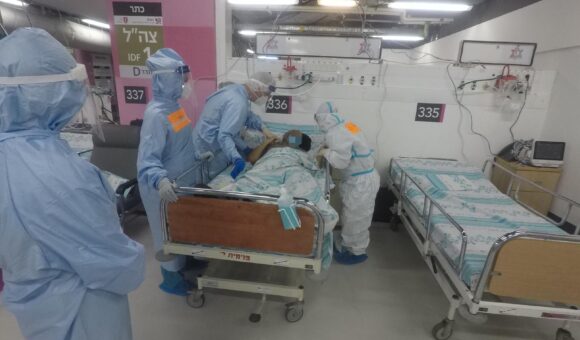


When the IDF Joins the Effort
COVID-19 patients hospitalized at Rambam Hospital’s underground ward don’t know that they’re being treated side-by-side by hospital doctors and military doctors. This is the story of how the IDF Northern Command’s Medical Corps, led by Dr. Erez Karp, enlisted to fight COVID-19
At the Haifa-based Rambam Hospital, an underground hospital – the largest in the world —was erected a decade ago for the IDF to use to evacuate the wounded during an emergency or war.
A little over a month ago, Rambam opened the underground facility’s doors and turned the lights on.
We’re at war. But not the kind we had prepared for. We didn’t imagine that the war we’d be fighting would be against a virus.
Our relationship with Rambam Hospital is long, close, and ongoing; our daily lives are connected. The hospital’s medical staff has already been at the forefront of this war for nine months. During the lockdown, when the hospitals became increasingly overcrowded, we joined Rambam’s medical teams, working alongside them.
Just before Rosh Hashanah, we sent 130 men and women soldiers – doctors, nurses and paramedics – to reinforce Rambam Hospital. Our job is to lend a helping hand and enlist in the effort.
We’re there to help patients, and help Rambam’s medical staff deal with the pandemic. When military doctors begin their shifts, a Rambam doctors is responsible for one less patient and can feel a little less alone in his or her battle.
It’s not always so simple. Even when a relationship is based on trust and partnership and is full of good intentions, it is still one in which two separate entities are connected – one of them being a military unit. Each side brings its own perceptions, abilities, strengths and weaknesses to the relationship. For example, a military doctor’s daily work is very different from treating COVID-19 patients in an inpatient ward.
So how do we make it work? With a sense of shared responsibility, overcoming obstacles, maintaining our high levels of professionalism.
Like everything else related to COVID-19, everything happened so quickly: within a few days, we became hospital staff. Today, in the underground COVID-19 ward, you can see tired and hard-working faces of medical staff. Under their protective gear, some of the staff are civilians and some are soldiers.
Last week, we also brought IDF paramedics to the hospital. We were a bit apprehensive about whether it could succeed: can medics, some of whom are in reserve and have just been called up from their regular daily lives, successfully take on the position?
And then I saw one of our reserve paramedics sitting with an elderly COVID-19 patient. As he lay dying, she held his hand. Her presence allowed him to part with our world; he was a little less alone.
This image illustrates, more than anything, what drives us forward.
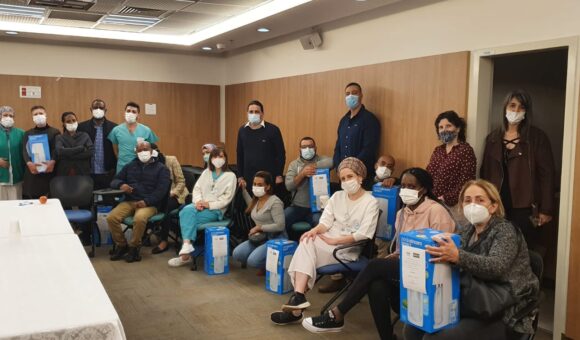


What Happens When an Ultra-Orthodox Man, a Secular Woman, and an Arab Man Join Forces in Jerusalem
It started with a WhatsApp message and evolved into a group of 51 Jerusalem-based Network Jerusalem who decided to work together. The group’s founder, Meir Aghay from the Jerusalem Municipality, is convinced that “together, we will prove that even a city as complex as Jerusalem – with its diverse group of Arabs and Jews, secular, religious and ultra-Orthodox people – can collaborate and create genuine change on the ground”
What connects an ultra-Orthodox man from the Jerusalem Municipality, a secular woman from the Ministry of Health, and an Arab businessman who works for an international corporation?
The three of them, all MAOZ Network members, came together to distribute packages to the medical staff at the Sha’are Zedek Hospital. This partnership was born following an initiative by Network member Meir Aghay, who founded the “MAOZ Jerusalemites” group.
In a message to the MAOZ Network WhatsApp group, Aghay, Head of the Community Administration in the Jewish Quarter of the Old City, wrote: “A while ago, some Network members from Jerusalem and I started talking. We care about our city, and the pandemic has not been good for the public discourse. This city is a microcosm of Israel, and the hateful discourse and atmosphere of incitement here has become very extreme.
But we think something can be done about it. We believe that through the collaborative action of Jerusalemites from all demographics and neighborhoods, we can take responsibility and change the discourse in our city.
And where else to find such a group, which acts out of a sense of shared responsibility and deep-rooted trust, if not here in the MAOZ Network? In recent weeks, over 20 of us have worked to raise money and express support for medical workers. We visited Herzog Hospital’s COVID-19 ward to distribute care packages to the medical staff.
But this is just one act, a symbolic one. We want to do much more. So we turn to you, Network members from Jerusalem. If you are interested in collaborating to improve our lives here, we invite you to join the MAOZ Jerusalemites group. Together, we will think about the problems we have in common and work collectively to address them.
And along the way, we’ll prove that even a city as complex as Jerusalem – with its diverse group of Arabs and Jews, secular, religious and ultra-Orthodox people – can collaborate and create genuine change on the ground.”
Following the announcement, 51 Network members who wanted to work together joined the group, which then partnered with SodaStream to distribute care packages to the staff at Sha’are Zedek. But this is only the beginning: additional collaborations have also come out of the group, each in a different field with its own specific needs.
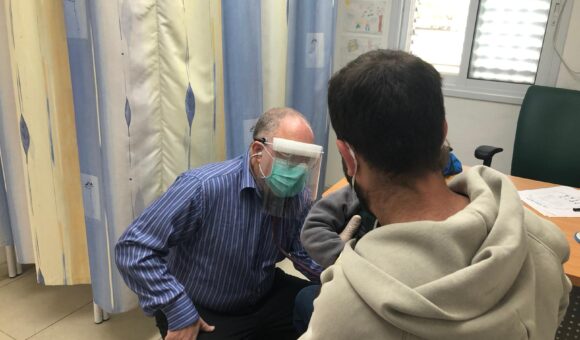


“All of a Sudden, I Can Call a Doctor From a Rival HMO and Consult”
In the Israeli health system, everyone works alone, in their own organization. The pandemic changed that for Dr. Assi Siccurel, a village doctor in the Negev, and enabled him to find new partners
“I have bad news and good news: this epidemic is first and foremost a challenge and a difficulty. However, over time, this is going to be an opportunity, as well.
I’m lucky to be at a unique intersection in the Israeli healthcare system, where I have the chance to see, understand and connect its many different complementary parts. I am, first and foremost, a community doctor. This means that I work in the field with patients and also with teams in other communities. As part of my specialization in healthcare management, I work in Clalit HMO management’s Strategic Division and I try to engage with people who focus on the national policy-making, as well as thinking about the scenarios that may be ahead of us. Finally, because of the crisis, I was recently asked to return to Soroka Hospital, where I provided specialized care until not too long ago.
In all these places, and in the face of all the challenges we face in the system, there is one thing that helps me operate: the MAOZ Network. What’s special about the Network is the bonds and connections it forms. When you’re a part of the Network, you’re programmed differently – you’re programmed to work together. It’s a force that drives you differently.
I’ll tell you a bit about what my day typically looks like.
It’s the morning of a new week. There’s a heavy workload and intensity typical for this last period. I start my morning in the clinic offering care via phone, video, in the clinic itself and at elderly homes for elderly people who are in preventative quarantine. I’m taking part in a frenzy of conversations, meetings, treatments and now even Zoom meetings. I recently received an important delivery. It’s protective equipment for the medical teams. If there’s something missing today, for both the emergency room doctors and the nurses in the clinic, it’s protection. The shipment came thanks to a Network member’s connection with manufacturers of 3D printers. They quickly began to manufacture protective gear and delivered it to us immediately.
Later on, I find myself traveling between the villages and communities in the Negev. I distribute protective equipment, such as face masks, to help medical teams continue to provide medical care on the one hand while maintaining their own health on the other.
While I’m on the road, a Network member who serves as the direct manager in the senior management internship program calls me. We speak about the impact the upcoming revised guidelines will have on HMOs. A change in operations and methods of dividing shifts. We know that this supposedly technical issue will have lots of implications, so I share my thoughts, which are based on my work in the clinic and the conversations I’ve had with friends. I know that the insights from the field will impact policy-making.
I get back to the clinic and begin a series of online conversations with patients. In between, another Network member calls me and wants to consult. She says that there’s a healthcare human resources problem, as we all know. Do we have any creative solutions? What about, for example, someone who studied medicine abroad and returned to Israel and still has to take the final tests. Can he or she begin seeing some patients?
This relates to the biggest ailment our healthcare system faces. We’re used to typically dealing with this system alone. Every man for himself and every woman for herself. Every institution operates alone. Hospitals operate separately from the community. The Ministry of Health operates separately from the hospitals. Not because anyone is evil, not because something is necessarily wrong. This is simply how the system is built: lots of players have to fight over a little bit of money. So it’s natural that solitary, uncooperative, competitive work is the result.
In these times, we need many more players to collaborate so that we can successfully enact changes. I need connected professionals to work with me on my mission, their mission, our mission. Network connections make working together better and more efficient, as we start out with high levels of interpersonal trust.
How did the Ministry of Health know what the small clinics needed if they didn’t have sensors in those places? And how will the clinic be able to ask and get what it needs from the office if it doesn’t have a callable phone line and a simple moment to explain?
Or competing funds. Sometimes it’s a connection with a doctor in a clinic that supposedly competes with the HMO to which I belong. We offer each other rapid learning that we both need urgently.
Communication gaps between community and hospital. This is a disparity and difficulty that the healthcare system faces every day, year-round. Tensions, systems which are not always synchronized or connected. But now this weak point is even more critical. If a coronavirus patient is admitted to the hospital with acute symptoms and comes to experience some sort of relief, he or she can be sent to a hotel which is hosting patients exhibiting mild symptoms. The problem is that this is not that simple, because when one entity runs the hospital and another entity runs the hotel and the players don’t necessarily talk to each other, the operation is more difficult and sometimes simply impossible.
This is also true of other gaps the system faces, such as gaps between local authorities and medicine. On a daily basis, the Department of Social Welfare doesn’t speak with the pharmacies. However, there is now a burning need for coordination between places that distribute drugs and the people who need them and cannot leave home.
Another connection may be with economists from the Ministry of Health, which allows the transfer of information between the field and the headquarters, ultimately paving the way to finding solutions. What connection do I have to the economists? Good question. If I, at the small regional clinic, know that I will see patients via video sessions, this is not enough. I need guidelines and regulation to deal with this; I need more HMOs to deal with this.
The relationship between systems is crucial right now and cannot function with the same gaps we have routinely faced in the routine. That’s what the INBAR Network ensures these days: my ability to speak matter-of-factly and directly with other officials from all corners of the healthcare system and local systems.
It’s rare to feel that trust when you pick up the phone or get on a Zoom call and without any preparation, you suddenly already know that you can work
together. Yalla, we’re getting to work. So what if we compete? It is in this state of uncertainty, within this complexity that we simply, above all, need one another.
Like many other challenges, what we have in common today is our diversity. We have a chance. I feel we have a chance. We can address all our weaknesses very quickly right now. It will help us now, but it will help us out later on.
We will emerge stronger from this episode. The road will be difficult and complex, but we will grow stronger. To me, this encourages me on difficult days.”
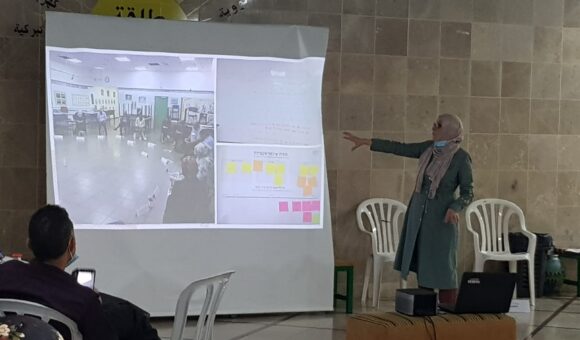


The City’s Education System Was Shut Down for 6 Months. The Parents Didn’t Trust Us
When schools opened all around the country, the classrooms in Umm al-Fahm remained empty. How did Mahmoud Zohadi, Director of the Municipality’s Education Department’ manage to turn that around?
“During the first few months of the COVID-19 crisis, we in Umm al-Fahm managed to make it through with very few infected patients. We were able to control the virus, but our problem lied elsewhere. As the education system returned all over the country, our schools remained empty. Parents simply didn’t send their kids to school.
I personally know how critical the connection between parents and the school is. About 22 years ago, I knocked on the door of the Umm al-Fahm Education Department and asked to enroll my son in a special education kindergarten, only to find out that no such framework existed here or in the other surrounding Arab local authorities.
The mayor then told me, ‘Come join the city council and establish this kindergarten yourself.’ Within a few months, I accompanied my son to a kindergarten that fit his needs. And I’ve remained in the Education Department ever since.
So I know that when the system and the parents work together, great things can be accomplished. But for many years, we didn’t succeed. When the coronavirus hit, we were left with no solutions – the disconnect paralyzed the entire system.
After consulting with MAOZ, I called the various school principals and suggested that they join me in reaching out to parents. Together, we selected six schools: each principal contacted 10 parents from each school and invited them for in-depth interviews in order to hear what things looked like on the parents’ end, and also to share a bit themselves.
Making this effort and coming ready to listen created a positive feeling from the start. We gathered parents’ insights and set out to formulate partnership. It was then that we realized that the first step is building trust. So we began compiling a work place for building trust, which is so crucial and so simple.
Many suggestions were made, such as establishing a parent room at school for parents to hear and feel what goes on in their children’s learning experience, as well as to get to know the Education staff. Additional suggestions were to hold frequent check-ins between teachers, principals and parents, including parents on school committees, and much more. We presented the program in a joint evening for parents and principals, and the parents saw first-hand how their insights had produced a new reality on the ground.
Next, we realized that as a city council, our daily contact with our residents was lacking. So we consulted with MAOZ Network members and set up a municipality situation room, through which we hear from the residents and update them, as well.
Everything was ready for the start of the school year. However, at the last minute, it was decided that schools in Umm al-Fahm wouldn’t open because of the city’s classification as a “red city”. This time around, the parents were angrier than anyone else about the decision, as they had intended to finally send their children to school. However, through everything, a parent representative sat in our situation room, and parents are invited to join discussions I lead about distance learning.
A system that has opened is the special education system, to which parents sent their children. While at the beginning of the crisis, one infected student caused all parents to keep their kids at home the following day, this time around, things are different. Even the fact that three teachers were infected did not prevent parents from sending their kids to school, as they trusted principals to follow the guidelines and look after their children.
In November, when the country’s education system began to gradually return, the morbidity rate in Umm al-Fahm remained high. But that didn’t stop parents from sending their children to school – 95% sent their children. This isn’t just a number – it’s what trust looks like.
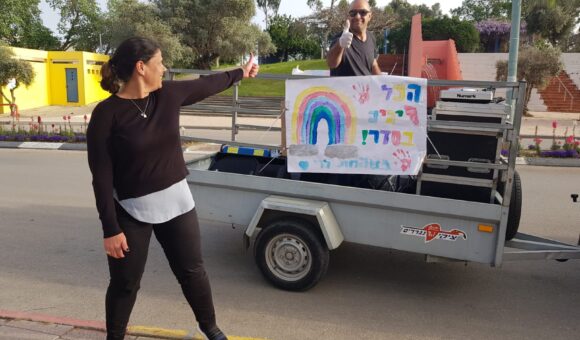


The Secret Solution for Living Amidst Uncertainty
She built a “timetable” for her team, completely digitized the municipality, and is racking her brain for ways to inject hope into employees and residents. Dalia Lin, the general manager of the Ganei Tikva Municipality, plans to emerge stronger from the crisis
“It was during the last lockdown, during the holidays. I felt that my staff were beginning to give up; they were struggling to keep their heads above water. Residents were also starting to give up – every little thing bothered them and as far as they were concerned, it was all our fault.
That’s when I decided that the way to deal with COVID-19 is through action. When we have no project or horizon to give meaning to our daily lives, we get lost in the uncertainty of it all. Our solution is to create hope and meaning – for employees and for residents. This is the only way we can be resilient enough to handle any crisis that comes our way. And with that decision, I went off looking for the great opportunities that COVID-19 had brought our way.
Ever since the day COVID-19 came into our lives, I had the profound sense that this was a big opportunity for both the Ganei Tikva Municipality and for our residents. I had been serving as General Manager for one year at that point, and I knew that the interfaces between our Municipality departments were weak. I knew that it was hard for us to rise above our draining routine activities.
And then suddenly, we found ourselves in an emergency situation full of uncertainty. Municipalities are ready for emergencies that require bomb shelters and emergency supplies. But what do you do when the threat is not a rocket but a virus?
The first thing I did was create a timetable for my employees. Sounds funny, right? I planned what they should do every day – from the moment they wake up until they close the computer at night. At 9:00 a.m., a daily report is sent to headquarters. At 10:00 I send them the latest instructions from government ministries, and at 11:00, we hold a situation assessment regarding the current state of the Municipality, during which we meet with the Mayor to check in and plan the new day.
The timetable has allowed us to create a framework of certainty for our employees in a world full of questions. No one was late and no one argued. These were their anchors during the day. They allowed them to push forward and give their all for the residents during the emergency.
But creating anchors isn’t enough – you also need to create meaning. So one morning MAOZ called me and asked: ‘Dalia, do you want to leverage opportunities during COVID-19 and look beyond the crisis?’
I signed my staff up immediately, not knowing what would happen. I knew that the important thing was the combination of mapping opportunities and intense work together with my staff. Most of our team participated: six meetings at 8:00 p.m. at the expense of their own free time. We mapped out the opportunities and problems we have as a municipality and we split into working groups.
We agreed to focus on three challenges: digitization of the municipality, flexible work for employees, and cultural and leisure activities during the crisis. It was like a breath of fresh air for my team. Suddenly, they weren’t only surviving. They were taking initiative, being creative and thinking how to make changes that would last for the day after.
Our flagship project is digitization. Right before COVID-19, I participated in a training course for digital leaders, but I wasn’t sure how to take what I had learned and implement it in the municipality. Before COVID-19, we barely had a single process that was fully digitized. Today, we are one of the leading municipalities in Israel in the field; our residents can do anything online, including even getting Land Registry permits.
Our biggest achievement is that we managed to create interfaces between departments, because every step of most processes is handled by a different department. For example, when a resident files a request, he or she has to receive permits from the welfare, finance and engineering departments, respectively. The resident isn’t even aware that this is the case: he or she go into his or her personal account and chooses what they want – municipal tax issues, community activities or general information.
When the offer came through to join MAOZ’s Changing Colors initiative, I knew I had to be a part of this too. After the previous experience, I felt there was a language gap between the managers who had been active participants and the employees who hadn’t been. This time, the focus was communication and law enforcement, but most of all, I knew it was an opportunity to expand the circle of influence in our organization and give the rest of the employees that same sense of meaning.
This same sense of meaning is what we pass on to our residents. We ask them to volunteer, keep their eyes open and notify us if any neighbors need assistance. As a result, our welfare department received the names of 3,000 elderly people, compared to only 1,300 who we had known about at the beginning of the COVID-19 crisis. A resident who calls the hotline to update us about a neighbor who needs assistance feels that they are not helpless. They are part of the solution; they take an active role in changing their circumstances.
COVID-19 taught me how meaningful hope is. When I think about how I’ll reflect on the way in which Ganei Tikva utilized the crisis, the last part of my presentation will be: ‘Because of hope’. The only way to stand firm during a long crisis period is when you have a sense that your actions really mean something. That’s equally true for residents as it is for department heads – everyone needs to feel that they have a reason to get up in the morning and strive to make it happen.”
.
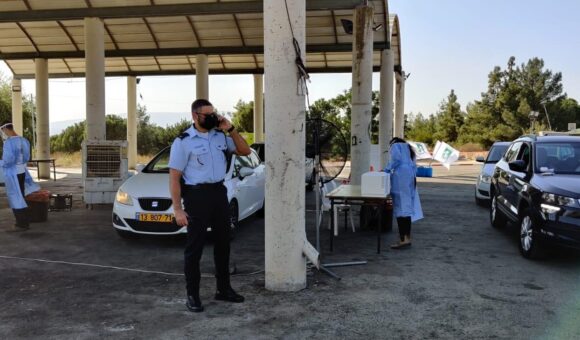


When the CEO Conducts Epidemiological Investigations Herself
A year ago, if someone had told Lilach Geva, the CEO of the Katzrin Municipality, that residents would call her about their breathing problems, she wouldn’t have believed it. Her story illustrates how within a moment, the role of local authorities changed in the pandemic
I received a phone call a few days ago from an IDF Home Front Command officer. She informed me that I had been breaking the law, saying: “You’re not allowed to talk to patients. Did you know that? It’s not part of your job as a local authority.”
I’m not sure if my heart even skipped a beat, as the phone immediately rang again. This is how it’s been in recent months. A resident was on the other line. He was having difficulty breathing and he asked for help. I stayed on the line with him, calming him down while immediately sending an ambulance. When I asked him why he didn’t simply call his healthcare provider hotline, he explained that he had waited 10 minutes on the line with the HMO before deciding to hang up and call me.
I have no medical training, and a year ago, I didn’t imagine residents calling us with breathing problems. But when I got this phone call, I realized how much the residents trust us and how much responsibility we have. We have to produce solutions and be fully alert at all times, even if I’m dealing with tasks which deviate from my official role as CEO of the municipality.
One can hardly understand how complex the traffic light model is for small local authorities like us. When you have less than 10,000 residents, the math configuration works less well. If we start a week with 19 patients in six different families, we’re already categorized as “orange”. A new sick resident today and two more tomorrow turn us into a “red” city just like that.
From the beginning, we realized that we had to manage this on our own. I asked a police representative and a welfare representative to attend an urgent meeting. We had a mission to reduce morbidity. We needed to explain, enforce and break infection chains. We needed to give infected residents solutions while maintaining a daily routine of some sort.
Our authority as a municipality is pre-defined and rather limited. We can’t, for example, knock on a resident’s door and force her to quarantine. But our power is different: just as we project responsibility when we answer the phone at any hour, we now ask our residents to do the same. Responsibility needs to be towards me the individual, as well as towards my neighbors and community.
When a resident is infected, I conduct an epidemiological investigation myself (I underwent training with six other representatives from the regional council). Then I transfer the authority over to the resident herself. I ask that she stay in isolation, go through her schedule from the past few days and call everyone she physically met. We have acted on our own authority – maybe even a little beyond, but I’m confident that that’s what we need to do now.
It’s clear to me that we can do this because we are a small municipality. And we have people working around the clock, reinventing and expanding their roles and ours. But it’s important to understand: burnout accompanies all this work. I feel responsibility for them, as well, because along with sticking to the task, all this intensity has a price. Therefore, with the mayor’s approval, we decided to have the team undergo an accompaniment and problem-solving process with MAOZ. The objective was to strengthen employees’ resilience with this endless intensity and help them keep their heads above water.
Our phones didn’t stop ringing during the accompaniment. The resident I did an epidemiological investigation for called me at one point. She recalled another meeting she had had and asked that we update the relevant people to quarantine, as well.
The phone calls keep coming. It’s not that we don’t have a municipal hotline – the residents just prefer to call directly. This is how it is when the residents shop at the supermarket with us, send their kids to the same school we send our kids to, and so on. I’m part of my community. And I don’t think we’re alone on this – this is what local authorities look like today.
So if I’m summoned to an inquiry committee after this is all over, I’ll stand with dignity and say that I did everything I could for my residents during the emergency. And sometimes a little more.
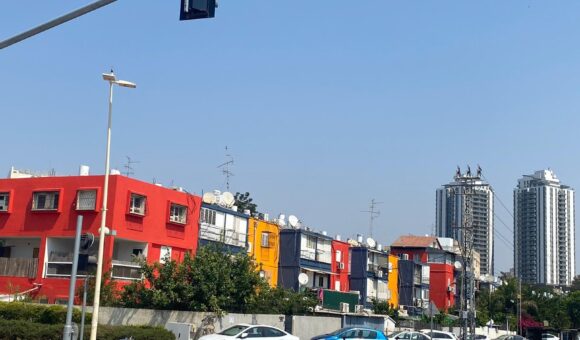


How Can We Improve the City Center? With Colourful Shading and Street Art
What do most of us picture when we think of the center of Petah Tikva? Urban developer Nitzan Barchan already knows the answer. But rather than an expensive redevelopment process that would take years , he decided to paint buildings in bold colors and implement rapid solutions for residents
“One day, the Mayor approached me and said, ‘Nitzan, you know the long council estate building at the entrance to the city? It looks bad. Let’s find a way to change it.’ The classic solution, urban renewal, costs a lot of money and takes a lot of time. Before we went down that route, we decided to do something quick and out of the ordinary: we painted the building in bold colors. The day after we finished working, we started to receive phone calls. What had caused this? Who went to all that effort? The residents of the building felt valued. And residents of other buildings wanted theirs painted
A year-and-a-half ago, I stepped into my role as Petah Tikva’s City Architect. I began focusing a lot of my time on the public space; how residents experience and use it. It took no time at all to identify the pain point – the city center. Petah Tikva is a longstanding city with a proud heritage. Over the years, the city has expanded outward, with new neighborhoods, new construction and new commercial centers, and only the city center has been left far behind. The buildings became dilapidated, the infrastructure aged badly, and those who could, began leaving for greener pastures in newer neighborhoods. When I looked at the city plan, it jumped out of the page: the most central part of the city was the most run-down. I harbored some hope that if we could change the aesthetic appeal and the image of the city center, I could change the image of the city as a whole at the same time.
I got to work, diving into hundreds of plans, trying to understand what had already been done. I discovered that I had not been the first to tackle this problem: there were dozens of plans titled “Regeneration of the City Center”, but not a single stone had been turned out there, where it actually mattered. Time after time, the plans failed to be executed. When I started talking about this in the corridors, I understood the extent to which these attempts had exhausted the system: ‘Nitzan, you’re not the first. We all know that it needs to be dealt with, we’ve poured huge sums of money on planning, and nothing has ever come out of it. Let it go.’
I realized that making plans was not the way to convince anyone. I had to show results on the ground.
I knew the really big changes would take time. Evacuation and reconstruction programs (so-called “pinui-binui”), urban renewal, new commercial centers – these are not things that happen over the course of a few days or even months. So how do you achieve quick results on a limited budget? Through what is known as ‘tactical urbanism’, making small and easy-to-implement changes in the landscape on a low budget, and gauging the public reaction as quickly as possible.
COVID-19 fit in wonderfully with my plan—the shopping centers were closed, and residents needed safe and inviting public spaces more than ever. When we were given the task to renovate five commercial centers and adapt them to the circumstances of COVID-19, I went out on a trip with the Mayor and heads of infrastructure to scope out the situation and see the old commercial centers in question. We looked for the run-down places where we would be able to make small changes that would make a big difference. And within a few days, the center looked like a whole other place.
Firstly, we added lighting so that residents would feel that the area was safe and not in a state of disrepair. We planned benches with shade right outside the post office so that people waiting outside due to COVID-19 restrictions not allowing everyone to be inside at once would have somewhere to sit. And most importantly: we used bold colors that really caught the eye. When the shade canopies are in bright, bold colors, no resident will fail to understand that something has changed.
The positive feedback flowed in. We made changes that cost almost no money, but the residents felt that someone was thinking about them, taking an interest in where they could sit. Following the success, we’re raising money for our next project: integrating street art into the city center and building a tourist trail that includes a tour of the artworks and historic buildings and ends at the commercial center.
In a time when everyone is closed off in their own homes, and venturing out into public spaces is rare and often uncomfortable, we want to make every such journey a positive experience.
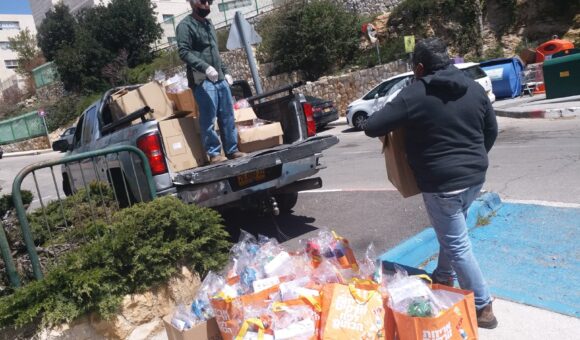


Our Infected Residents Took Responsibility. This is How We Curbed the Pandemic in Efrat
When Efrat became a red zone for Covid-19, Oded Revivi and Yehuda Schweiger, the Mayor and Director, realized it’s time to call upon their residents’ sense of community and joint responsibility
“We in Efrat work under the assumption that whatever works in routine times will also work during emergencies. We prepare ourselves for emergency situations, but our readiness for an earthquake or war is different from how we need to cope with the COVID-19 crisis. During every emergency, we – not to mention the entire country – rely on a specific defense mechanism: partnership, togetherness and unity. But that which has always been the cure – our proximity to one another – is now the danger itself.
Looking back to the start of March, we were in the process of developing the local authority with MAOZ. We were in the 100Day process of the Meitzim (Accelerators), dealing with our challenge to transform from a small local authority to a medium-sized local authority. Efrat has grown by 60% over the past five years. By the end of the year, we will have 16,000 residents. Without umbrella agreements or self-sufficient industrial areas, growth will continue over the coming years. Efrat has become a city.
Back in March, we were also busy with Purim festivities. There were many happy and colorful holiday parties in people’s private homes and in the neighborhoods; we ran an Adloyada (traditional Purim) parade and a community-wide megillah reading in the local council.
It was still possible to celebrate in accordance with the Ministry of Health’s guidelines at that point. Today, we would call what we did then “gathering”. I also know to say now that that was probably the point when the pandemic reached us.
Two days later, almost all the residents who had attended the parties began feeling unwell. A family doctor who had checked many of them called me to inform me that a lot of residents had COVID-19 symptoms.
Efrat had the largest concentration of diagnosed patients in Israel for days. Entire neighborhoods were in quarantine and many residents had come down with the symptoms.
Together with Mayor Oded Revivi, who has led Efrat’s development and is also a MAOZ Network member, we knew that one of the most important things we could do was take control of the situation: we needed to figure out who had been infected, how many confirmed cases we had, where they had taken place and what to do next. We wanted to start conducting as many checks as possible in order to determine who was sick, thereby preventing further infection.
We knew that on the one hand, the Ministry of Health would be unable to keep up with the entire country’s testing needs. Alongside that, we knew we had the responsibility to assist on the local level. We understood that we needed to step up our testing and reporting system in order to reduce infection.
Following a suggestion by an Efrat resident who is a senior Magen David Adom paramedic, we decided to open a testing operations room within the local authority. We trained our medical teams to conduct the tests, partnered with MDA volunteers and set up two vehicles that could transport patients and get tests to the Ministry of Health in Jerusalem to be checked as quickly as possible.
Within a few hours, it started working. Telephone upon telephone, resident upon resident: hundreds came to be tested. We carried out over 500 tests within the council and quickly transferred for examination.
It was at this point when we decided to take another important step. Everyone who came to be tested received a form. We explained to the residents that if their coronavirus test returned positive, we’d want to publish their names and the places they had been over the last few days. Over 95% of them agreed. For every test that came back positive, we published the person’s details in order to raise the local authority’s awareness within minutes.
It’s seemingly simple, and today everyone understands that it’s better to do this more and more. But it was a complex step. Medical confidentiality is of paramount importance, and as a local authority full of acquaintances based on trust and shared responsibility, we have managed to do just that.
About a year-and-a-half ago, we set up neighborhood resilience teams – a group of neighborhood volunteers made up of adults, young people and new immigrants. This effort later emerged as a significant strength of ours, as it served as a connecting channel between the local authority and the residents and as a community center for solutions, and for forwarding requests for assistance, needs and messages.
We accumulated a great deal of knowledge about our residents who had been infected, as well as where they had been. We were able to notify a lot of residents to quarantine themselves. At a breakneck pace, we were able to act extremely diligently and efficiently.
We realized that in such an uncertain reality, our role is to create stability for the residents. So we made every effort to make information accessible: we opened a COVID-19-dedicated website, we published daily updates in Hebrew and in English, and we hosted many Facebook Live Q&As. When information is made accessible in real-time in a reliable and transparent way, residents can deal with the crisis, the loneliness and the instability better.
Within a few days, the local authority published a document of the insights and lessons we had learned in dealing with the spread of the virus. We distributed it to all local authority mayors and CEOs in order to assist them through what we have already experienced. A webinar for MAOZ Network members was also hosted, in which we collaborated with Itay Tzahar, CEO of the Kfar Saba Municipality to speak about local authorities’ preparedness.
We realized that the knowledge we had acquired, together with the practices that worked for us, could be useful in many other places. So I had a few conversations with MAOZ team members and Network members on how to take the model of coronavirus testing we had created in Efrat and apply it elsewhere. By the next morning, I saw pictures of an operations room set up at the entrance of an Arab local authority in the newspaper. A few hours later, I received a recording of another Network member who had been a guest on a radio show and spoke about his decision to replicate the model we had created in Efrat.
There’s a lot of other activities going on; Network collaborations that help things move fast. For example, we have a Whatsapp group for local authority CEOs. There was lots of talk in the group when the Prime Minister announced that the workforce would be reduced from 30% to 15%. Everyone panicked and was concerned – “How should we proceed?” we all asked. “What should we do?”
I messaged a Network member who works in the Ministry of Interior, asking her to look into the option of the Ministry offering an explanation – something to calm people down. She replied within a few minutes and I forwarded her message to the Whatsapp group. Just like that – in one moment, dozens of CEOs felt that they had a connection with the Ministry of Interior; they felt that the central government listened to them and was in this fight with them. This importance of this phenomenon cannot be overstated.
This is not the time to take note of the things that don’t work and complain about them, even if the complaints may sometimes be justified. This is the time to act in accordance with the tools and resources we have in front of us and leverage them through collaborations.
Local government, central government, nonprofits and the private sector – we’re suddenly seeing how small connections have a big impact. And they will eventually help us beat this, too”.
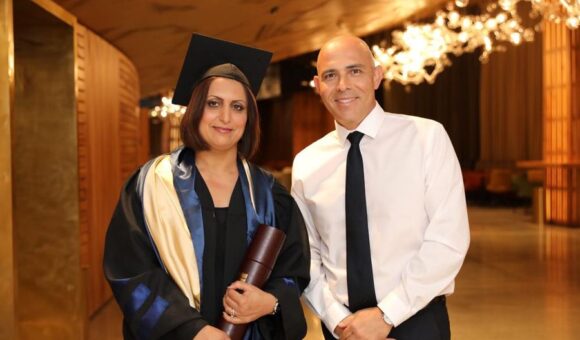


“COVID-19 Was One of the Greatest Gifts We Could Have Received”
After 11 years of serving as a high school principal in Lod’s toughest neighborhood, Shirin Natour-Hafi thought that she had seen it all. But then the coronavirus arrived
“COVID-19 was one of the greatest gifts we could have received. I feel that it made us stop, halt our overblown self-confidence, our sense of certainty and so on. I had a chance to reconsider things that I had taken for granted, as well as my occasional rigid thinking and behaving.
What could change in the education system and for me personally? Nothing. I’ve been a school principal since 2009; everything starts out the same, continues the same, and ends up the same.
But suddenly the coronavirus arrived and forced us to alter our ways of thinking, our approach to teaching and the very way in which we think about the principal-staff relationship. Under normal conditions, these processes would have taken 10 years, but suddenly they’re taking place in just half-a-year.
There are a lot of students who are thriving in the current circumstances. Many children are happy to be in front of a screen; it enables them to express themselves without being seen. Suddenly, girls with head coverings can sit down without them and be immune to all the influences that occasionally restrict them.
There are Arab children who have no internet access; not because of financial problems, but because their parents don’t want internet access. And now, all of a sudden, there’s a new reality. Imagine what it’s like for a father who has vehemently opposed bringing the internet into the home to suddenly understand that he actually needs it? For years, we’ve tried to persuade parents without success, and now, all of a sudden, it has become possible. What might that mean for the ultra-Orthodox community, for example?
So we’re bringing computers into the homes of the children and explaining to each parent that without a computer, the child won’t learn. There are a few children for whom this represents a tremendous opportunity to bring about a major change in their lives.
The true crisis is the one facing our teachers, and we’re working very hard on the mental side of things. I find myself sending text messages to teachers with lots of heart and rainbow emojis. Every Thursday, I sum up the week and congratulate them, telling them ‘Well done! I’m so proud of you and the work that we’re all doing.’
The teachers are reinventing themselves and it’s wonderfully moving to witness. Suddenly I see how creative they are and how each teacher chooses his or her own path in reaching the students. We see teachers unexpectedly collaborating. For example, two of our history teachers are conducting joint lessons in a shared presentation. This demands creativity, flexibility and collaboration.
The real question is how we can capitalize on this ‘gift’ we’ve received and leverage it towards something completely different – something that will boost the education system. Instead of investing our energies in withstanding the current crisis, or waiting for it to pass, let’s reinvent ourselves!
This is the first time that grassroots have been able to influence the Ministry of Education. I believe there’s a sense of openness today at the Ministry of Education – a willingness to learn from us. This is an opportunity that won’t come again. Never again will we have this level of trust if we don’t know how to take advantage of it now.”
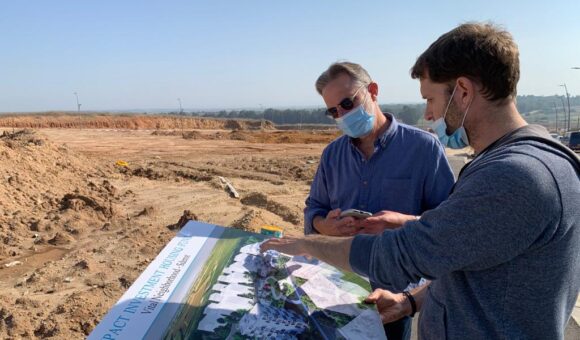


The Race to Build the Next Level of the Labor Market
Instead of waiting for heavy-duty government reforms, Roni Flamer, CEO of the OR organization, came up with a different way to reinvent the post-coronavirus job market: a competition
“The OR Movement’s mission ultimately focuses on what Israel will look like in 2048, when it celebrates 100 years of statehood. But we’ve always said that in every crisis the country will experience before then, we’ll have to leverage the opportunities which arise.
At the peak of the first COVID-19 wave, our partner Michael Eisenberg asked to meet urgently. ‘Roni, I get it now,’ he said. ‘The pandemic has made me realize that however important our vision for 2048 is, we also need immediate solutions.‘
I left the meeting knowing that it was time to get to work. So I did the only logical thing: I gathered the best minds in the country and brought them to the table (well, to the Zoom screen). We managed to recruit 200 partners on a fully volunteer basis. Everyone who cared was invited to join. We recruited experienced and prominent figures, among them Rakefet Russak-Aminoach, former CEO of Leumi Bank and Adi Soffer Teeni, Head of Facebook in Israel. Even Prof. Dan Ariely volunteered with us.
The teams began working in groups to address the challenges, and they submitted a large number of proposal outlines. We started working with the policymakers who would adopt the models, but I felt it simply wasn’t enough. If someone wouldn’t take it upon themselves to implement the recommendations, they might forever remain computer files.
And that someone? That’s us. This is how our new initiative, Exemplary Nation, was born. Its goal is to lead the Israeli labor market forward. Together with a team of 60 partners, we created a vision for the future, identified the challenges in getting there, and issued a call: ‘If you have an initiative that will change the Israeli labor market, then we at Exemplary Nation want you.’
We had hoped to reach at least 50 initiatives; we were amazed to receive 302 extremely varied proposals. One dealt with the question of how to produce a resume that includes information beyond dry biographical facts. Another suggested creating employment communities which would bring together employers, job seekers, and even academia. And there were hundreds more diverse and remarkable initiatives.
35 proposals were selected to advance to the final stages of the competition, from which two to four winning initiatives will be selected. The winners will receive a large sum of money to jumpstart their project, a team of mentors to accompany them along the way, and assistance in making connections on the ground as quickly as possible.
Our job is to make sure the chosen initiatives do not remain on paper, but actually change the employment market on the ground. And one of the happiest surprises was discovering that participating in the competition advanced even those who didn’t win. We’re in contact with projects that didn’t make it to the final stages, but tell us that through the process of the competition, they’ve fine-tuned their plan and are moving forward with it themselves.
We will announce the winning initiatives at the end of December and start working hard to help them take off. I think we’ve hit on a winning formula here, a sprint: moving within a few months from a global picture of the future to a localized vision, to a public appeal calling for entrepreneurship and implementation in the field. And we will also apply this format to the fields of health, tourism, and education.
We at the OR Movement also received a great opportunity with the arrival of the pandemic. We’re not just thinking slowly and far ahead, toward 2048. We’re continuing to run, sprinting ahead.”
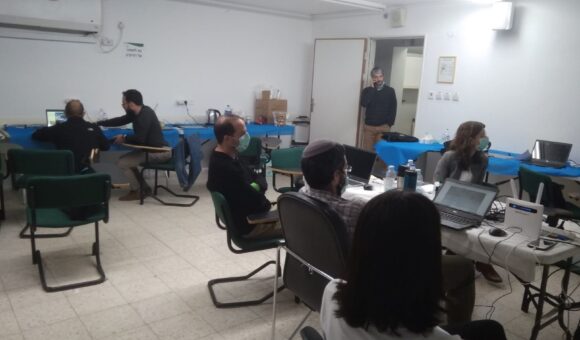


Bringing Ultra-Orthodox and Arab Voices to Decision Makers’ Table
MAOZ received a Certificate of Appreciation from the National Corona Control Center to honor intensive work during the first wave – accompanying Network members and bringing knowledge from the field that helped prepare for Passover and Ramadan
Visitors entering the MAOZ offices in Lod will see a picture on the wall that tells the story of the whole organization, the entire network, during the coronavirus pandemic.
It is a certificate that the MAOZ organization received at an event held by the government’s National Corona Command Center, held at the end of the first wave of the pandemic.
On stage at the event were elite IDF units who took part in the National Control Center – the Military Intelligence Directorate, the 8200 Intelligence Unit, and the General Staff Reconnaissance Unit (Sayeret Matkal). And then two more organizations ascended the improvised stage: Magen David Adom, the national rescue organization, and MAOZ – the only civil organization to receive a Certificate of Appreciation.
MAOZ received the commendation for ongoing activities within the Command Center throughout the first wave. In these activities, members of the staff accompanied Network members from the Interior Ministry, who operated specially designated desks for the Haredi and Arab communities.
The desk operations included finding solutions and meeting needs from the field, creating knowledge papers to bring the needs of the different populations to decision makers, and creating position papers to assist with preparation and readiness for Pesach in the Haredi community and Ramadan in the Arab community.
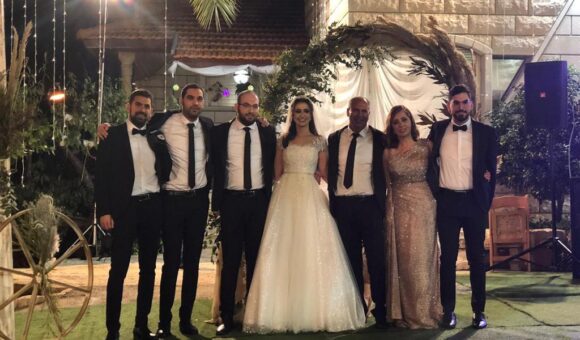


The Day I Realized: Weddings Are Becoming Funerals
25 years ago, when his son was born, everyone greeted Fathi Abo Yonis, Manager of the Sakhnin Municipality’s Welfare Department: may we meet on his wedding. But when the time came, this year, Fathi had to make sure nobody shows up
“I was standing in my yard just a few minutes before my eldest son’s wedding. It was one of the happiest moments of my life. But I was very, very stressed. I was afraid guests would come.
My eldest son’s wedding was supposed to include at least 1,000 guests and was intended to be hosted in a huge hall. Then came COVID-19. And instead of inviting everyone, we begged people not to come.
The day before the wedding, Johar, the owner of our neighborhood grocery store, made it clear to me, ‘Like it or not, I’m coming to your son’s wedding.’ As I stood there, in the yard, and saw that he had not arrived, I felt relieved. Everyone from Sakhnin who didn’t come did not insult us – they respected our wishes.
The next day, I went to Johar’s grocery store and thanked him for not coming. ‘But of course I was there,’ he said. ‘I celebrated with you until the end’. He had watched the wedding from his roof, rejoiced with us from a distance, and didn’t go to sleep until we had finished celebrating.
The past year has been full of ups and downs in Sakhnin. After the first wave, we felt that we had defeated COVID-19. We returned to an almost completely normal routine with very low morbidity rates. But the second wave caught us at a special time of year – the wedding season, which runs from April through August. Every evening, several weddings are held simultaneously throughout Sakhnin, with hundreds of people attending each one.
The municipality took responsibility. We tried fighting it, we worked hard to explain to the residents how dangerous the events were; the mayor even announced that he wasn’t attending weddings, and clerics also enlisted to the cause. But we failed.
People who had been planning weddings for years simply refused to give up. We were unable to convey the message that human live were at stake. The first blow we received was severe for every Sakhnin resident: the muezzin, whom we hear five times a day during prayers, contracted COVID-19 at a wedding and died of it soon after. Another five people who were infected at weddings died after him.
We felt that weddings were turning into funerals.
When my eldest son, Amir, was born 25 years ago, I remember everyone greeting us with the same blessing: ‘We’ll see you at his wedding, Fathi.’ This is customary for us. From the moment a baby is born, we already look forward to one significant moment: the day he or she will get married.
When we began organizing his wedding, I didn’t know how to tell him that the wedding he had been waiting for all his life would have to look different. But he approached me himself: ‘I’m not willing to take any risk; I’m not willing to have a situation in which I’ll remember for the rest of my life that someone got infected at my wedding. If we need to, my bride and I will get married without anyone else present.’
We informed all our friends of our request that they not come to the wedding. Amir and Rowan married in the presence of a limited number of participants in our garden. As we danced in our little family pod, I paused and remembered what this wedding was supposed to look like. But the joy was full and true; we felt the community was really celebrating with us.
The next day we sent messages to our entire community: ‘Thank you to all the family, friends and loved ones who pledged and did not come to participate with us in the joy of our son Amir. We felt your joy and love from afar.’
We, as a family, were not the only ones to take responsibility. First and foremost was the municipality taking responsibility for the community’s health, and for me as a city employee. Accompanied by MAOZ, we established groups of volunteers in neighborhoods that helped maintain the guidelines.
After the wedding, we made a decision as a family to make Sakhnin happy in another way. Together with the neighborhood volunteer groups we renovated two squares in the neighborhood.
We hope that the vaccine will eliminate COVID-19 and that we will return to rejoice with hundreds of participants.
But the squares will remain, and every time residents visit them, they will remember that they decided to celebrate Amir and Rowan’s wedding in a different way. And I hope that this will remind all of us that we chose to take responsibility for our actions, and that together we gave a new meaning to the word community.'”
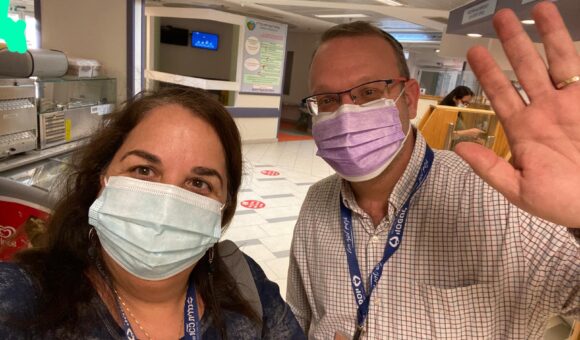


The Galilean Doctor Who Does “Reserve Duty” by Assisting an Eilat-Based Network Member
It all began with an off-hand hallway conversation at MAOZ’s annual event. “What are your needs in Eilat?”, they asked Dr. Revital Levi Hevroni, Director of Yoseftal Medical Center. This was the birth of a unexpected collaboration with Dr. Ziv Paz, Head of Rheumatology at the Galilee Medical Center
“Ziv and I met at a MAOZ Network event way back in March, just as the pandemic reached Israel. We were standing in the hallways of the International Convention Center in Jerusalem, chatting with a few other Network members.
We talked about Eilat and the hospital. The others were curious and sympathetic. They asked us what our days were like, what our challenges were. And then they asked me: ‘What are your medical needs in Eilat?’ And more importantly, they asked, ‘How are you coping with them?’
Easy question, easy answer. Rheumatology (the branch of medicine devoted to diseases that affect the joints). And then a Network member I had never met before but who was standing right next to me said: ‘I’m coming over to help. I’m yours.’
That was rheumatologist Dr. Ziv Paz. Ever since that short, off-handed conversation, he has come to Eilat every month. I call it his ‘reserve duty.’ Three days every month, he gives us his heart, soul, and mind. He improves processes, develops them, moves them forward, and finds solutions all so that the people of Eilat can receive better care. That’s something we didn’t have before. And it all began with that conversation, that moment of connection.”
An Ultra-Orthodox Way of Life Can Go Hand-in-Hand with Observing Medical Guidelines
A small wedding in a school yard and distance learning without internet. Kobi Rozenstein, an ultra-Orthodox educational leader, keeps finding innovative solutions
“When the pandemic began, our educational institutions closed, and we immediately shifted to distance learning. There are a few things that are different about distance learning in the ultra-Orthodox society, mainly that everything works through the telephone. This led us to immediately establish telephone lines organized according to classes, with a system that helps explain to teachers how to record lessons, how to be in touch with students, and how to effectively teach from a distance. We printed workbooks and worksheets for students of all ages and we distributed them in different points throughout the city.
I regret that I haven’t kept a diary these past two months. I had a fire burning in my soul the entire time – how can I take care of my community my public? How can I have an impact and help them?
A friend came to me and said, ‘Listen. There’s no place to get married, my daughter needs to get married and there isn’t anywhere – the halls can’t host events.’ So we took the school yard, we worked the whole night setting up lighting, organizing, cleaning up and bringing a table. We counted chairs and marked off distances. And believe it or not, you can get married in a school yard.
The true is that I see an opportunity for change here that’ll be bigger than the pandemic. We’re talking about social change. The amount of money people waste on one-night events disturbs me, so maybe we can succeed in making a habit of celebrations in the school yard.
I found myself very much occupied with the topic of public health in the ultra-Orthodox community. For example, the rabbis of the city gathered with ultra-Orthodox doctors, who explained what the story is and what’s happening to them. Based on this, they made legal rulings about how people ought to behave and proceed.
I know for certain that the ultra-Orthodox society’s delay in adhering to the coronavirus guidelines came from a lack of communication with the public. The Israeli public understood how to protect themselves, they listened to the news broadcasts and read the newspapers – the ultra-Orthodox society didn’t see and didn’t hear. The decision-makers didn’t realize that the decisions needed to be made differently; that they needed to be mediated differently.
It took the ultra-Orthodox public time to fully grasp the size of this immense event, but when it finally did, that was it. Look out at the street – there isn’t one person without a mask. The ultra-Orthodox society is operating safely.
One cannot make decisions about people when one is not from among them. Decision-making needs to be a shared process; one needs to be willing to listen and get to know others, to adapt. This has caused me to tell my story more. During this entire pandemic period, it was important to me to make connections with doctors and rabbis. To understand the difficulty, to understand what everyone was talking about. What’s the difficulty for the rabbis? It’s about mikvahs and synagogues; it’s the need to stay open and make prayer possible. We have to understand that there are communities for which prayer in a minyan is not like closing a coffee shop. It simply isn’t the same thing.
We prepared the school yards of our educational institutions. In the open-air schoolyards, students could come and study. Yesterday, the director of a yeshiva called me from Bnei Brak. He told me that there are hundreds of young yeshiva students who live in Modi’in Illit, but that when the institutions are closed, they have nowhere to study. So the school yards are now their alternative option. Everything they need is there so that they can study Torah. This is what the great rabbis want, and this is what we care about.
The pandemic period is full of opportunities to help the public, to engage partners for all sorts of initiatives. These are partners in the MAOZ Network – from the Ministry of Education to the Ministry of Finance. What is special about these people is that as members of the Network, they speak the same language. We share a high level of trust with each other based on the fact that they know my story and I know theirs. And most of all, we all share a true desire to help one another.
Every one of us lives in our own environment. I believe that this is our role – to look not at ourselves, but outside ourselves. To try to do good. To make the effort.”
